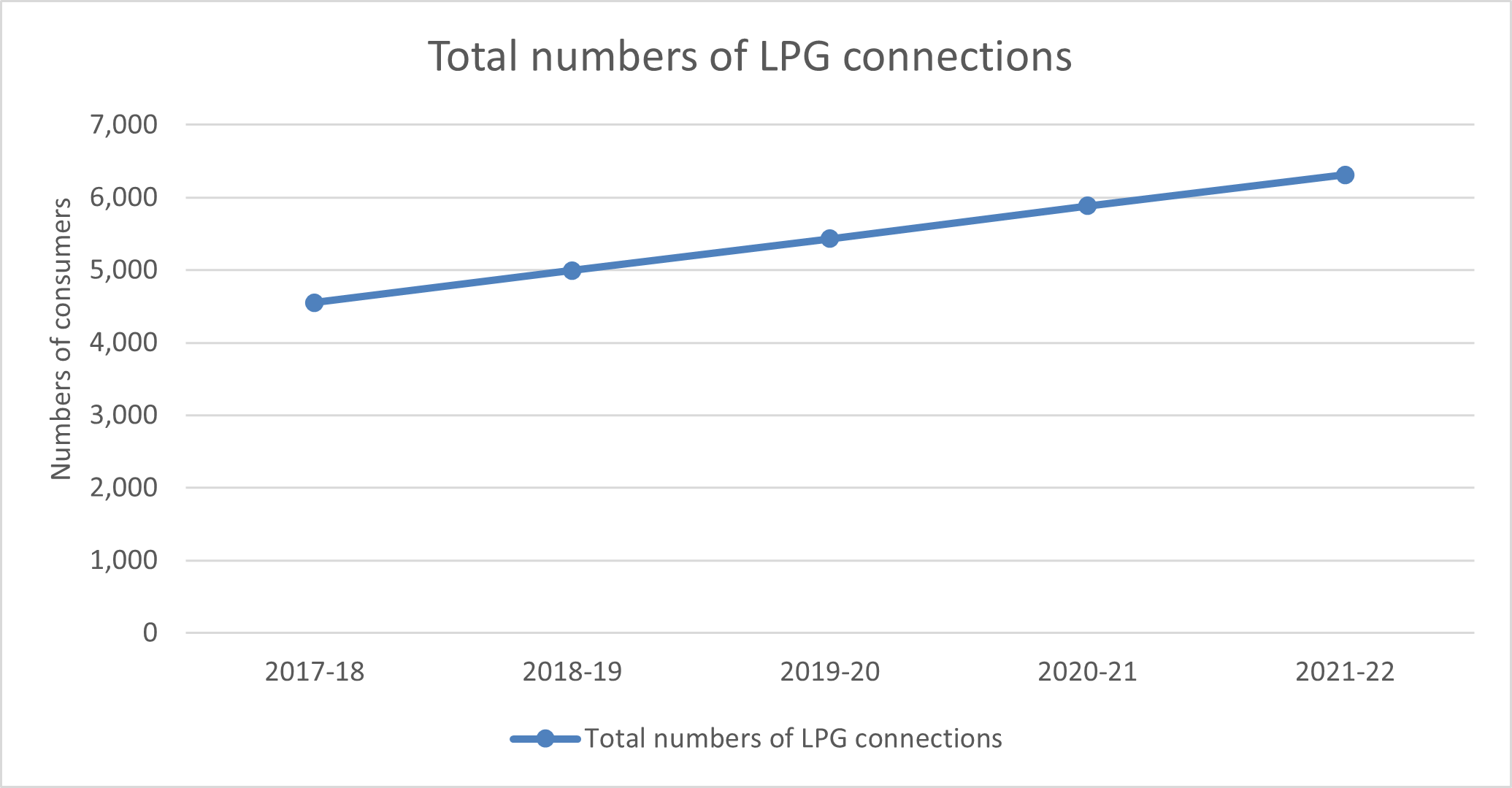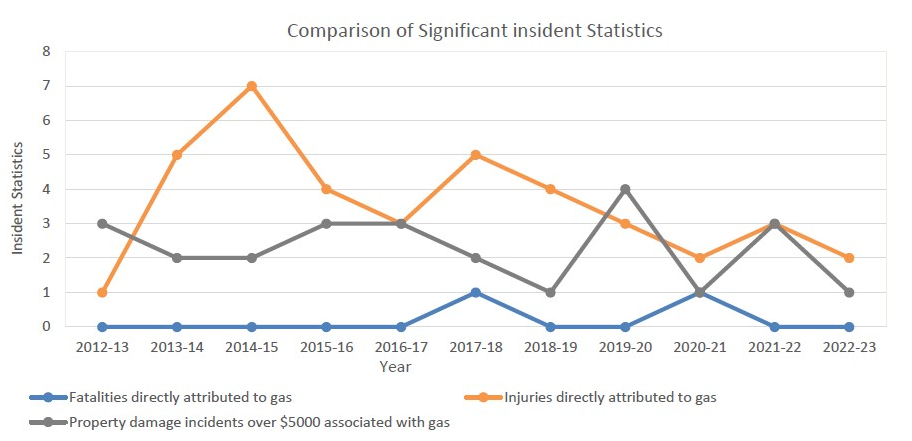TECHNICAL REGULATOR SOUTH AUSTRALIA
Level 8, ANZ Building
11 Waymouth Street, Adelaide SA, 5000
GPO Box 320, Adelaide SA, 5001
www.sa.gov.au/otr
Contact phone number: Robert Faunt (08) 8226 5500
Contact Facsimile: (08) 8226 5529
Contact email: DEMOTRMail@sa.gov.au
ISSN: 1832-8687
Date presented to Minister: 29 September 2023
Annual Report of the Technical Regulator 2022-2023
This document describes the operations of the Technical Regulator in the electrical, gas, plumbing and water industries.
The Technical Regulator is a statutory office established by:
- Section 7 of the Electricity Act 1996;
- Section 7 of the Gas Act 1997; and
- Section 8 of the Water Industry Act 2012.
Robert Faunt has held this office since he was appointed as the Technical Regulator under the Electricity Act 1996 and the Gas Act 1997 on 28 February 2003, and since he was appointed as the Technical Regulator under the Water Industry Act 2012 in 2012.
Note: All photographs in this report have been used with the permission of the relevant provider.
To:
Honourable Tom Koutsantonis MP
Minister for Energy and Mining
This annual report will be presented to Parliament to meet the statutory reporting requirements of Electricity Act 1996 (Sec 14), Public Sector Act 2009 and the requirements of Premier and Cabinet Circular PC013 Annual Reporting.
This report is verified to be accurate for the purposes of annual reporting to the Parliament of South Australia.
Submitted on behalf of the OFFICE OF THE TECHNICAL REGULATOR by:
Rob Faunt
Technical Regulator
Date 29 September 2023
Contents
Annual Report of the Technical Regulator 2022-2023
THE OFFICE OF THE TECHNICAL REGULATOR
General Activities of the Office of the Technical Regulator
Section 2: Technical and Safety Regulation
Section 3: Participation in Standards
Section 4: Emergency Management
Section 5: Consumer Safety Awareness
Section 6: Energy and Water Ombudsman SA
Volume I – Electricity Industry Preface
Section 7: Electrical Infrastructure
Section 8: Electrical Installation
Section 9: Electrical Products
Section 10: Electricity Regulatory Coordination
Volume II – Gas Industry Preface
Section 11: Gas Infrastructure
Section 14: Gas Regulatory Coordination
Volume III – Water Industry Preface
Section 15: Water and Sewerage Infrastructure
Section 16: Plumbing Installation
Section 17: Consumer Safety Awareness
Section 18: Water and Plumbing Regulatory Coordination
APPENDIX 1: OTR ACTIVITY REPORT – 2022-2023
Overall Activities for 2022-2023
Volume I – Electrical Industry
Section A2: Electrical Infrastructure
Section A3: Electrical Installations
Section A4: Electrical Products
Section A5: Electrical Safety Awareness
Section A6: Gas Infrastructure
Section A9: Gas Regulatory Coordination
Volume III – Water and Plumbing Industry
Section A10: Water and Sewerage Infrastructure
Section A11: Plumbing Installations
Section A12: Plumbing Products
Section A13: Regulatory Coordination
Volume IV – Key Performance Indicators
Appendix 3: Electronic Certificates of Compliance Form
Appendix 4: Electrical Products
A4.1. Proclaimed Electrical Products
Appendix 5 Electrical definitions, formulas and units
A5.2. Performance Indicator Definitions
A5.3. Performance Indicator Formulae
Appendix 7: Scheme for Plumbing Certificates of Compliance
Appendix 8: Example of internal Drain as Constructed Drawing
Appendix 9: Plumbing Code within the regulatory framework
Appendix 10: Water Industry Entities and licences
Appendix 11: Glossary and Abbreviations
List of Figures
Figure 1: Example of Regulation Roundup
Figure 2: Example of safety awareness campaign advertisements
Figure E 1: Non-compliant electrical installation at a major event
Figure E 2: Boundary of installations from products
Figure E 3: Regulatory Compliance Mark
Figure E 4: Example of approval labelling for an OTR (S marking) approved product – wall switch
Figure E 5: Example of the RCM approval labelling symbol for an approved product – desk lamp
Figure E 6: Example of approval labelling for regulatory authority NSW Fair Trading – laptop charger
Figure E 7: Example of an electrical product failure
Figure E 8: Example of an electrical product failure
Figure E 9: Incident due to user not observing the warning instructions
Figure G 1: Southern and eastern Australian gas fields and major pipelines
Figure G 2: The APA Group emergency/gas leak reporting number (1800 GAS LEAK – 1800 427 532)
Figure G 3: HDPE mains replacement
Figure G 4: Gas storage tank compound
Figure G 5: New Air Dryer (Type B appliance) undergoing commissioning and Type B testing
Figure G 6: Preowned resin sand dryer (Type B appliance) undergoing modifications and installation
Figure G 7: Example of gas e-audit form
Figure G 8: Example of a damaged gas hose on a temporary cooking setup at an outside event
Figure G 9: Example of non-compliant portable generators
Figure G 10: Example of a communal cooking facility at a caravan park that required modification
Figure G 11: Examples of LPG effect fires used at outdoor events
Figure G 12: Gas BBQ fire due to gas leaking from the high-pressure POL connection
Figure G 13: House fire because of an incorrect DIY appliance installation
Figure G 14: Certification Label Examples
Figure G 15: Information Data Plate including certification number, warning, and certification label
Figure G 16: Information Data Plate including certification number and certification label
Figure W 1: Split between services provided by water industry entities in South Australia
Figure W 2: Plumbing categories that are monitored and regulated through on-site audits by the OTR
Figure W 3: Details of plumbing obligations under the Water Industry Act 2012
Figure W 4: Examples of Plumbing and Drainage Installations in residential developments
Figure W 5: Commercial Drainage Installation
Figure W 6: New Royal Adelaide Hospital under construction
Figure W 7: Technical Regulator audit of inground fire system
Figure W 8: Areas of metropolitan Adelaide with non-drinking water
Figure W 9: example of non-drinking water signage
Figure W 11: Drinking and non-drinking water meters
Figure W 12: Plumbing installation showing in-wall non-drinking and drinking water pipework
Figure W 13: Fire Service Installation with Backflow Prevention Device
Figure W 14: Variation to a standard fire hydrant booster service
Figure W 15: Reduced Pressure Zone Backflow Devices in in-wall stainless steel tundish box
Figure W 16: Example of a section of a backflow management template
Figure W 17: Examples of Plumbing Advisory Notes
Figure W 18: Training session conducted by the OTR plumbing section at Tonsley TAFE
Figure W 19: NCC Compliance Structure
Figure A1- 1: Electronic Certificate of Compliance Submission Rates by Industry
Figure A1- 2: Survey participants recalled seeing or hearing Consumer campaign for 2023
Figure A1 E 1: Visy Board Solar and BESS equipment
Figure A1 E 2: State-wide Unplanned SAIDI for SA (minutes per customer)
Figure A1 E 3: Contribution to State-wide SAIDI for SA (minutes per customer)
Figure A1 E 4: Shock Report for 2022-2023 by Recipient Category
Figure A1 E 5: Shock Report for 2022-2023 by Translated Cause Category
Figure A1 G 1: Total gas usage and usage for power generation in 2021-2022 and 2022-2023
Figure A1 G 2: Natural gas delivered to the SA in 2022-2023
Figure A1 G 3: Trend in the quantity of gas entering the distribution system over the last 10 years
Figure A1 G 4: Numbers of consumers in the natural gas distribution networks over the past 10 years
Figure A1 G 5: Overdue gas meters over the past 8 Financial years
Figure A1 G 6: Numbers of public reports of gas leak and UAFG
Figure A1 G 7: Total numbers of LPG consumers over the past 5 financial years
Figure A1 G8: New natural gas connection and reticulation LPG connection the past 5 years
Figure A1 G 9: Bolivar Power Station
Figure A1 G 10: Thomas Foods Industries
Figure A1 G 11: Photo of a Type B powder coat oven
Figure A1 G 12: Photo of a Type B steam boiler
Figure A1 G 14: Failed outlet service
Figure A1 G 15: Non-compliant HWS location
Figure A1 G 16: Non-compliant installation appliance not commissioned
Figure A1 G 17: Investigations and Expiation Notices
Figure A1 G 18: Rotary salt dryer involved in incident
Figure A1 G 19: Deep fryer and open-end hose assembly involved in explosion incident
Figure A1 G 20: Recreational outdoor model water heater involved in explosion incident
Figure A1 G 21: Outdoor portable wok burner and damaged POL connector involved in explosion incident
Figure A1 G 22: Comparison of Significant Incident Statistics
Figure A1 G 23: Gas electronic certificate of complaint submitted over the last two financial year
Figure A1 W 1: Plumbing Certificates of Compliance statistics
Figure A1 W 2: Metropolitan on-site plumbing installation audits for 2022-2023
Figure A1 W 3: Regional on-site plumbing installation audits for 2022-2023
Figure A1 W 4: Fire service and non-drinking water audits for 2022-2023
Figure A1 W 5: 2023 Roadshow Seminar Topic
Figure A1 W 6: PIR monthly statistics for 2022-2023
List of Tables
Table E 1: Scheduled Generation with nameplate capacity exceeding 50 MW operation in 2022-23
Table E 2: Grid scale energy storage facilities with a capacity exceeding 20MW
Table E 3: Semi-Scheduled and Non-Scheduled renewable Generation with capacity exceeding 20 MW
Table E 4: ElectraNet transmission network length
Table E5: Distribution network length at May 2023
Table G 1: LPG distribution networks in South Australia as of 30 June 2023
Table W 1: Licence classifications
Table W2: Water industry entities per region in South Australia
Table A1- 1: Electronic Certificates of Compliance statistics as of 30 June 2023
Table A1 E 1: Numbers and Percentage of Shock Report by Recipient Category
Table A1 E 2: Numbers and Percentage of Shock Report by Translated Cause Category
Table A1 G 1: Overview of natural gas delivered to the South Australia
Table A1 G 2: Overview of natural gas delivered to the State
Table A1 G 3: Annual quantity of gas entering AGN’s SA networks (including Farm Taps)
Table A1 G 5: Overdue Gas Meters in 2020-2021, 2021-2022 and 2022-2023
Table A1 G 6: Data reported by the APA group over the last five financial years
Table A1 G 7: LPG distribution networks under development in South Australia
Table A1 G 8: New or modified installations and connections
Table A1 G 9: Results of installation auditing
Table A1 W 1: Number of SRMTMPs received, reviewed and approved
Table A1 W 2: Number of audits undertaken in per type of services
Table A1 W 3: Number of audits undertaken per type of licence
Table A1 W 4: On-Site Plumbing Audits 2022 – 2023
Table K 1: ElectraNet Key Performance Indicators
Table K 2: SA Power Networks Key Performance Indicators
Table K 3: APA Group’s Key Performance Indicators
The Office of the Technical Regulator
General Activities of the Office of the Technical Regulator
Overall Activities
Section 1: Overall Background
The Office of the Technical Regulator (OTR) assists the Technical Regulator in the performance of his functions and the exercise of his powers under the Electricity Act 1996, the Gas Act 1997 and the Water Industry Act 2012 (the Acts).
The Technical Regulator is responsible to the South Australian Government for the safety and technical performance of the electrical, gas, and water industries. The Technical Regulator also works towards ensuring community safety by promoting and enforcing safety measures and Standards across electrical, gas and plumbing appliances, installations, and infrastructure. To fulfil this responsibility, the Technical Regulator carries out an extensive range of activities, including but not limited to providing technical and safety education and advice, incident inspection and investigation activities and audit activities.
The Technical Regulator plays an important role in the development and monitoring of applicable state and national safety and technical Standards and Codes. The Technical Regulator provides technical support and advice on issues to the relevant Ministers and facilitates discussions with industry stakeholders to achieve the best possible outcome for South Australia.
Appendix 1 of the document presents specific results achieved during the last financial year. The flow chart in Appendix 2 summarises the activities through which the Technical Regulator fulfils his obligations under the various Acts and Regulations.
Section 2: Technical and Safety Regulation
The technical and safety regulation regime is in accordance with the Acts and includes the following components.
2.1. Technical Review of Infrastructure Licence Applications
The Essential Services Commission of South Australia (the Commission) licenses entities under the Acts, and provides the following licences:
- A licence authorising the generation of electricity or the operation of a transmission or distribution network.
- A licence authorising the operation of a gas distribution system.
- A licence authorising the provision of water and/or sewerage retail services.
Entities that have applied for and received a licence exemption may not be exempted from their responsibilities to the Technical Regulator under the Acts.
All licensing requirements can be found on the Commission’s website. Licence applications to the Commission must include organisational, commercial, and technical information. Technical information is referred to the Technical Regulator for review, and a response is provided to the Commission for consideration during their licence application assessment.
2.2. Safety, Reliability, Maintenance and Technical Management Plan
The Technical Regulator may or will, depending upon the Act, require the entities licensed by the Commission to prepare and periodically revise a Safety, Reliability, Maintenance, and Technical Management Plan (SRMTMP).
A SRMTMP is a high-level document relating to safety and technical requirements and which defines key performance indicators to measure the actual performance of an entity. It provides an auditable quality approach to industry safety and technical performance, encouraging the continuous improvement of safety systems and technical compliance.
The SRMTMP addresses issues relating to the technical Standards, operating and maintenance procedures and management practices, including safety requirements, applicable to an entity. The SRMTMP demonstrates how the entity will comply with the direct requirements of the legislation as well as the Standards and Codes called up by the legislation.
The overall information that a SRMTMP must address is defined in the Electricity (General) Regulations 2012, the Gas Regulations 2012, and the Water Industry Regulations 2012 (the Regulations). Guidance documents and general information for preparing SRMTMPs are also available on the OTR website to assist entities.
The Technical Regulator reviews an entity’s SRMTMP and, where appropriate, provides direction and makes recommendations or comments to assist in refining it before its final approval. The Technical Regulator is directly responsible for the approval of the SRMTMP for the three industries: electricity, gas, and water.
2.3. Audits of Compliance
2.3.1. Infrastructure internal audits
Following the submission and subsequent approval of a SRMTMP, an entity must complete annual internal audits which confirm compliance with its SRMTMP. Those internal audits can be completed by the entity itself or by a third party. Any findings from the internal audits are reported to the Technical Regulator for review and comments.
Once the Technical Regulator is satisfied that the entity has addressed all identified issues and complied with its SRMTMP, the entity then updates the plan to include required changes identified in the audit and any recommendations from the Technical Regulator.
2.3.2. Infrastructure audits by the Technical Regulator
In addition to the entity’s annual internal audits, the Technical Regulator completes independent safety and technical audits to verify the accuracy of information provided in, and compliance with, an entity’s SRMTMP. These audits ensure that safety and technical Standards are maintained in the electrical, gas and water industries by confirming that:
- Appropriate systems and processes have been developed.
- Compliance with these systems and processes is maintained.
- The systems and processes comply with entity’s current approved SRMTMP.
The Technical Regulator conducts both field and desktop audits to confirm that the entity is operating in accordance with its policies and procedures which ensure the safe and reliable operation of the infrastructure. Upon completion of an audit, the Technical Regulator provides the entity with a report of observations and provides comments and/or recommendations.
Audits completed by the Technical Regulator also allow for the monitoring of technical safety and reliability trends within the electrical, gas and water industries and comparison to other National and Global industries.
2.3.3. Installations compliance audit
The Technical Regulator has a process in place whereby electrical, gas and plumbing domestic, commercial, and industrial installations are monitored for compliance with the Acts, Regulations, and relevant Standards.
Periodic (seasonal, recurring, and ongoing) events are monitored to ensure the safety of the public and workers at the event in relation to the temporary and permanent electrical, gas and plumbing equipment and installations. This is often done in conjunction with other relevant Authorities such as SafeWork SA or Consumer and Business Services.
2.4. Incidents Investigations
2.4.1. Infrastructure incidents
Infrastructure incidents that involve death, injury to a person which requires medical assistance, property damage or any critical infrastructure failure must be reported to the Technical Regulator under the Electricity Act 1996 and the Gas Act 1997. Water infrastructure incidents shall also be reported to the Technical Regulator under a specific incident protocol. Incident reports are recorded by the Technical Regulator and, where appropriate, the incidents are investigated.
During major consumer outages and incidents, the Technical Regulator monitors the outage and assesses the adequacy of the response. This provides a level of confidence that the operational and maintenance strategy employed by the service providers is effective.
2.4.2. Installation incidents
Installation incidents are where an appliance or its installations is directly attributed to the cause of human death, injury or property damage. The Regulations require these events to be reported within specific time frames depending on severity.
These events are investigated by the Technical Regulator to determine the cause, often in conjunction with other relevant authorities or organisations, such as the Metropolitan Fire Services (MFS), Country Fire Service (CFS), SA Police (SAPOL), SafeWork SA, and insurance companies. Incidents reported to the Technical Regulator are investigated and recorded. OTR personnel may be called as witnesses in any subsequent legal action.
2.4.3. Electronic Certificate of Compliance
Certificates of Compliance are provided to property owners by an appropriately licensed person to demonstrate that they have met their duty to ensure that the electrical, gas fitting or plumbing works completed at their property is compliant. See Appendix 3 for an example of an electrical, gas and plumbing electronic Certificate of Compliance. The purpose of the certificate is to:
- Enable self-certification of work.
- Describe the works that have been completed.
- Assure the customer that the work is installed and tested to the appropriate Standard.
- Protect the licensed person by confining the responsibilities to the work that they have carried out.
- Allow the Technical Regulator to audit installations for adherence to safety and technical Standards.
The OTR has transitioned from the previous paper-based process for electrical, gas and plumbing Certificates of Compliance to an automated electronic system called electronic Certificates of Compliance (eCoC).
The eCoC system is free for electrical, gas and plumbing contractors and workers, and enables them to complete, submit, store and refer to Certificates of Compliance online. Contractors and workers can access the eCoC system via the internet from desktop and mobile devices. A one-time registration needs to be completed to use the eCoC system. Contractors and workers need to provide a professional registration/licence number and expiry date as well as an email address, a password and contractor/worker details.
Overall, the system is considered more flexible, being on a digital form, and more professional, with continuous improvements are brought to the platform based on the feedback received from users. Any feedback on the system can be sent to otr.ecoc@sa.gov.au.
More information and updates on the eCoC project can be found on the OTR eCoC website.
2.5. Technical Advisory Committees
Under the Acts, the Technical Regulator must establish an advisory committee (technical advisory committee) for each industry, including representatives of industry entities, contractor and employee associations involved in the industry, and local government.
The objective of these committees is to provide advice to the Technical Regulator, either on their own initiative or at the request of the Technical Regulator, on any matter relating to the functions of the Technical Regulator.
Section 3: Participation in Standards
The Technical Regulator is actively represented on several Australian Standards and joint Australian and New Zealand Standards Committees, the Australian Building Codes Board’s Plumbing Code Committee and International Standards. Committees relate to electrical, plumbing and gas products, design, installation and commissioning of electrical installations, gas installations, on-site plumbing installations, and design, operations, and maintenance of electrical, gas and water infrastructure.
Section 4: Emergency Management
The Technical Regulator works closely with relevant emergency management stakeholders to assist in ensuring the resilience of the State in case of an energy emergency, including the State Emergency Management Committee, SA Police, the Australian Energy Market Operator (AEMO) and major SA energy entities. When required, the OTR has several staff members available to be rostered with the State Emergency Centre (SEC) to provide electricity, gas and fuel supply monitoring and engineering service advice during a state emergency.
The Technical Regulator plays a key role in the monitoring of the security of the power system in South Australia. The Technical Regulator works with the Bureau of Meteorology (BOM), and stakeholders within the electricity generation, transmission and distribution industries, to ensure that appropriate precautions are taken during times when there is a risk to the power system (i.e. large storm systems, bushfires, extreme temperatures, etc).
During times when the load in South Australia may not be forecast to be balanced by electricity generation, the Technical Regulator may seek voluntary load reduction from large energy users across several industries. The Technical Regulator also manages the South Australian Electricity Manual Load Shedding List (the list) in cooperation with SA Power Networks as the distribution network service provider, ElectraNet as the transmission network service provider, and AEMO as the electricity market operator.
The list sets out the electrical circuits which should be tripped if AEMO instructs to reduce load to maintain the power system’s security and integrity. The preparation of the list is an obligation on the Technical Regulator under the National Electricity Rules in his role as the Jurisdictional System Security Coordinator for South Australia.
The Technical Regulator also has the responsibility to assess and monitor any threatening situations in relation to gas supply and is required to manage an emergency where societal objectives can no longer be met by the market. Should an event occur, normally the Short-Term Trading Market (STTM) for gas would be the first line of defence in managing any shortfall. The STTM is operated by AEMO and sets a daily price at each gas hub. It runs once a day, for the day ahead, for each hub. It utilises bids, offers, and forecasts as submitted by the participants and the pipeline capacities to determine the schedules for the deliveries of gas. The STTM also operates a contingency gas market should gas supplies fall short of the estimated daily demand.
The use of the contingency gas market will extend the use of market outcomes. AEMO may also implement the Gas Supply Guarantee process to make gas available to meet peak demand periods in the National Electricity Market. If the shortfall is not resolved, the Technical Regulator would consider recommending that the Minister issue directions for temporary gas rationing.
Section 5: Consumer Safety Awareness
5.1. Assistance with the Development of Technical Training Courses
The Technical Regulator continues to liaise closely with Consumer and Business Services (CBS), TAFE SA and PEER Vocational Education, Employment and Training (VEET) about tradespeople training curriculums and competencies (CBS regulates the licensing of tradespeople under the Plumbers, Gas Fitters and Electricians Act 1995).
Tailored safety presentations are given to apprentice groups at registered training organisations across the State. Presentations are also given to other groups such as professional associations and contractor groups on request.
5.2. Industry Roadshows
A key initiative of the OTR is Industry Roadshows where presentations are provided to electrical, gas and plumbing workers and contractors across South Australia.
Roadshows are provided at all major population centres annually, and other regional areas less frequently, such as bi-annually, and are typically held in conjunction with industry associations. Roadshows provide an opportunity to share updates in electrical, gas and plumbing Standards and legislation, and obtain feedback from the industry.
5.3. Regulation Roundup
To keep the electrical, gas and plumbing industry informed, the Technical Regulator publishes a bi-annual joint electrical/gas/plumbing industry newsletter – Regulation Roundup. Regulation Roundup is dispatched electronically to contractors and workers.
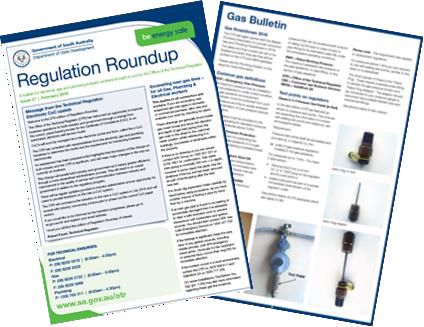
Figure 1: Example of Regulation Roundup
5.4. Continuous Safety Promotion
5.4.1. Proactive awareness campaign
The ‘Be Energy Safe’ Campaign is facilitated by the Technical Regulator and reviewed annually. Its objective is to promote safety to the community by raising awareness of electrical, gas, and plumbing safety and influencing the public to take the appropriate actions. The campaign involves the provision of messages which are promoted via advertising on the rear of public transport buses, on social media and during traffic reports on the radio.
Previous key messages included:
- Carbon monoxide (CO) awareness – do not bring outdoor gas appliances indoors – service your appliance regularly.
- Gas leaks should be reported via the Gas Emergency and Leak Reporting Service on 1800 GAS LEAK (1800 427 532).
- Plumbing, gas and electrical jobs should be done by a licensed person – not DIY.
- Plumbing, gas and electrical works should come with a Certificate of Compliance.
- Barbecues should be serviced regularly to prevent gas leaks.
- A safety switch should be tested twice a year.
- Christmas lights should be checked for faults prior to being used.
- Avoid scalding from hot water.
The campaigns are published by an advertising company and performance reports are provided regularly to the Technical Regulator to monitor the rate of penetration of the advertisements. Overall, the campaign is considered to achieve fair results. Some examples of the advertisements are shown in the figure below.

Figure 2: Example of safety awareness campaign advertisements
5.4.2. Reactive awareness campaign
Reactive safety awareness campaigns are undertaken by the Technical Regulator and usually take the form of a single or series of media releases around the topic of interest. Typically, this type of campaign is the result of an incident and ensures that the public receives correct and appropriate safety information.
5.4.3. OTR’s Website
The OTR’s website includes current content on technical regulation and safety issues at:
- All technical information for Office of the Technical Regulator | Energy & Mining (energymining.sa.gov.au)
- Consumer information for gas, electricity and hot water safety.
5.5. Consumer Safety Survey
Every year, the Technical Regulator conducts a consumer safety survey to ascertain the public’s knowledge of gas and electrical safety, and the effectiveness of the OTR’s education campaigns and legislative functions. The survey is performed by an external contractor using computer assisted telephone interview and online surveys. Over the last three years, approximately 400 online surveys were conducted, with two-thirds located in the Adelaide metropolitan area and one-third in SA regional areas. Questions used for the survey remain consistent to provide comparisons to previous results.
Section 6: Energy and Water Ombudsman SA
There is a Memorandum of Understanding (MOU) in place between the Technical Regulator and the Energy and Water Ombudsman SA (EWOSA). The MOU defines how the two bodies will interact to deal with customer complaints.
The EWOSA seeks the Technical Regulator’s advice on some occasions. Advice may be sought on customer complaints received by the EWOSA that has resulted from the customer not being satisfied with the responses from the electricity entities. The technical input provided by the Technical Regulator assists the EWOSA in assessing a range of complex issues.
Volume I – Electricity Industry Preface
This volume covers the Technical Regulator’s operations under the Electricity Act 1996 and the Technical Regulator’s administration of the Energy Products (Safety and Efficiency) Act 2000.
Electricity Act 1996
Section 3 of the Electricity Act 1996 states that:
“The objects of this Act are—
(a) to promote efficiency and competition in the electricity supply industry; and
(b) to promote the establishment and maintenance of a safe and efficient system of electricity generation, transmission, distribution and supply; and
(c) to establish and enforce proper standards of safety, reliability and quality in the electricity supply industry; and
(d) to establish and enforce proper safety and technical standards for electrical installations; and
(e) to protect the interests of consumers of electricity.” Section 8 of the Electricity Act 1996 states that:
“The Technical Regulator has the following functions:
(a) the monitoring and regulation of safety and technical standards in the electricity supply industry; and
(b) the monitoring and regulation of safety and technical standards with respect to electrical installations; and
(c) the administration of the provisions of this Act relating to the clearance of vegetation from powerlines; and
(ca) the monitoring and investigation of major interruptions to the electricity supply in the State and the provision of reports relating to such interruptions in accordance with any requirements prescribed by the regulations; and
(d) any other functions prescribed by regulation or assigned to the Technical Regulator by or under this or any other Act.”
Energy Products (Safety and Efficiency) Act 2000
The Energy Products (Safety and Efficiency) Act 2000 makes provisions relating to the safety, performance, energy efficiency and labelling of products powered by electricity, gas or some other energy source.
Section 7: Electrical Infrastructure
7.1. Electricity Supply
7.1.1. Ensuring safety within the Electricity Supply Industry
Public Safety
Public safety is achieved under the Electricity Act 1996 through:
- The prescription of safe distances between powerlines and structures or vegetation.
- The prescription of safe working distances in proximity to powerlines, which vary depending on the voltage of the powerlines, the type of activity being performed, and the risk assessment being considered by the worker.
- The prescription of technical safety.
Safe Work Practices
The safety of electrical workers is regulated by the Work Health and Safety Act 2012. Accidents are required to be reported in accordance with regulation 70 of the Electricity (General) Regulations 2012.
The Electricity Act 1996 and the Electricity (General) Regulations 2012 set out requirements related to the safety of electricity infrastructure, including monitoring through SRMTMPs and also of electrical installations. Safety performance is measured against nationally accepted benchmarks and expressed as:
- Lost Time Injuries – the number of injuries resulting in more than one working day lost.
- Medical Treatment Injuries – the number of injuries requiring medical treatment. Electricity entities provide these indicators as part of their annual reporting to the Technical Regulator.
Live Powerline Work Safety
The Electricity (General) Regulations 2012 prescribe safety procedures and processes to be employed while working on or near live powerlines. A person who wants to perform high voltage live line work must complete an appropriate training course. The content of that course and the training provider must be approved by the Technical Regulator.
Currently, seven training providers have obtained Technical Regulator approval:
- SA Power Networks Skill Enhancement Centre.
- Omaka Training (New Zealand).
- Transgrid.
- Serect — A Subsidiary of Electrité De France (Edf).
- Aeropower Pty Ltd.
- Powerline Training Pty Ltd.
- Enersafe.
Substation Work Safety
Substations are considered high risk areas. Prior to working in a substation, a worker must have the appropriate level of accreditation for access to the required areas and functions in the substations, complete an induction and follow safe access processes including compliance with work permit systems.
7.1.2. Major Generation
In South Australia, the major entities responsible for scheduled generation supply a total installed nameplate capacity of 3077.16 megawatts (MW). Natural gas is the source of fuel for the majority of these generators.
Table E 1: Scheduled Generation with nameplate capacity exceeding 50 MW operation in 2022-23
| Power Station | Fuel | Owner | Capacity (MW) |
|---|---|---|---|
| Angaston | Diesel | Snowy Hydro Ltd | 50 |
| Barker Inlet | Natural Gas Pipeline | AGL Barker Inlet Pty Ltd | 210 |
| Bolivar | Natural Gas Pipeline | Iberdrola Australia Energy Markets Pty Limited | 123.2 |
| Dry Creek GT | Natural Gas Pipeline | Synergen Power Pty Ltd | 156 |
| Hallett GT | Natural Gas Pipeline | EnergyAustralia | 276.86 |
| Ladbroke Grove | Natural Gas Pipeline | Origin Energy Power Limited | 80 |
| Mintaro GT | Natural Gas Pipeline | Synergen Power Pty Ltd | 90 |
| Osborne | Natural Gas Pipeline | Osborne Cogeneration Pty Ltd | 180 |
| Pelican Point | Natural Gas Pipeline | Pelican Point Power Limited | 529 |
| Port Lincoln GT | Diesel | Synergen Power Pty Ltd | 73.5 |
| Port Stanvac 1 | Diesel | Snowy Hydro Ltd | 57.6 |
| Quarantine | Natural Gas Pipeline | Origin Energy Power Limited | 234 |
| Snapper Point | Diesel | Port Adelaide Energy Pty Ltd | 154 |
| Snuggery | Diesel | Synergen Power Pty Ltd | 63 |
| Torrens Island B | Natural Gas Pipeline | AGL Energy | 800 |
| Total | 3,077.16 |
Reference: AEMO: NEM Generation Information July 2023
7.1.3. Energy Storage
South Australia’s generation mix also includes an increasing number of grid scale energy storage facilities.
Table E 2: Grid scale energy storage facilities with a capacity exceeding 20MW
| Power Station | Owner | Capacity (MW) |
|---|---|---|
| Dalrymple BESS | ElectraNet | 30 |
| Hornsdale Power Reserve | Hornsdale Power Reserve Pty Ltd | 150 |
| Lake Bonney BESS | Lake Bonney BESS Pty Ltd | 25 |
| Total | 205 |
Reference: AEMO: NEM Generation Information July 2023
7.1.4. Renewable Generation
South Australia’s generation mix also includes an increasing number of grid scale energy storage facilities.
Table E 3: Semi-Scheduled and Non-Scheduled renewable Generation with capacity exceeding 20 MW
| Power Station | Fuel | Capacity (MW) |
|---|---|---|
| Adelaide Desalination Plant | Solar | 24.72 |
| Bungala One | Solar | 135 |
| Bungala Two | Solar | 135 |
| Canunda Wind Farm | Wind | 46 |
| Cathedral Rocks | Wind | 62 |
| Clements Gap | Wind | 56.7 |
| Hallett 4 North Brown Hill | Wind | 132.3 |
| Hallett 5 The Bluff WF | Wind | 52.5 |
| Hallett Stage 1 Hallett Hill | Wind | 94.5 |
| Hallett Stage 2 Hallett Hill | Wind | 71.4 |
| Hornsdale Windfarm Stage 1 | Wind | 102.4 |
| Hornsdale Windfarm Stage 2 | Wind | 102.4 |
| Hornsdale Windfarm Stage 3 | Wind | 112 |
| Lake Bonney 1 Wind Farm | Wind | 80.5 |
| Lake Bonney 2 Wind Farm | Wind | 159 |
| Lake Bonney 3 Wind Farm | Wind | 39 |
| Lincoln Gap Wind Farm – Stage 1 | Wind | 126 |
| Lincoln Gap Wind Farm – Stage 2 | Wind | 86.4 |
| Mt Millar Wind Farm | Wind | 72.28 |
| Snowtown | Wind | 98.7 |
| Snowtown S2 | Wind | 270 |
| Starfish Hill | Wind | 33 |
| Tailem Bend | Solar | 108 |
| Waterloo Wind Farm | Wind | 130.8 |
| Wattle Point | Wind | 90.75 |
| Willogoleche Wind Farm | Wind | 119.36 |
| Total | 2540.71 |
Reference: AEMO: NEM Generation Information July 2023
7.1.5. Transmission
The electricity transmission system transports power from power stations directly to a series of sub-stations and switchyards, which in turn supply the distribution system and directly connected transmission customers. The major transmission entity in South Australia, ElectraNet, owns and operates a network of approximately 6,454 circuit kilometres of transmission lines. The network operates at nominal voltages of primarily 275 kilo-Volts (kV) and 132 kV with a smaller number of 66 kV lines as shown in Table E3.
Table E 4: ElectraNet transmission network length
| Voltage (kV) | Overhead (km) | Underground (km) |
|---|---|---|
| 275 kV | 2,733 | 26 |
| 132 kV | 3,188 | 0 |
| 66 kV | 21 | 3 |
The South Australian electricity transmission network is connected to Victoria through the Heywood and Murraylink interconnectors.
ElectraNet operates 98 substations. Substations included in the transmission network are primarily of outdoor construction and air insulated. The network includes some gas insulated metal clad switchgear. ElectraNet does not own all of the assets or land at a number of substations; these sites are shared with other electricity entities, primarily SA Power Networks, the operator of the distribution network.
A system monitoring and switching centre for the transmission network is located in Adelaide and includes Supervisory Control and Data Acquisition (SCADA) facilities to monitor system conditions at substations and to control equipment in the network.
The transmission system is the backbone of electricity supply in South Australia and is being maintained at a high level of reliability and availability. A number of thermal generators and wind farms are connected to the transmission network at various locations throughout the State.
Murraylink Transmission Company
The Murraylink Transmission Company Pty Ltd runs an inter-regional transmission service comprising two high voltage direct current cables 176 km in length between Berri in South Australia and Red Cliffs in Victoria. At both ends of the cable is a DC-AC converter station to connect Murraylink to the existing transmission systems in South Australia (at 132 kV) and Victoria (at 220 kV).
Murraylink is a bi-directional facility with a steady state transfer capability of 220 MW at the receiving end. It provides South Australian consumers with access to generation from Victoria and New South Wales at times of local peak loads or generation shortfall. During off-peak periods, Murraylink is able to export excess South Australian generation to Victoria and New South Wales consumers.
7.1.6. Distribution
In South Australia, the entity primarily responsible for electricity distribution is SA Power Networks which serves approximately 909,615 customers. There are a number of smaller distribution entities covering remote areas. Some of these areas were managed by SA Power Networks under contract for the reporting period. The electricity distribution network in South Australia covers more than 178,000 km2. The network extends across difficult and remote terrain and operates in demanding conditions and stretches for over 90,167km, and includes 400 zone substations, 74,885 street transformers, more than 647,000 Stobie poles and 200,000 km of overhead conductors and underground cables. Some distribution substations are within sites shared with ElectraNet.
Table E5: Distribution network length at May 2023
| Operating Voltage | Overhead (km) | Underground (km) |
|---|---|---|
| Low Voltage (<1,000Volts) | 18,472 | 14,656 |
| 11 kV (includes 7.6kV) | 17,881 | 4,331 |
| 19 kV (SWER) | 29,108 | 66 |
| 33 kV | 3,992 | 140 |
| 66 kV | 1,454 | 54 |
| 132 kV ¹ | 11 | 0 |
| Total | 70,920 | 19,247 |
¹ Licence modified to allow for 132 kV distribution assets
SA Power Networks Key Performance Indicators (KPIs)
SA Power Networks KPIs cover service and technical Standards and include supply interruptions, power surges and low and high voltage complaints. SA Power Networks reports its performance against these KPIs, with reliability and outage indicators on a quarterly basis and all other indicators on an annual basis. The Technical Regulator receives and reviews these reports and follows up on any technical issues, where deemed appropriate, to ensure that corrective action has been taken or is planned. This reporting process ensures that the Technical Regulator is kept informed of major outages and provides assurance that the reliability of electricity supply is being maintained or improved. These KPIs are included in Table K2 in Volume IV of Appendix 1.
7.2. Smarter Homes Program
Following advice from AEMO, a number of technical standards and requirements for smaller generators such as rooftop solar have been introduced in South Australia and are in effect as of 28 September 2020. These requirements include:
- Voltage ride though Standards for generating systems connected to the electricity network via an inverter.
- Remote disconnection and reconnection requirements.
- Dynamic export limit requirements.
- Smart meter minimum technical standards.
- Tariffs to incentivise energy use in low demand periods.
Implementation and ongoing administration of these requirements by the OTR helps to ensure the power system in South Australia remains safe and reliable.
7.2.1. Voltage Ride Though Standards
From 28 September 2020 any generator connected via a low voltage inverter to the SA Power Networks electricity distribution network must comply with undervoltage ride- through performance standards designed to mitigate impacts on the South Australian power system during disturbances. The investors are approved, tested in accordance with AS/NZS4777.2 by the Clean Energy Council (CEC) and are listed on CEC website.
7.2.2. Remote Disconnect and Reconnect
In addition to Voltage ride though, newly installed prescribed grid connected generating systems are required to be capable of being remotely disconnected and reconnected by a Relevant Agent registered with the Technical Regulator. A Relevant Agent is a party who has been authorised and appointed by the owner or operator of the prescribed electricity generating plant by written authorisation to manage the requirement on their behalf. As of the 30 June 2023, the office of Technical Regulator has assisted and approved 29 Relevant agents with a total 491,561 KW plant capacity under their control.
7.2.3 Dynamic Export Limit Requirement
New technical standards now require that prescribed generating systems connecting to the South Australian distribution network after 1 July 2023 are capable of being export limited and for export limits to be updated remotely. Together these concepts are referred to as Dynamic Exports and are being implemented via the SA Power Networks flexible exports program.
7.2.4. Smart Meter Minimum Technical Standards
As of 28 September 2020, the standard requires a smart meter to be capable of separately measuring and controlling an electricity generating plant and controllable load from essential load. Smart meters must be installed in accordance with the guidelines issued by the Technical Regulator and the meter installation is required to comply with the Technical Regulator Guideline - Smart Meter Minimum Technical Standard.
7.2.5. Tariffs to incentivise Energy
This requirement which is in effect as of 28 September 2020 applies to retailers' standing offers for customers with interval meters. This ensures retailers make offers that reward customers for using electricity in low demand periods. These will typically include a ‘time of use’ tariff, which incentivises energy use during the day while disincentivising energy use during the evening and overnight.
7.3. Safety Clearances to Powerlines
The Technical Regulator is responsible for the administration of the provisions of the Electricity Act 1996 relating to the safe clearance of buildings and structures, workers and equipment, and vegetation from powerlines.
Where there is a dispute relating to either vegetation or building clearances, the Technical Regulator strives to facilitate a sensible, safe and agreeable resolution that complies with the requirements of the legislation.
7.3.1. Vegetation Clearance
The Technical Regulator administers the Electricity (Principles of Vegetation Clearance) Regulations 2021 which include:
- The required clearance distances and the normal clearance cycle of vegetation.
- The list of species of vegetation which may be planted or nurtured near powerlines.
- Providing the occupiers of land an opportunity to lodge an objection in relation to vegetation clearance issues.
- Bushfire risk boundaries which dictate clearance distances between overhead powerlines and trees or other vegetation.
Risks associated with Vegetation near Powerlines
The risks directly associated with vegetation contacting powerlines include electric shocks, fire, damage to infrastructure and interruptions of supply. To protect people and property from these risks, clearance zones and buffer zones (which limit the amount of pruning of vegetation) and planting restrictions have been established under the Electricity (Principles of Vegetation Clearance) Regulations 2021.
In South Australia, a special case for concern is the risk of bushfires being started by overhead powerlines. This risk is principally managed through vegetation clearance, keeping flammable material well away from powerlines.
Vegetation Clearance Objections
Electrical entities conduct a periodic vegetation inspection at intervals of no longer than three years. In bushfire risk areas, annual inspections are conducted prior to the bushfire season. When an electricity entity identifies vegetation on private property as requiring trimming or removal, the entity is required to provide the owner or occupier with a 30-day notice of intention to enter the property to cut vegetation. The owner or occupier then has 21 days after receiving the notice to lodge a written notice of objection with the Technical Regulator. The Technical Regulator holds regular meetings with SA Power Networks and Active Tree Services’ management throughout the year, to discuss any disputes or other matters regarding vegetation near powerlines, which had come to the attention of the Technical Regulator.
Vegetation Clearance Agreements
The Electricity Act 1996 makes provision for electricity transmission and distribution entities and Councils to enter into agreed vegetation clearance schemes under which vegetation clearance responsibilities may be conferred on a Council. A Council also may agree to pay for the cost of more frequent clearance in order to reduce the scale of a three-yearly pruning by the entity. There are currently no such agreements in place between any Council and SA Power Networks.
7.3.2. Building and Working Clearances
The Electricity (General) Regulations 2012 define the minimum clearances between buildings or structures and powerlines. Section 86 of the Electricity Act 1996 also gives the Technical Regulator power to grant an approval (subject to limitations as specified in the Electricity (General) Regulations 2012) for a building or structure to be erected within the prescribed clearance distances.
Risks associated with Buildings near Powerlines
Minimum building clearances are defined in the legislation to prevent electric shocks, damage to infrastructure or property, and to ensure the reliability of supply.
The Technical Regulator actively promotes awareness of these legislated distances within the construction industry by providing verbal and written advice and presentations, undertaking site assessments, and distributing information via brochures and the internet.
The Electricity Act 1996 makes provisions for an electricity entity to rectify identified breaches of minimum safety clearances and recover the costs by means of a court order.
Compliance with Building Clearances
The Office of the Technical Regulator worked with network operators, builders and other stakeholders to resolve numerous under construction and completed buildings found to be within the minimum building clearances defined in regulation.
Often these are resolved by costly modification of the electricity infrastructure – a large expense added to the cost of a building, highlighting the importance of proper planning when designing structures in proximity to powerlines and other electricity infrastructure.
Section 8: Electrical Installation
8.1. Regulatory Framework
The safety of electrical installations is mandated by the Electricity Act 1996 and the Electricity (General) Regulations 2012. This legislation defines the powers, rights and responsibilities of the various parties in relation to the safety of electrical installations. The Electricity (General) Regulations 2012 mandate compliance with AS/NZS 3000 – Wiring Rules as well as the technical installation rules of the network operator.
Key issues covered by the Electricity Act 1996 and the Electricity (General) Regulations 2012 include placing the responsibility for the safety of an electrical installation with the owner or operator of that installation, and the reliance on a Certificate of Compliance as a means of demonstrating that this responsibility has been met. Likewise, the person connecting the installation to the network (typically the network operator) can rely on the Certificate of Compliance to demonstrate they have met their obligation regarding the safety and compliance of the installation.
Occasionally, installations and appliances are deliberately misused by unlicensed persons involved in illegal activities, for example in the manufacture of illegal drugs.
8.2. Compliance Audits
Audits may be random or targeted. Targets for random audits are obtained from data such as lists of new connections and alterations such as solar installations supplied by network operators. Targeted audits are performed following complaints, concerns from past performance or intelligence gathered from the industry.
The Technical Regulator inspects electrical installations against requirements specified in AS/NZS 3002 for outdoor events due to their temporary nature, and the high levels of potential risk involved.
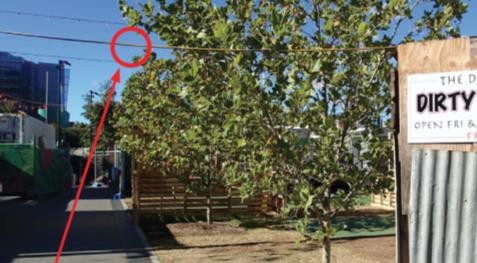
Figure E 1: Non-compliant electrical installation at a major event
The figure above shows the circled cable is too low, has no secondary support and is not flagged. Other specialist areas that are audited include recreational vehicles, caravan parks, boats and marinas, hazardous areas and patient areas.
8.3. Electrical Helpline
Electrical workers and contractors are encouraged to call the Technical Regulator for assistance with technical compliance matters. This proactive strategy helps the industry achieve compliance in a timely manner. The helpline is available 8am-4.30pm Monday to Friday.
8.4. Enforcement
The Technical Regulator has a range of enforcement options to deal with non-compliant electrical installation work and other breaches of the Electricity Act 1996.
8.4.1. Directives to make installation safe
An authorised officer can give a direction to make an electrical installation safe. This direction can be given to the owner or operator of the installation or to the person who performed the work. In some cases, this may also include disconnection of the installation until it is repaired and made safe to the satisfaction of the authorised officer.
8.4.2. Formal warnings
A formal warning can be given to the person responsible for breaching the Electricity Act 1996. If this is done verbally it is also confirmed in writing. Formal warnings provide a basis for additional enforcement activity should there be an escalation of the offence, in addition to establishing patterns of repeated non-compliance.
8.4.3. Expiation Notices
Expiation notices are issued for more serious breaches of the Electricity Act 1996. They are an administrative penalty that is intended to minimise the impacts on the courts and legal system caused by relatively minor offences. The issue of an expiation notice does not register a conviction against the alleged offender, and paying the expiation fee is not considered to be an admission of guilt. Expiation notices can be challenged in court by the alleged offender, who could then face the potential of a significantly higher penalty if found guilty.
8.4.4. Prosecution
The Technical Regulator may prosecute a person where the non-compliance is so serious as to constitute gross negligence or where the offender has a history of significant non-compliance.
The court will then decide the actual penalty up to the maximum stated in the Electricity Act 1996 or Electricity (General) Regulations 2012 should the person be found to have committed the offence or breach.
8.4.5. Suspension/cancellation of licenses
In cases of serious or consistent non-compliance, the Technical Regulator may refer a case to the Commissioner for Consumer Affairs (who is responsible for occupational licensing under the Plumbers, Gas Fitters and Electricians Act 1995) for action. This may result in the suspension or cancellation of a contractor’s licence or worker’s registration, or the imposition of conditions on that licence/registration.
Instances of electrical work performed by non-licensed/registered persons are also forwarded to the Commissioner.
8.5. Reporting of Electric Shocks
All incidents that result in electric shocks or burns must be reported to the Technical Regulator. In the case of death, this must be done immediately. If a person requires medical treatment it must be reported within one working day. All other instances must be reported within 10 working days.
This allows an appropriate time for the incident to be investigated. The Technical Regulator investigates electrical fatalities, usually in conjunction with SA Police. Other investigations are normally performed by registered electrical workers. Incident reports help prevent recurrences of the event and may result in enforcement action being taken. Statistical data from shock and incident reports also assist with resource allocation and scope for potential changes to electrical Standards.
Section 9: Electrical Products
The Energy Products (Safety and Efficiency) Act 2000 is administered by the Technical Regulator and requires that proclaimed classes of electrical products must comply with specified safety and performance Standards and be labelled to show compliance before sale (see Appendix 4).
Other Australasian jurisdictions have similar legislation. The Technical Regulator works with other Australasian Regulators and Standards Committees to ensure a nationally consistent electrical product safety regulatory regime.
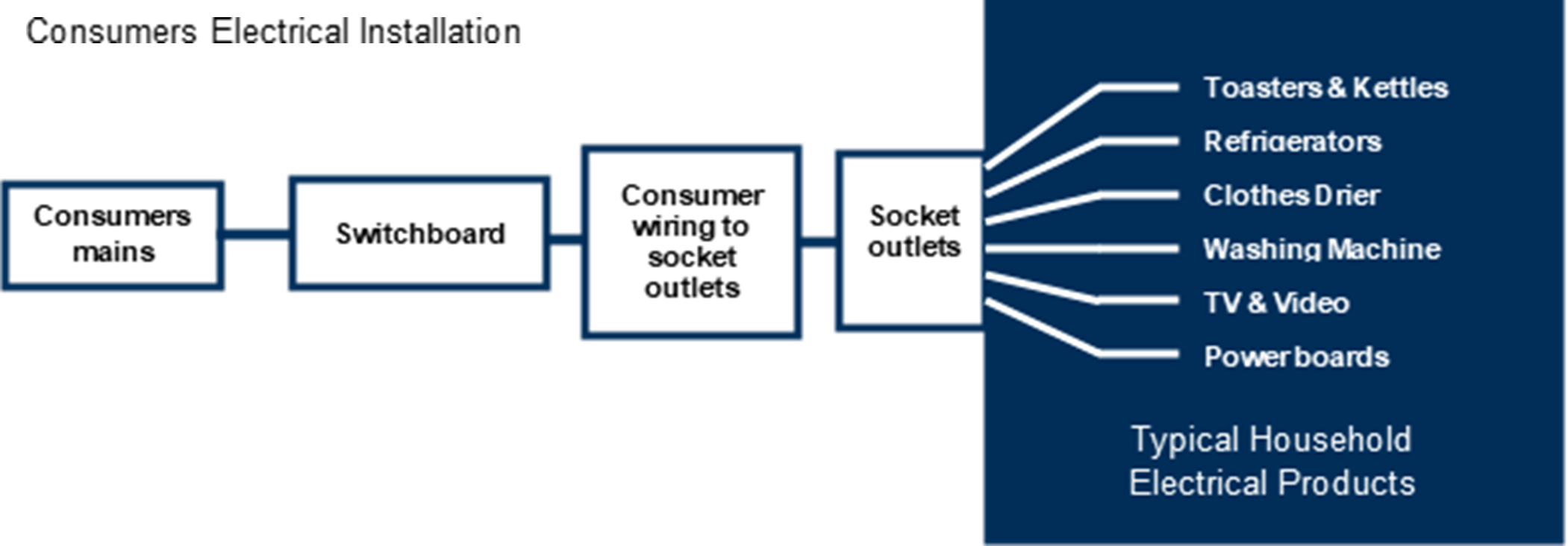
Figure E 2: Boundary of installations from products
An electrical product is any device that needs to be connected to the household electricity supply. This includes such items as white goods, power tools, portable household products, power boards, air conditioners and hot water services. It is estimated that the typical household has up to 50 electrical products.
The Technical Regulator investigates reports of breaches of the Energy Products (Safety and Efficiency) Act 2000. This can result in the issue of stop sale notices, public warning statements, product recalls, expiation notices or prosecution.
9.1. Role of the Technical Regulator
The Technical Regulator, in accordance with the Energy Products (Safety and Efficiency) Act 2000, grants electrical products safety labelling certificates and electrical product suitability certificates to applicants. The certificates are required to label electrical products to indicate their compliance with applicable Standards or certify their suitability to connect to an electricity transmission or distribution network before sale.
The Technical Regulator also follows up these products after sale, through field audits and product investigations, based on reported failures.
The Technical Regulator is represented on national regulatory and Standards committees, the aim of which is to ensure that regulators act in a coordinated manner throughout Australia and that the safety Standards impose a common, acceptable level of safety. These committees are listed in Section 10.2.
The Technical Regulator also provides technical advice to manufacturers and importers, the electrical industry, government agencies and emergency services.
9.2. Product Safety
9.2.1. Product Approval
There are 64 classes of products proclaimed under the Energy Products (Safety and Efficiency) Act 2000, which must comply with specified safety and performance Standards. This list has evolved over time, and typically includes household products that, in the past, have been involved in numerous fires and/or electric shock incidents and therefore represent a ‘high risk’ category. These products, which are covered by similar legislation in all Australian States, require pre-market approval and must carry an approval label to indicate their compliance with safety and performance Standards before they can be sold. Appendix 4 lists these proclaimed products.
9.2.2. Product Approval Safety Process
In South Australia, the current approvals process requires manufacturers or importers to submit samples of proclaimed products for testing at accredited laboratories to ensure their compliance with the applicable Australian/New Zealand safety and technical Standards. These Standards set down the basic requirements that the products must meet to be considered electrically safe. Typically, these requirements include levels of protection to guard against such things as unsafe construction, access to live parts, overheating from normal or abnormal operation and fire propagation.
Testing must be carried out in accordance with the relevant Standards by appropriate test laboratory facilities in Australia or overseas. In Australia, this means a testing facility that has National Association of Testing Authorities (NATA) accreditation. Evidence of compliance can then be submitted to the Technical Regulator or a private certifier, who will verify compliance and then issue a certificate. This certificate is generally valid for five years. When offered for sale, the product must carry the allocated approval marking. If issued by a State regulator or private certifier, the marking contains a letter identifying the State or certifier who approved it, followed by its allocated number (e.g. Victoria – ESVxxxxx, South Australia – S/xxx or OTRxxxxxx), private certifier marking (alpha numeral), or if AS/NZS 4417 (marking of electrical products to indicate compliance with regulations) is complied with, the Regulatory Compliance Mark (RCM) symbol as defined in that Standard as shown below.

Figure E 3: Regulatory Compliance Mark
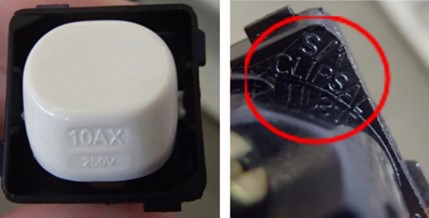
Figure E 4: Example of approval labelling for an OTR (S marking) approved product – wall switch
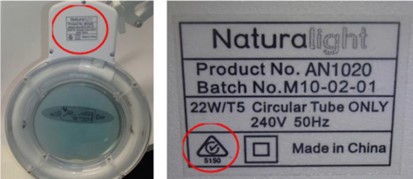
Figure E 5: Example of the RCM approval labelling symbol for an approved product – desk lamp
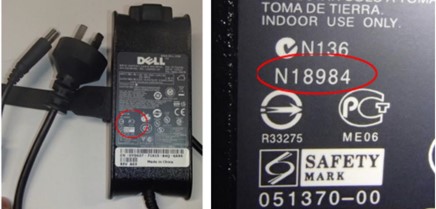
Each State in Australia recognises approvals issued by the other State authorities and product certifiers. There are also alternative private certifying bodies which have been recognised interstate, resulting in approval labelling other than that issued by a State
Regulator, with a consequent reduction in the number of products being approved by State authorities. The nature of the retail products industry is such that competitors quickly identify any unapproved items for sale and report them to the Technical Regulator, who is then able to take immediate action for breaches of the Energy Products (Safety and Efficiency) Act 2000.
9.2.3. Risks Due to Faulty or Misused Products
The risks associated with electrical products that have failed because of their design, or manufacture, or misuse by the consumer include:
- Personal injury (shocks).
- Electrocution (fatalities).
- Property damage (fires).
Manufacturers, importers and retailers also assume liability through the sale of electrical products for:
- Costs of recalls, replacement or repair of products.
- Costs of compensation claims.
- Loss of, or damage to, the organisation’s reputation.
Hazardous Products
Typical hazards found in faulty electrical products include:
- A breakdown of insulation due to overheating or mechanical damage, which may expose the consumer to the risk of electrical shock.
- Overheating of the product, which may result in fire or ignition of its surroundings, exposing consumers to the risk of injury or property damage.
- Mechanical failure, which may cause personal injury to the user.
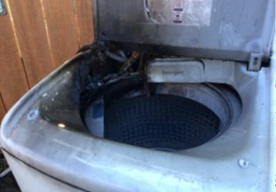
Figure E 7: Example of an electrical product failure
Figure E7 illustrates the consequences of a faulty electrical connection in a washing machine that overheated and caught fire.
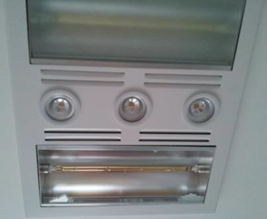
Figure E 8: Example of an electrical product failure
Figure E8 illustrates the consequences of a bathroom heater glass diffuser shattering whilst in use, resulting in the user receiving burns and cuts.
Products may also fail because of misuse by the consumer. Typical examples of this are:
- Incorrect securing of electric blankets resulting in folds that lead to overheating and fire.
- Unsafe placement of radiators and fan heaters adjacent to furniture and materials, resulting in fires.
- Continued use of electrical products with damaged bodies and cords, resulting in electrical shocks.
- Not having products checked after being subjected to an impact or falling from a height.
Figure E9 shows an example of brand new decorative LED rope lights that started to emit smoke and deform within minutes of use, as a result of the user not observing the warning instructions to remove the packaging.
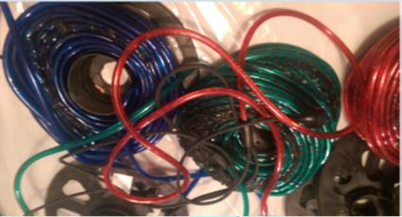
Figure E 9: Incident due to user not observing the warning instructions
In many cases, products are either incorrectly installed or operated by consumers who do not follow the manufacturer’s recommendations and instructions. The Technical Regulator alerts consumers and electricians to such risks through public warnings, the continuous development of information brochures, Regulation Roundup and education programs.
9.2.4. Product Failures and Corrective Actions
The Technical Regulator monitors the failures of electrical products. If necessary, action can be taken under the Energy Products (Safety and Efficiency) Act 2000 to remove any hazardous products from the marketplace. Depending on the severity of the failure, there are a number of options available to the Technical Regulator when assessing what action should be taken for specific situations including:
- Issuing an Incident Report – when the failure of a product has not directly resulted in a safety hazard. The report is circulated to all regulatory authorities throughout Australia and New Zealand for information and monitoring.
- Issuing a Hazard Alert – when the failure of a product has resulted in an immediate safety problem such as a reported electric shock. The notice is immediately circulated to all regulatory authorities including both State and Australian Government consumer affairs authorities for information and followed up by action with the trader as considered necessary.
- Issuing a Stop Sale – generally issued in conjunction with a Hazard Alert. The notice is circulated to all regulatory authorities including both State and Australian Government consumer affairs authorities for information and is followed up by action with the trader.
- Issuing a Recall – when a product already on the market has been identified as a safety hazard. This may warrant the issuance of a recall notice and result in a national public product recall conducted in accordance with Australian Competition and Consumer Commission (ACCC) guidelines.
9.2.5. Stop Sales
The Technical Regulator can issue Stop Sale notices to traders in South Australia as the situation warrants. An example of a situation requiring the seller to “Stop Sale” is when the product is proclaimed under the Energy Products (Safety and Efficiency) Act 2000, but is not marked with any approval labelling indicating that it is formally approved for electrical safety.
9.2.6. Mutual Recognition
Under a Mutual Recognition Agreement (MRA) between two or more jurisdictions, one jurisdiction is able to recognise a product approval issued by another.
Apart from the ‘corresponding laws’ recognised under the Energy Products (Safety and Efficiency) Act 2000, several mutual recognition schemes affect the Technical Regulator’s operations and those of other State Regulators.
Australian Mutual Recognition
The Mutual Recognition (South Australia) Act 1993 and the Mutual Recognition Act 1992 (Commonwealth) provide that, in principle, a product made in or imported into a State that can be lawfully sold in that State, may be lawfully sold in any other State. A label is required showing the place of manufacture or importation to enable a defence of mutual recognition to be established.
Trans-Tasman Mutual Recognition Arrangement (TTMRA)
The Trans-Tasman Mutual Recognition (South Australia) Act 1999 and the Trans- Tasman Mutual Recognition Act 1997 (Commonwealth) provide that, in principle, products made in or imported into New Zealand that may be lawfully sold in New Zealand, may also be lawfully sold in Australia. A label on the product is required showing the place of manufacture or importation to enable a defence of mutual recognition to be established.
The TTMRA has resulted in some products either manufactured in or imported into New Zealand being offered for sale in Australia without any identifiable approval marking as New Zealand law does not require such labelling.
9.3. Product Energy Efficiency
Energy labelling and Minimum Energy Performance Standards (MEPS) registrations are now regulated by the Australian Government’s Greenhouse and Energy Minimum Standards Act 2012 (GEMS legislation). The energy efficiency requirements of the Energy Products (Safety and Efficiency) Act 2000 are still applicable but in general terms have become redundant.
9.4. Industry Communication
There are only a few South Australian businesses (including manufacturers, importers and retailers) that submit electrical products to the Technical Regulator for approval. The Technical Regulator distributes newsletters and circulars to these businesses to keep them informed of changes to the Energy Products (Safety & Efficiency) Act 2000 and Australian Standards as necessary.
Section 10: Electricity Regulatory Coordination
10.1. Electrical Regulatory Authorities Council (ERAC)
National uniformity and consistency are extremely important to electricity utility operators, manufacturers, electrical workers, contractors and consumers. ERAC has representatives from all Australian States and Territories and New Zealand. It formally meets twice per year to address regulatory matters related to key technical and worker licensing issues facing the electrical industry and to develop national strategies to address these issues consistently.
Meetings are divided into five sessions, each with their own chairperson, covering general matters, electrical installations and inspection, electrical equipment safety, electrical licensing and electricity supply (network infrastructure).
ERAC works closely with Standards Australia to maintain and develop national Standards which in turn become State-based requirements when they are called up by legislation. The Technical Regulator, as a member of ERAC, actively participates in Standards development issues arising from ERAC meetings. The Technical Regulator also participates in a number of ERAC working groups to ensure that national developments take account of South Australian issues.
Uniform Standards are beneficial in that they provide for the movement of workers between regions and enable the development of Standards based on the experience of a wider group. The national Standards development process also supports the ongoing review and improvement of safety Standards in a transparent manner. ERAC has been active in setting the agenda for the progressive review and implementation of network safety Standards. This has included a Standard dedicated to safety issues associated with smart meters.
ERAC has been particularly keen to support the timely development of Standards which deal with matters that have a direct impact on the interface between the network industry and the public, such as powerline clearances.
Following its review of the regime for regulating electrical equipment safety in Australia, ERAC has recommended an updated system aimed at eliminating shock, injury and property damage resulting from the sale, supply and use of unsafe electrical equipment. ERAC has proposed that the new system should be underpinned by nationally consistent performance-based legislation in each jurisdiction and comprehensive scheme rules. It contains a mixture of pre-market registration based on third party safety assessment and post-market enforcement.
The system will be designed to take into account the changing character of the electrical appliance supply industry in Australia. The recommendations formed the basis of the Regulatory Impact Statement (RIS), released for public comment by ERAC. Following consideration of public submissions on the RIS and further industry consultation, a final RIS was endorsed by ERAC members. In order for a national scheme to be agreed and implemented, ERAC is in the process of developing an intergovernmental agreement (IGA) between all states and territories to gain Ministerial agreement to progress the scheme.
The then Ministerial Council on Energy (MCE) established the Energy Technical and Safety Leaders Group (Leaders Group). The Leaders Group was tasked with the development of a plan to achieve further harmonisation of State and Territory safety regulation for the electricity and gas supply industry.
The plan presented by the Leaders Group contains recommendations for achieving a harmonised national framework within which State and Territory energy supply industry safety and technical regulations could operate. The plan proposes an IGA as the central mechanism by which jurisdictions would commit to a series of overarching principles and objectives supporting harmonisation. The then MCE gave in-principle agreement to the recommendations contained in the plan as they apply to Energy Ministers’ portfolio responsibilities. The then MCE Ministers also agreed to work with related portfolio Ministers within their jurisdiction to progress the proposed IGA. The objective of the IGA is to create a nationally harmonised energy supply industry safety framework, to ensure enhanced public and industry safety, enhance worker mobility and contribute to the efficient delivery of energy network services. In particular, the IGA will formalise governments’ commitment to make necessary legislative or other changes to support the nationally harmonised safety framework for the energy supply industry. The IGA does not commit to the development of a model or applied legislation.
As part of the harmonised safety framework, the IGA commits participating jurisdictions to an ongoing work program in Standards development (such as the Australian Standard for Energy Network Safety Systems), operating safety rules and skills and training. This work would be supported by the Energy Supply Industry Safety Committee (ESISC), a non-statutory advisory body that provides advice, knowledge and expertise on the development and implementation of the nationally harmonised safety framework. In 2012, the Australian Government, States and Territories endorsed the IGA on Energy Supply Industry Safety by the signature of First Ministers. Under the IGA, the Australian Government and the State and Territory governments agree to put in place a nationally harmonised safety framework for the energy supply industry. The Terms of Reference (TOR) for the ESISC came into effect with the signing of the IGA. The TOR tasked ESISC to develop and implement a nationally harmonised safety framework for the energy supply industry.
The TOR requires that ESISC submit to the Energy Senior Officials Meeting for approval of the ESISC implementation plan for five years. This plan requires a progress update every 12 months on:
- Energy Network Safety Systems.
- Consistency with National Work Health And Safety.
- Consistency with National Occupational Licensing System Initiatives.
- Legislative And Regulatory Issues.
- Expanded National Refresher Training Recognition Protocol For The Electricity Supply Industry.
- Generation Harmonisation.
- Harmonised Operating Safety Rules.
A key outcome of this work was the development and publication on 18 April 2013 of the Australian Standard AS 5577:2013 Electricity Networks Safety Management Systems.
The Standard provides a national framework for the harmonisation of energy network safety systems.
10.2. Committee Representation
The Technical Regulator provides expert technical input for the revision of key Australian Standards through representation on the following Standards committees:
| EL-001 | Wiring Rules |
| EL-001-09 | Wiring Rules Drafting Subcommittee |
| EL-001-17 | Construction and Demolition Sites Installations |
| EL-001-21 | Testing and Inspection of Electrical Installations |
| EL-001-24 | Generating Sets |
| EL-002 | Safety of Household and Similar Electrical Appliances and Small Power Transformers and Power Supplies |
| EL-004 | Electrical Accessories |
| EL-011 | Electricity Metering Equipment |
| EL-042 | Renewable Energy Power Supply Systems & Equipment |
| EL-042-03 | Grid Connected Systems and Equipment |
| EL-042-05 | Safety of Battery Systems for use in Inverter Energy Systems |
| EL-044 | Safe Working on Low-Voltage Electrical Installations |
| EL-052 | Electrical Energy Networks, Construction and Operation |
| ET-007 | Coordinating Committee on Power and Telecommunications (CCPT) |
| QR-012 | Conformance Marking to Regulatory Requirements |
Volume II – Gas Industry
Preface
This volume covers the Technical Regulator’s operations under the Gas Act 1997.
Gas Act 1997
Section 3 of the Gas Act 1997 states that:
“The objects of this Act are—
(a) to promote efficiency and competition in the gas supply industry; and
(b) to promote the establishment and maintenance of a safe and efficient system of gas distribution and supply; and
(c) to establish and enforce proper standards of safety, reliability and quality in the gas supply industry; and
(d) to establish and enforce proper safety and technical standards for gas installations and appliances; and
(e) to protect the interests of consumers of gas.”
The Technical Regulator is established by section 7 of the Gas Act 1997.
Section 8 of the Gas Act 1997 states that:
“The Technical Regulator has the following functions:
(a) the monitoring and regulation of safety and technical standards in the gas supply industry; and
(b) the monitoring and regulation of safety and technical standards with respect to gas installations; and
(c) the provision of advice in relation to safety or technical standards in the gas supply industry to the Commission at the Commission’s request; and
(d) any other functions assigned to the Technical Regulator under this Act.”
The Technical Regulator advises the Minister for Energy and Mining on gas emergency management and related issues. In addition, the Technical Regulator provides expert input and is involved in a range of activities in liaison with the gas industry and other Government agencies. The Technical Regulator’s operations in relation to these functions are dealt with in various sections of this report.
Energy Products (Safety and Efficiency) Act 2000
The Energy Products (Safety and Efficiency) Act 2000 makes provisions relating to safety, performance, energy efficiency and energy labelling of products powered by electricity, gas or other energy sources.
Section 11: Gas Infrastructure
11.1. Overview of the Natural Gas Industry in SA
Typically, commercial and residential consumers use natural gas for cooking, space and water heating. Industrial use includes processes such as cement and glass manufacturing and steel production.
South Australia receives gas from Moomba (SA) through the Moomba to Adelaide Pipeline (MAP), Southwest Queensland via the QSN Link Pipeline (Ballera) and Victoria via Port Campbell to Adelaide pipeline (PCA pipeline). The Southeast Pipeline System (SEPS) delivers gas from the PCA pipeline to the Ladbroke Grove/Katnook pressure reduction station for distribution to the Limestone Coast region in southeast South Australia. The MAP is operated by Epic Energy South Australia (EESA) and the PCA pipeline is operated by SEAGas. A joint venture project between EESA and SEAGas resulted in the interconnection of the two pipelines and was completed in June 2015.
This interconnection is located at the Pelican Point Power Station and allows gas to travel mainly from the PCA pipeline to the MAP. This interconnection provides a higher security of supply to the network and power generators in South Australia. There has generally been a concern regarding single source of supply to both Port Pirie and Wasleys laterals in the north, however, following this project both laterals can now be fed via the MAP from gas supplied via the PCA pipeline.
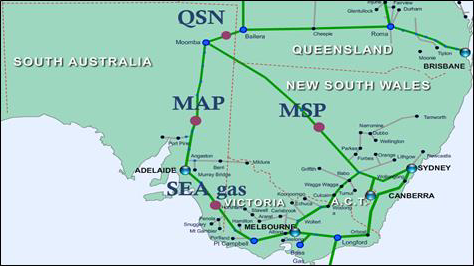
Figure G 1: Southern and eastern Australian gas fields and major pipelines
11.2. South Australian Natural Gas Supply
The role of the Technical Regulator with respect to the gas supply is to monitor the quantity and quality of the gas being supplied into the distribution network and onto consumers. Should there be a gas supply emergency the Technical Regulator will act within the provisions of the legislation to ensure that the impact upon the South Australian community is minimised.
Gas is transported from the source through transmission pipelines and these in turn transfer gas into the distribution networks at custody transfer metering stations, often referred to as ‘City Gate Stations’. Here the gas is metered, the pressure reduced and made ready for transportation through the distribution network to houses and industry.
Australian Gas Networks (AGN) is the licensed owner and operator of the natural gas distribution networks in South Australia. AGN has, in turn, contracted the APA Group to operate these networks on its behalf. Gas from the distribution system is then supplied to consumers in accordance with a contract with their retailer. In addition, AGN also owns several small gas systems, typically referred to as ‘farm taps’. The farm taps supply gas to typically a single industrial/commercial consumer that is fed directly from the transmission pipeline.
11.3. Safety of Natural Gas Infrastructure
As required by the Gas Act 1997 and AGN’s gas distribution licence, AGN must submit a Safety, Reliability, Maintenance and Technical Management Plan (SRMTMP) to the Technical Regulator for approval. This Plan is required to include a detailed Leakage Management Plan (LMP), an Asset Management Plan (AMP) and a Distribution Mains and Services Integrity Plan (DMSIP). The Technical Regulator approves the SRMTMP on an annual basis based on requirements prescribed by legislation, the Essential Services Commission of South Australia’s (the Commission) Gas Distribution Code and Gas Metering Code and AGN’s distribution licence conditions.
11.3.1. Compliance with the SRMTMP
The Technical Regulator uses the following techniques to monitor compliance with AGN’s SRMTMP:
- Auditing AGN’s and the APA Group’s compliance with specific sections of the plan directly affecting consumers, the public, and/or the safety, reliability, and integrity of the distribution network.
- Reviewing the results of any independent technical auditor engaged by AGN.
- Reviewing the results of internal auditing processes used by the APA Group.
- Reviewing the prescribed set of KPI’s reported to the Technical Regulator by AGN.
- Regular technical meetings and discussions with AGN and the APA Group.
11.3.2. Gas Measurement Management Plan (GMMP)
A GMMP is required as a condition of a distribution network licence. Detailed requirements are set out in the Gas Metering Code issued by the Commission. It forms an integral part of managing the risks associated with the installation and maintenance of gas meters to an acceptable level.
11.3.3. Gas incidents
Gas incidents that involve death, or injury to a person requiring medical assistance, property damage above $5,000 or a dangerous situation involving a pipeline operating with pressure above 1,050 kilo-Pascals (kPa), must be reported to the Technical Regulator. The APA Group and the Technical Regulator liaise frequently with the MFS and representatives of other emergency services about appropriate actions that should be taken when responding to gas incidents.
11.3.4. Third party damage
Damage to the distribution systems (mains and services) caused by third party activities constitutes one of the greatest gas related risks to the South Australian community because it can result in gas escapes of large volume. AGN reports the number of these incidents annually to the Technical Regulator as one of its KPIs. A major factor contributing to the damage of mains and services is a lack of notification from a third party to the gas distributor prior to any activity in the vicinity of the mains and services. In South Australia, the APA Group utilises the “Dial Before You Dig” (DBYD) service to minimise the likelihood of damage. This service allows the APA Group to advise about the location of gas pipes and to assess the associated risks of the activities proposed by third parties.
The Technical Regulator monitors the effectiveness of this service via frequent discussions with the APA Group, annual audits and the review of the APA Group’s annual operational reports. These discussions assist to assess whether the DBYD system provides an adequate, detailed and prompt asset information and field checking service.
The Technical Regulator addresses and resolves, with the APA Group’s assistance, numerous technical enquiries and concerns which are directly made to the Technical Regulator by third parties involved in various works in the vicinity of AGN’s distribution infrastructure.
The APA Group promotes a ‘Gas Main Awareness Program’ to reduce the number of gas incidents caused by third parties. It conducts training sessions and carries out other means of communications (e.g. meetings, letters, emails, etc.) to familiarise metropolitan and regional Councils, major civil works contractors, other utilities (e.g. SA Water, SA Power Networks and Telstra) and emergency services with the existence and identification of AGN’s distribution infrastructure. The Technical Regulator strongly supports and monitors these APA Group activities.
11.3.5. Gas leak public reports
The identification, location and repair of leaks are key to the safe operation of the distribution network. The public’s safety is a principal priority for the Technical Regulator, distribution system owners and operators. Should a pipeline fail, it could result in a leak that migrates through the ground to a confined space (e.g. a cellar) and thus would pose a major risk of fire or explosion. Any gas escapes that are found in the distribution system would have been detected through either public reporting (reactive) or regular leakage surveys (proactive). The ongoing mains renewal and mains and services repair strategy of AGN is expected to improve the condition and reliability of the gas distribution network. Over time it is expected that this should further reduce the number of gas escapes reported. The Technical Regulator continues to monitor the gas leak data, especially in relation to the mains replacement strategy.
11.3.6. Leakage surveys
Leakage surveys are the key proactive maintenance strategy employed by the distribution system operator to manage leakage and determine the condition and reliability of the gas distribution network. The approach to leakage surveys is currently risk-based and ‘high consequence’ locations are surveyed more frequently. The APA Group reports the results of the leakage surveys to the Technical Regulator annually as one of its KPIs.
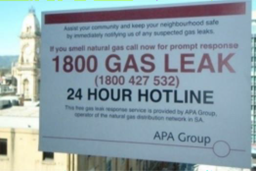
Figure G 2: The APA Group emergency/gas leak reporting number (1800 GAS LEAK – 1800 427 532)
11.3.7. Unaccounted For Gas (UAFG) and Distribution Mains and Services Integrity Plan (DMSIP)
UAFG is the difference between the measured quantity of gas entering and leaving the distribution network and is thought to be largely due to leakage. Levels of UAFG above industry norms can sometimes relate to the general condition of a distribution network, or an issue related to measurement factors. In old networks, the majority of UAFG is often associated with leaking of cast iron and unprotected steel mains. The Technical Regulator monitors AGN’s compliance with the UAFG and DMSIP requirements as prescribed in AGN’s gas distribution licence and the Gas Distribution Code. APA is undertaking ‘old generation’ high density polyethylene (HDPE) mains replacement which is expected to reduce the risks of failures at the squeeze off areas and reduce levels of UAFG over time.
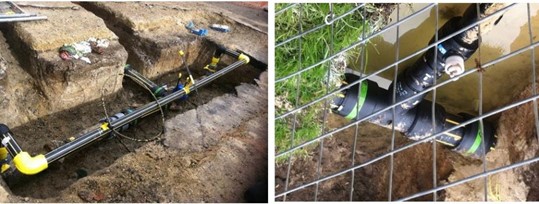
Figure G 3: HDPE mains replacement
11.3.8. Safety of LPG Distribution Networks
Distributors and retailers of reticulated LPG in South Australia are required to have the licencing relevant to their operations granted by the Commission. These licences are subject to several conditions to ensure that the safety and technical requirements of the Gas Act 1997 and the Gas Regulations 2012 apply. Network owners operate their LPG distribution networks under a SRMTMP approved by the Technical Regulator. The Technical Regulator monitors technical compliance to ensure that the construction, commissioning, operations and maintenance of the LPG distribution networks are undertaken according to the appropriate Standards and gas industry practices.
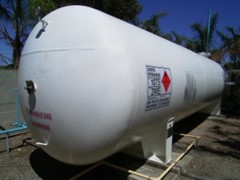
Figure G 4: Gas storage tank compound
As is the case with natural gas distribution Network, LPG incident reports are registered and reviewed by the Technical Regulator. Where found to be appropriate, the reported incidents will be investigated.
Table G 1: LPG distribution networks in South Australia as of 30 June 2023
| Network Location | Owner/ Operator | Lengthof Main (m) | OperatingPressure (kPa) | Number of consumers |
|---|---|---|---|---|
| Roxby Downs | Origin | 31,381 | 120 | 1,455 |
| Victor Harbor (Rosetta Retirement Village) | Origin | 5,474 | 80 | 448 |
| Renmark (Jane Eliza Estate) | Origin | 2,736 | 80 | 82 |
| Port Lincoln | Origin | 4,075 | 105 | 160 |
| Wallaroo | Origin | 6,355 | 70 | 196 |
| Cape Jaffa Anchorage | Origin | 3,600 | 70 | 27 |
| Mount Barker (Glenlea Development) | AGN | 4,300 | 100 | 143 |
| Mount Barker (several locations) | Environmental Land Services (ELS) | 52,344 | 70 - 120 | 4,392 |
11.4. Gas Retailers’ Safety Awareness Plans (SAP)
As of 1 February 2013, following the changes that were made to the National Energy Retail Law (South Australia) (NERL), a gas retailer must prepare, maintain, publish on its website and periodically revise a SAP in accordance with the requirements of Regulation 36A of the NERL. The requirements prescribe that the SAP must include details of the retailers’ consumer communication plan, covering issues ranging from general gas safety information to the gas appliance safety approvals scheme, and whom to contact in the event of a gas supply outage. The gas retailer must obtain the approval of the Technical Regulator for the SAP and any revision thereof.
Section 12: Gas Installation
12.1. Natural Gas and LPG Installations
Gas installations are located downstream of the supplying infrastructure, which for natural gas is the gas meter and for the first stage regulator connected to LPG cylinders. The condition and safe use of the installation is the responsibility of the owner/operator of the installation. The gas installation generally includes appliances, pipe work, flueing, ventilation and controls.
12.1.1. Responsibilities
The Technical Regulator is responsible, under the Gas Act 1997, for the monitoring and regulation of safety and technical Standards with respect to gas installations in South Australia. This involves ensuring that installation work is performed in a safe manner, using appropriate methods and materials that are compliant with relevant Standards.
The monitoring and regulating of gas installation work is carried out by officers authorised under the Gas Act 1997.
The Regulations call up the Australian Standard AS/NZ 5601 – Gas Installations (and includes any Standard also called up by or under AS/NZ 5601). The Regulations require that an electronic Certificate of Compliance must be issued by the gas fitting contractor to the client within 30 days of the completion of all installation work. The Energy Products (Safety and Efficiency) Act 2000 requires that certain proclaimed gas appliances must be labelled as evidence that they are approved to appropriate Standards by a recognised certification body or the Technical Regulator.
12.1.2. Residential and Light Commercial Gas Installations
Generally, gas installation work involves the connection of new gas appliances. Every year, a significant amount of new domestic and light commercial gas appliances are sold and installed in South Australia, including multiple appliances installed in new premises as well as single additional and replacement appliances in existing premises. In addition to the installation of new gas appliances, a significant amount of work involves the repair, replacement and extension of existing gas installation pipe work and components such as flues and ventilation equipment.
A number of new residential, as well as industrial/commercial natural gas connections, are made every year to the AGN distribution system. New LPG connections (by various LPG suppliers) are also made to residential and light commercial premises.
In larger new residential developments where natural gas is not available, it is becoming increasingly popular to supply LPG by means of reticulated LPG systems supplied from large storage tanks located on the perimeter of the estate. This has some safety advantages as it removes the need for individual LPG cylinders at each home to be replaced when empty or having individual tanks refilled by tankers.
12.1.3. Industrial and Large Commercial Gas Installations
The Technical Regulator provides oversight on several significant industrial and commercial gas installations and its involvement often extends over months or even years on some larger jobs and often requires multiple site visits.
The Technical Regulator also provides advice on the interpretation of gas Standards to hydraulic consultants, architects and builders as well as to gas contractors. This represents a significant proportion of the work done by the gas safety team in the OTR. Most advice of this type involves commercial or industrial premises. Accordingly, site visits are required to verify that the advice given is consistent with the actual site conditions. This service, whilst resource intensive, is very important and effective as it is preferable to identify and resolve installation issues proactively in advance rather than to reactively deal with non-compliances and potentially unsafe situations in areas where they may create a hazard or delay building handover.
The Technical Regulator monitors complex gas installations particularly where Type B appliances (those that consume more than 10 megajoules of gas per hour) are involved. Contractors must provide submissions to authorised Type B certifiers to initiate the certification process prior to commissioning, inspection/testing and commercial operation. Installers are also required to provide submission plans to the Technical Regulator for elevated pressure installations in order to get gas on to the property or where existing installation pressures are upgraded.
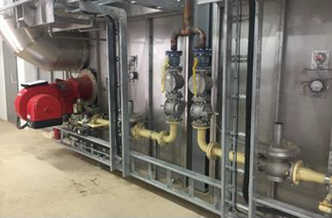
Figure G 5: New Air Dryer (Type B appliance) undergoing commissioning and Type B testing
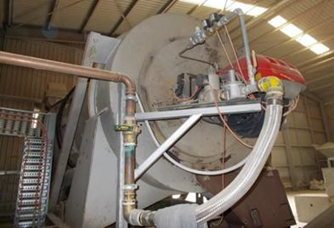
Figure G 6: Preowned resin sand dryer (Type B appliance) undergoing modifications and installation
12.1.4. Compliance Audits
Proactive Audits
The current strategy, where possible, is to proactively audit samples of the gas installation work from each contractor in South Australia annually.
The Technical Regulator uses a standard audit pro-forma to record audit results. Where work is satisfactory a copy of this form is provided to the installation owner and the contractor. Where there are non-compliances an escalation process is used (see “Enforcement activities for non-compliant gas installations” for more detail).
Where new Type B (industrial and large commercial) gas appliances are installed, it is mandatory that they are individually inspected and tested for compliance with AS 3814. If deemed compliant the equipment can then be certified and then commercially operated. In South Australia, the Australian Gas Association (in alliance with Gassupport Pty Ltd) and TG Certifications are approved to undertake certification testing of Type B appliances. The Technical Regulator in turn carries out sample audits of Type B certification work performed by both certifiers.
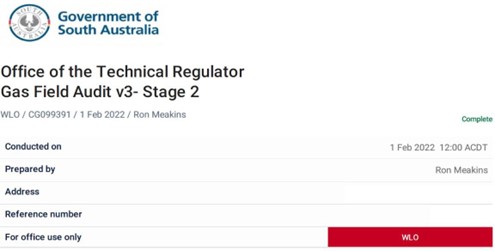
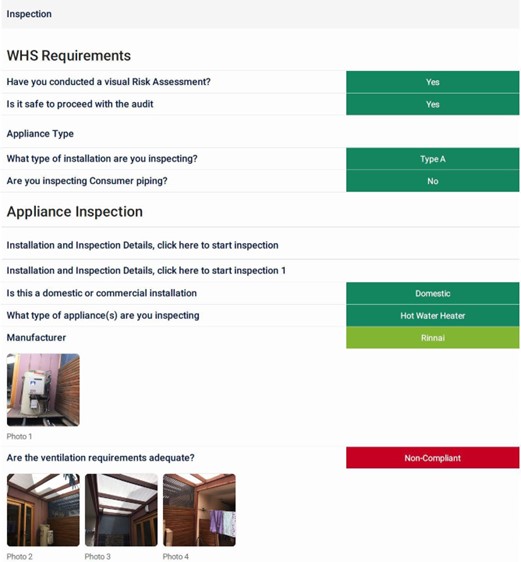
Figure G 7: Example of gas e-audit form
Mobile installations in recreational vehicles
The Technical Regulator pays close attention to the standard of LPG installations and appliances in caravans, motor homes, houseboats, river craft and small sea going vessels – including prawn boats.
Imported recreational vehicles (motor homes, caravans and camper trailers) as well as imported yachts warrant attention because they may include unique proprietary gas pipe and jointing systems not covered in the Installation Standard and appliances that are not certified to the appropriate Australian Appliance Standards.
Similar concerns apply to some imported boats. Gas safety is an ongoing consideration when a gas system or appliance repairs and maintenance is required due to the lack of spare parts. The Technical Regulator encourages importers to make space provision for appliances during the construction of boats or recreational vehicles and then source appliances certified for use in Australia and fit them on arrival in Australia hence ensuring the provision for spare parts and manufacturer warranty to overcome these issues.
South Australian registered commercial marine and river craft come under the control of the Australian Maritime Safety Authority (AMSA) who have delegated authority to the Department for Infrastructure and Transport (DIT) Vessel Unit in South Australian to provide day-to-day operations.
Commercial houseboats are required to be periodically surveyed by DIT accredited marine surveyors. Marine surveyors may advise the owner of the vessel to have a gas safety inspection carried out by a licensed contractor in advance of the slips survey so that the owner can provide evidence of fitness for purpose, by way of a copy of a gas Certificate of Compliance.
Due to the Technical Regulator’s auditing activity in this area, some insurance companies have become more aware of gas safety requirements and now insist that the gas installation is certified before marine or catering vehicle insurance policies will be issued or renewed.
Temporary kitchens at outside events
Temporary kitchens are set up to cater for outside public events and in most cases these kitchens operate on LPG supplied from portable cylinders located nearby. They may be in trucks, trailers, caravans, marquees or even inside permanent structures such as community halls.
Every year, the Technical Regulator holds pre-event gas safety meetings including PowerPoint presentations with organisers of major events. This is done to ensure that the catering companies and smaller itinerant operators on site are aware of gas safety requirements. Common issues that arise relate to installations assembled by the stallholder (e.g. using gas hose assemblies) rather than using a licensed gas fitter. Most appliances used at these events are portable burners or barbecue style appliances and it is not mandatory for a gas fitter to connect them.
The areas that are most closely monitored are the condition and protection of the appliances, gas cylinders, regulators and hoses and ensuring that there is sufficient provision for ventilation and clearance from combustibles especially where traders and the public are present. Figure G8 demonstrates an example of a temporary cooking setup found at an outside event. The operator was advised to secure and protect the flexible hoses connecting the portable appliances.
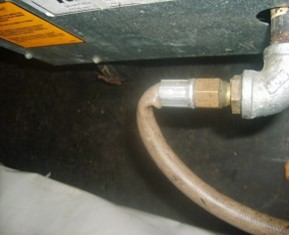
Figure G 8: Example of a damaged gas hose on a temporary cooking setup at an outside event
The Technical Regulator typically sends inspectors to patrol public event sites during the set up and then randomly during the event to ensure continuing compliance. The Technical Regulator works closely with inspectors from SafeWork SA and private event safety consultants to educate and improve the safe use of gas. Thus, gas related incidents at public events have declined over time and the safety standards demonstrated have improved significantly.
Figure G9 provides an example of a mobile catering food caravan trading in Adelaide’s CBD. Here the portable power generators are installed too close to the gas cylinders and the operator was advised to have the generators relocated to provide the correct clearance from the LPG cylinders. Modifications have since been undertaken to the appliance installation to conform to the Standard.
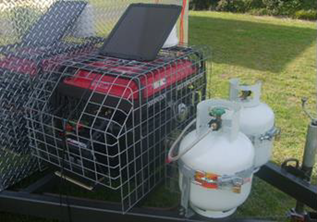
Figure G 9: Example of non-compliant portable generators
Audits of permanent gas installations at tourist and caravan parks
The Technical Regulator also focuses on the safety of gas installations in caravans and tourist parks. Some of these parks are located close to major centres and use natural gas but most use LPG for hot water and cooking as well as for on-site kitchen and laundry facilities.
In addition to communal facilities, the Technical Regulator inspects gas installations in permanently occupied caravans or cabins. Permanent residents pay rent to the park owner for the site but are responsible for their own utility bills as well as any repairs and maintenance to gas installations or appliances. Long term residents are sometimes in lesser financial circumstances and gas installation and appliance maintenance may not be a priority.
The Technical Regulator may, in extenuating circumstances, extend the period allowed for the work to be made compliant provided there is no immediate danger to the resident or neighbours. In unavoidable circumstances, where remedial work cannot be delayed, gas inspectors will either disconnect the gas supply or make an arrangement with the park owner/manager to have the work completed.
The example below shows a cooking facility that required the replacement of the LPG regulator due to gas leaking and rectification of the high-pressure cylinder connection and prohibited jointing.

Figure G 10: Example of a communal cooking facility at a caravan park that required modification
Where a caravan is used as permanent accommodation, it is unregistered, and the wheels are usually removed and other structures may also be attached from the ground to the van. In this case the installation is treated as a residential dwelling and not a mobile home. The electricity, water and gas are permanently connected.
Flame Effect Burners used in Public Events or Productions
The Technical Regulator inspects flame effect burner systems and their associated controls that are manufactured or assembled by pyro technicians and / or gas fitters for use in public events such as the Fringe Festival, corporate events, or by playwrights at the Festival Theatre.
Manufacturers and event organisers are made aware of their legal and technical responsibilities in relation to the Gas Act 1997, the Plumbers, Gas Fitters and Electricians Act 1995 and Work Health and Safety (WHS) obligations. Event organisers, operators and flame effect designers and constructors must define the tasks, conditions and limitations of the performance or effect in their designs.
Safe Work Method Statements and Standard Operating Procedures must be formulated and the risks assessed to eliminate/minimise risks of injury or damage to property.
Participants must also be provided with appropriate training and Personal Protective Equipment and a hierarchy of controls need to be implemented to manage the risks in setting up, commissioning, operating and decommissioning. All relevant regulatory authorities should be notified of the activity, i.e. MFS / CFS / SafeWork SA / Councils if permits are required.
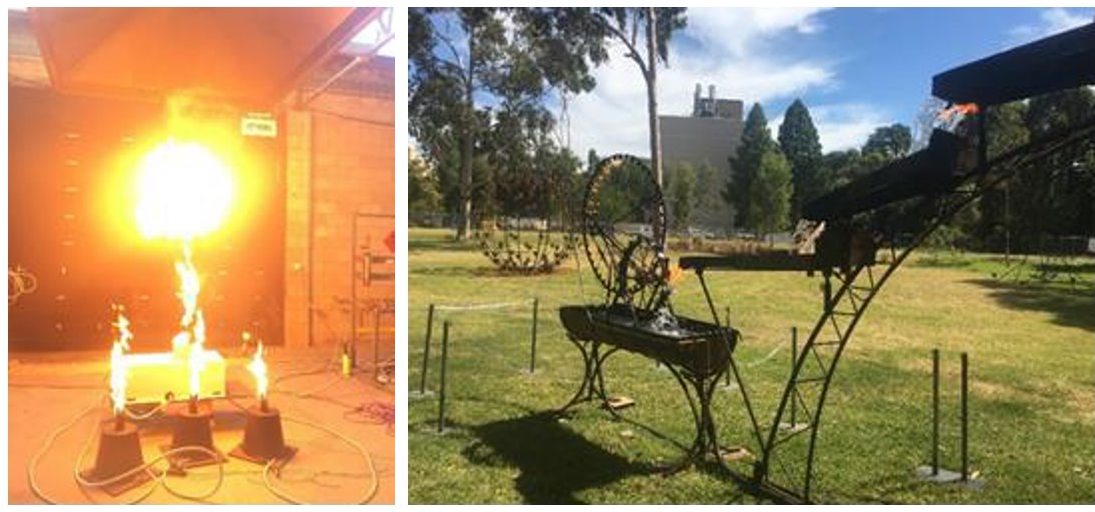
Figure G 11: Examples of LPG effect fires used at outdoor events
Enforcement activities for non-compliant gas installations
The Technical Regulator’s enforcement activities with respect to non-compliant gas installation work are on a graduated scale which escalates according to the degree of non-compliance found during a proactive audit or as a result of an inspection prompted by a gas consumer complaint or safety report by the trade.
1. Minor technical non-compliance
A copy of the audit pro-forma is left with the owner and a warning letter together with a compliance statement is sent to the installation contractor with a request to remedy the situation. A follow up phone call is made to the owner to confirm that the non-compliance has been remedied once the compliance statement is returned by the contractor to the Technical Regulator.
2. Significant but non-hazardous non-compliance
A copy of the pro-forma accompanied by a warning letter and compliance statement is sent to the contractor. The letter, endorsed by the installation owner, asks the gas fitter return to the site within a given time frame, to remedy the non-compliances. The owner is notified that significant remedial work is required. A signed and dated compliance statement must then be sent back to the Technical Regulator by the contractor or owner to confirm that the remedial work has been completed. A follow up inspection may be done at the discretion of the Technical Regulator.
3. Non-compliance posing an immediate danger to persons or property
As above, except to make such an installation safe the Technical Regulator’s inspector may be required to isolate an appliance or part of the system or cut off the gas supply to the premises. After the defect has been remedied, a signed and dated compliance
statement must then be sent back to the Technical Regulator. A follow up inspection will then be carried out. An expiation notice may be issued for defective work. Expiation notices impose a fee plus a victims of crime levy per breach for defective work. An expiation notice may include up to three breaches for any one gas installation job.
4. Prosecution
The Technical Regulator may prosecute a contractor where the non-compliance is so serious as to constitute gross negligence or where a contractor has a history of significant non-compliance.
The process is generally as above with the exception that no expiation notice is issued and prosecution is instead proceeded with. The evidence, comprising of various interview/investigation notes, statements, photographs and measurements/observations/reports are gathered.
In some circumstances, the original contractor cannot or will not return to the site to remedy the non-compliance/s due to licensing or commercial issues and sometimes the owner will not allow the contractor back on the site. In these situations, the owner must engage a third-party gas fitter to make the installation compliant. A signed and dated compliance statement must then be sent back to the Technical Regulator and a follow up verification audit will be carried out.
5. Disciplinary interviews / desk top audits
Where repeated non-compliant gas installation work can be attributed to a specific worker or contractor, an interview is arranged. This has been found to generally be a much more effective approach to remedy situations. The interview is carried out with two authorised officers in attendance and is recorded. The aim of the interview is to establish the following:
- To identify and emphasise the seriousness of the breaches.
- To ascertain whether the breaches occurred as a result of negligence or a lack of knowledge.
- If the person was working beyond the scope of their licence and personal competence.
Where a licensing issue is found, the contractor will be referred to Consumer and Business Services (CBS) with a recommendation from the Technical Regulator that disciplinary action is considered to suspend or cancel the gas fitting worker’s registration or contractor’s licence.
Alternatively, or in addition, a recommendation may be made that the worker or contractor attends remedial upskill training to overcome knowledge/skill deficiencies.
Referrals to CBS
Where unlicensed work includes significant non-compliances with the Gas Installation Standards, the Technical Regulator prefers that a joint CBS and Technical Regulator interview be conducted. In addition to any penalty applied by the Technical Regulator, CBS can also apply various sanctions including licence suspension and, in more serious circumstances, licence cancellation.
If a person is found to be performing gas fitting work while unlicensed, CBS may, in serious circumstances, prosecute or as a minimum seek a written assurance that the unlicensed person or entity desists from this work.
12.1.5. Gas incidents – Installations
Gas-related incidents include those involving natural gas or LPG, or their products of combustion.
Figure G12 below shows the result of a gas BBQ fire resulting from gas leaking from the high-pressure POL connection on the regulator/hose assembly. This happened due to operator error. The connection was not tightened in the cylinder valve correctly and was not tested with soapy water as per manufacturer operating instructions.
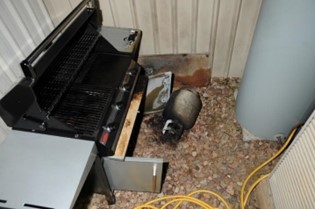
Figure G 12: Gas BBQ fire due to gas leaking from the high-pressure POL connection
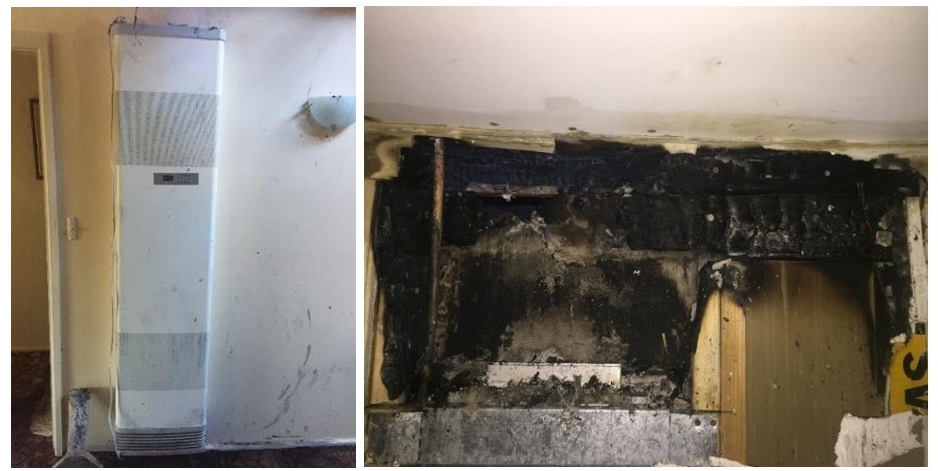
Figure G 13: House fire because of an incorrect DIY appliance installation
Figure G13 shows the result of a fire involving pyrolysis, with combustion of flammable timber pine stud frames in an internal plasterboard wall because of a DIY installation where the single skin metal flue was located too close to the notched timber stud frame header in an internal plasterboard dividing wall. The fire commenced inside the wall and quickly spread up into the roof space causing approximately $3,400 in damage.
Section 13: Gas Products
The Energy Products (Safety and Efficiency) Act 2000 is administered by the Technical Regulator and requires certain proclaimed gas appliances to be tested, certified, and labelled before they can be sold, installed, and used in South Australia.
Other Australasian jurisdictions have similar legislation. The Technical Regulator works with other Australasian Regulators and Standards Committees to ensure a nationally consistent gas product safety regulatory regime.
13.1. Gas Appliance Certification
Gas appliances are classified as either Type A (generally mass produced, domestic and light commercial) or Type B (heavy commercial, industrial and often unique utilisation). There are currently five Conformity Assessment Bodies (CAB) that can certify Type A gas products in Australia. They are – the Australian Gas Association (AGA), Standards Australia International Global (SAIG) the International Association of Plumbing and Mechanical Officials R & T Oceana (IAPMO), Global Mark and Vipac Engineers & Scientists. Their commonly sighted certification labels are provided below.
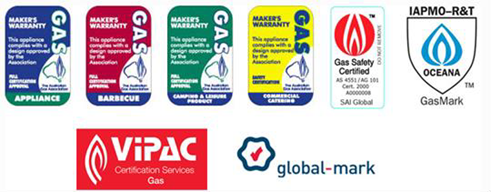
Figure G 14: Certification Label Examples
The Technical Regulator sits on the Gas Technical Regulators Committee (GTRC) and as such takes a pivotal role in their activities. The GTRC has introduced a national database for gas appliances certified by the approved CABs and is working towards a set of national Gas Scheme Rules and an associated Gas Compliance Mark.
13.2. Appliance and Component Recalls and Safety Notices
An approved CAB can suspend or cancel the certification of a gas appliance or component under certain circumstances. Typically, this would occur when:
- The manufacturer wishes to change to an alternate CAB.
- The manufacturer has ceased production of the appliance or component and product certification is surrendered voluntarily.
- The manufacturer has failed to pay ongoing fees or to provide the product to the respective CAB for annual verification inspections or label costs.
- The appliance manufacturer has been found to have modified the appliance, without notifying the respective CAB, so that it does not exactly replicate the appliance as originally certified.
- An appliance has been modified in a way that affects its safety or reliability. Where this happens, Technical Regulators will call for a product recall or safety notice to be released.
- An appliance is found to be defective in service to a point where it is likely to create a hazard (this does not include normal wear and tear or the lack of maintenance by the operator). Where this happens, the Technical Regulator will expect a product recall or safety notice.
Note – certification may be reinstated if the manufacturer satisfactorily remedies the non-compliance.
13.3. Small Mobile LPG Appliances
Every few years, the Technical Regulator conducts an auditing programme for appliance retail stores. This provides the Technical Regulator with an opportunity to check if the retailers are selling only approved, certified equipment and that their displays provide all the necessary safety information. In addition, it allows the Technical Regulator to check if these retailers have been notified of any product recall or suspensions and if (or whether) they act in accordance with the notice.
The audits are also an opportunity to educate the retailers to only accept certified goods for sale and to pass on the appropriate safety information to their consumers. It should be noted that any issues that were found during an audit were addressed immediately, and the offending product(s) were removed from shop displays. If required, the stock shall be quarantined until the non-conformance had been rectified. This process was, in general, well received by store managers.
How to check whether a gas appliance is certified or not?
If buying directly from a retail outlet, the retailer can be asked to show the data plate on the appliance. Examples of data plates are illustrated in Figure G15 and Figure G16. It contains two major indications of gas certification, the certification badge or label and the certificate number. However, if buying a gas appliance online, the certification information observed below can be verified by asking the provider.
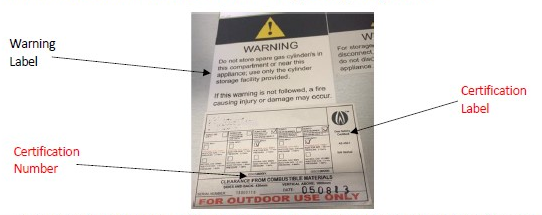
Figure G 15: Information Data Plate including certification number, warning, and certification label

Figure G 16: Information Data Plate including certification number and certification label
Section 14: Gas Regulatory Coordination
14.1. Safety and Technical Standards
The Technical Regulator is actively represented on the relevant Australian Standards committees and joint Australian and New Zealand Standards committees that deal with gas issues and plays an important role in developing and maintaining the Standards.
These technical Standards define the minimum requirements for the gas quality, design, installation, commissioning, operation, maintenance and decommissioning of gas infrastructure, installations and appliances and ensure that the gas distribution networks are being operated with a high level of safety and reliability. The Standards also address the quality of gas supplied.
14.2. Committee Representation
The Technical Regulator is represented on or has provided valuable technical comments to several Standards Australia committees as well as many other committees, forums, and associations.
The Technical Regulator has been, and continues to be, directly involved in the development and promotion of several industry technical Standards. Several staff members represent the Technical Regulator on the key Standards committees generally on behalf of the GTRC. The resultant Standards are called up into legislation administered by the Technical Regulator. This provides the way forward in setting the minimum technical and safety requirements and a principle to ensure appropriate safety enforcement.
The Technical Regulator is represented on the following:
14.2.1. Gas Technical Regulators Committee (GTRC)
All Australian jurisdictions as well as New Zealand are members of the Gas Technical Regulators Committee (GTRC). The GTRC holds two meetings a year.
The Technical Regulator maintained close communications with interstate safety regulators through both the formal GTRC channels and informally with peers in those organisations to share technical knowledge, information on appliance safety issues, common interests, and concerns. These relationships are vital to ensure that technical expertise is maintained in all areas covered by technical regulation.
Issues featuring highly included the pursuit of a set of “Rules” that can attempt to harmonise requirements across jurisdictions and provide consistency of information to CABs and other stakeholders. The Rules, when recognised by a Technical Regulator, will provide a set of requirements for the operation of a certification scheme when read in conjunction with each jurisdiction’s legislation.
An ongoing example of an area of common concern and cooperation between interstate gas regulators is the issue of uncertified gas appliances offered for sale on internet.
Regulators have continued to send out warning letters to the appliance retailers and the internet website agents to warn of this potentially misleading practice.
The GTRC is also monitoring the performance of several appliances that are considered to exhibit a higher risk of safety issues these include canister cookers and area heaters.
The GTRC has also been monitoring issues associated with carbon monoxide (CO) poisoning and the individual jurisdictional response to issues surrounding the risks associated with gas appliances and CO. It should be remembered that if gas does not burn correctly CO is produced. CO is a colourless, odourless and tasteless gas which is very poisonous, and the human body does not recognise its presence. Given these properties, it can kill and hence it is often known as 'the silent killer'.
14.2.2. AG-006, Gas Installation Committee (AS/NZS 5601 & AS 4575)
This Standards committee is a gathering of industry subject matter experts representing industry stakeholders (i.e. technical regulators, appliance manufacturers, gas suppliers, utilities/network operators, installers, trainers) and industry bodies such as the Master Plumbers Association, the Plumbing Industry Commission and the Australian Building Construction Board (ABCB).
The Technical Regulator is able to communicate information to and from the industry stakeholders (e.g. the trade and GTRC) and Standards Australia to ensure that their views are represented in the development of the Standards.
AS/NZS 5601
The purpose of the committee is to maintain Part 1 Gas installation – general installations and Part 2 LPG installations in caravans and boats for non-propulsive purposes. The activity in amending these documents is as a result of new innovations and changes to building and work practices, to advancements in materials and appliance technology.
AS 4575
The committee has been authorised to fully revise the aged Standard AS 4575 Quality of Gas Servicing. The revision is a result of new innovations, changes, work practices, advancements in materials and appliance technology. The scope of the Standard will be expanded to include worksite hazards, scoping work, appliance isolations, electrical safety, servicing protocols including fault diagnosis, testing, verification and commissioning in addition to records management and quality systems.
14.2.3. AG-001, Gas Appliances Committee
The purpose of the committee is to develop a new series of gas appliance Standards and to maintain the entire suite of gas appliance Standards that are within the committee’s scope. These Standards cover the technical, safety and performance requirements of domestic and light commercial gas appliances, known as Type A gas appliances.
Standards are being developed in an attempt to avoid the need to provide a new Standard for every new gas appliance that comes out on the market. They concentrate on the fundamental safety principles of all gas appliances especially things like combustion and temperature hazard requirements and relate them across all gas appliances.
This approach has been adopted by New Zealand and now they are a joint AS/NZS 5263 series of Standards. The Technical Regulator has made a major contribution to this process and the changes that are being made in the gas appliance certification process in the future.
14.2.4. AG-008, Gas Distribution Committee (AS/NZS 4645)
The joint Australia and New Zealand Standards Gas Distribution Committee (AG-008) provides input in developing further revisions to some parts of the Australian/New Zealand Standard AS/NZS 4645 ‘Gas distribution networks’ to ensure safe, reliable and affordable gas distribution systems. These parts are: Part 1: – ‘Network Management’, Part 2: – ‘Steel Pipe Systems’ and Part 3: – ‘Plastic Pipe Systems’. AG-010, Natural Gas Quality Specifications Committee (AS 4564).
14.2.5. AG-038, Liquefied Petroleum Gas Quality Specifications Committee (AS 4670)
The function of AG-038, the LPG Quality Specification Committee, is to maintain AS 4670 Commercial propane and commercial butane for heating purposes. This sets out the gas quality requirements necessary to ensure the suitability of the liquefied petroleum gas for heating purposes.
14.2.6. AG-010, Natural Gas Quality Specifications Committee (AS 4564)
The function of AG-010, the Gas Quality Specification Committee, is to maintain the AS 4564 specification for general purpose natural gas. This specification sets out the gas quality requirements necessary to ensure the safety of general-purpose natural gas transported and supplied for use in natural gas appliances and equipment, and for use as fuel in natural gas vehicles.
14.2.7. Other Committees, Forums and Representation
- The Plumbing and Gas Fitting Advisory Forum.
- Standards Australia Gas Sector Advisory Forum: The Technical Regulator has membership in this forum and is thus involved in the strategic direction for the development of all gas related Standards.
- The Australian Institute of Energy: The Technical Regulator has membership in this organisation to stay informed about activities being undertaken across the energy industry.
- Gas Energy Australia: The Technical Regulator has membership in this organisation to stay informed about development in the LPG, compressed and liquefied natural gas industries.
- River Murray Houseboat Hirer’s Association: The Technical Regulator liaises with the association and provides technical and safety information relating to LPG installations on houseboats.
- Plumbing Industry Technical Forum: The Technical Regulator provides advice on legislation and Standards relating to natural gas and LPG installation and appliance safety.
- Caravan and Camping Association of South Australia (CCASA): The Technical Regulator provides advice and technical assistance to ensure that gas installations and appliances comply with technical and safety Standards.
- Domiciliary Care and Royal District Nursing Society (RDNS): The Technical Regulator provides advice with respect to making installations and appliances safe where elderly, infirm or blind people are involved or where the householder may suffer from dementia.
- National Gas Industry Training Package: In 2015-16, the UEG06 Package (training package for workers employed by, or contracting to, gas distribution companies to work on their infrastructure) was again reviewed and further changes were proposed for endorsement as part of continual improvement.
- Damage Avoidance Committee: This committee was formed and facilitated by SafeWork SA for Industry stakeholders / State and Australian Government interaction on water-gas-electrical and various communications utilities. The preliminary focus covers damage avoidance to infrastructure services, and stakeholder representation to collaboratively formulate codes of practice and produce safety education material for industry. The OTR gas and electrical groups are represented on this committee.
- SafeWork SA: SafeWork SA is responsible (under the Dangerous Substances Act 1979) for the storage and handling of LPG, where the quantity stored on site exceeds 560 litres. The Technical Regulator Gas Installation and Appliance section and SafeWork SA have excellent two-way feedback with respect to safety, installation and storage facilities.
SafeWork SA also works closely with the Technical Regulator when investigating workplace safety accidents where natural gas or LPG are involved.
National Gas Emergency Response Advisory Committee (NGERAC)
Originally, the then Ministerial Council on Energy (MCE) developed a National Gas Emergency Response Protocol. Energy Ministers now provide national oversight and coordination of energy sector decision-making and energy market reform.
In Australia, a large proportion of the national gas supply network is interconnected across most State and Territory borders and Energy Ministers seek to facilitate the development of a more reliable, secure, and competitive national gas market. Energy Ministers have agreed that a National Gas Emergency Response Protocol (“the Protocol”) should be retained to ensure natural gas supply disruptions are managed in a consistent manner across all jurisdictions.
The Protocol contains two main elements:
- Arrangements for inter-jurisdictional consultation on the use of statutory emergency powers in the event of a major natural gas supply shortage.
- Establishment of a government-industry National Gas Emergency Response Advisory Committee (NGERAC). The NGERAC usually meets twice each financial year.
During a major national gas supply shortage NGERAC will be a key source of information and advice, but not necessarily the only source for Energy Ministers and jurisdictions. The advice provided by the collective committee will seek to ensure efficient and effective responses to and management of major natural gas supply shortages (including the use of Emergency Powers). This advice is based on the need to be timely and to be consistent with maintaining the integrity of the gas supply system and public health and safety.
In the event of a major natural gas supply shortage, market and commercial arrangements are to operate as far as possible to balance gas supply and demand as well as maintaining system integrity. NGERAC would be activated (time permitting) to assist in an event of a potential or actual multi-jurisdictional gas supply shortage or where a single impacted jurisdiction has requested that the NGERAC be convened for the purpose of sharing information.
Volume III – Water Industry
Preface
This volume covers the Technical Regulator’s operations under the Water Industry Act 2012.
Water Industry Act 2012
Section 3 of the Water Industry Act 2012 states that:
“The objects of this Act are—
(a) to promote planning associated with the availability of water within the State to respond to demand within the community; and
(b) to promote efficiency, competition and innovation in the water industry; and
(c) to provide mechanisms for the transparent setting of prices within the water industry and to facilitate pricing structures that reflect the true value of services provided by participants in that industry; and
(d) to provide for and enforce proper standards of reliability and quality in connection with the water industry, including in relation to technical standards for water and sewerage infrastructure and installations and plumbing; and
(e) to protect the interests of consumers of water and sewerage services; and
(f) to promote measures to ensure that water is managed wisely.”
The Technical Regulator is established by section 8 of the Water Industry Act 2012.
Section 9 of the Water Industry Act 2012 provides:
“The Technical Regulator has the following functions:
(a) to develop technical standards in connection with the water industry;
(b) to monitor and regulate technical standards with respect to—
(i) water and sewerage installations and associated equipment, products and materials (including on the customer’s side of any connection point); and
(ii) plumbing;
(c) to provide advice in relation to safety or technical standards—
(i) in the water industry to the Commission at the Commission’s request; and
(ii) in the plumbing industry;
(d) any other function assigned to the Technical Regulator under this or any other Act or conferred by regulation under this Act.”
The aim of the Water Industry Act 2012 is “to facilitate planning in connection with water demand and supply; to regulate the water industry, including by providing for the establishment of a licensing regime and providing for the regulation of prices, customer service standards, technical standards for water and sewerage infrastructure, installations and plumbing, and by providing performance monitoring of the water industry; to provide for other measures relevant to the use and management of water; to make amendments to various related Acts; to repeal the Sewerage Act 1929, the Water Conservation Act 1936 and the Waterworks Act 1932; and for other purposes”.
The Technical Regulator provides input and is involved in a range of activities in liaison with the water industry and other government agencies.
Section 15: Water and Sewerage Infrastructure
15.1. Introduction
Infrastructure is defined as the structures, systems and facilities that service the community, and water and sewerage infrastructure is the infrastructure into which the plumbing contractors connect on-site plumbing (including drinking water, non-drinking water (recycled water) and drainage installations).
Water and sewerage infrastructure includes but is not limited to:
- Drinking water distribution systems.
- Drinking water treatment and storage facilities.
- Sewage collection systems.
- Sewage treatment and storage facilities.
- Community wastewater management collection systems.
- Wastewater treatment and storage facilities.
- Non-drinking water distribution systems.
- Non-drinking water treatment and storage facilities.
- Non-drinking water harvesting and reuse systems.
Water and sewerage infrastructure that provides a service to a customer is typically the responsibility of a water industry entity (such as SA Water, local Council, or a private company). By comparison, on-site plumbing, drainage, and associated equipment downstream of the meter or property connection is the responsibility of the property owner.
15.2. Water Industry Entities
A water industry entity is defined in the Water Industry Act 2012 and designates any entity providing water and/or sewerage retail services in South Australia. There are three main categories of water industry entities: major, intermediate, and minor, which are based on connection numbers (a full list of entities can also be found on the Commission’s website).
There are currently 71 licensees in South Australia and a total of 67 Water Industry Entities (four water industry entities have two separate licences) across the three categories as presented in Table W1. There is a single major water industry entity in South Australia being SA Water.
Table W 1: Licence classifications
| Classification | Number of connections | Number of Licensees in SA |
|---|---|---|
| Minor | Less or equal to 500 | 30 |
| Intermediate | Between 500 and 50,000 | 40 |
| Major | More than 50,000 | 1 |
| Total for South Australia | 71 | |
SA Water provides drinking water and sewerage services to more than 1.7 million people in SA. The remaining water industry entities are classified as intermediate and minor as per the above table and provide services across the whole of South Australia servicing metropolitan, outer metropolitan and regional townships, as presented in Table W2.
Table W2 : Water industry entities per region in South Australia
| Region | Number of Water Industry Entities |
|---|---|
| Metropolitan, Southern and Hills | 20 |
| Central, Northern Areas & Yorke Peninsula | 19 |
| Eyre Peninsula | 12 |
| South East | 6 |
| Riverland & Murraylands | 10 |
| Total for South Australia | 67 |
The split between the services provided by the water industry entities is presented in Figure W1.
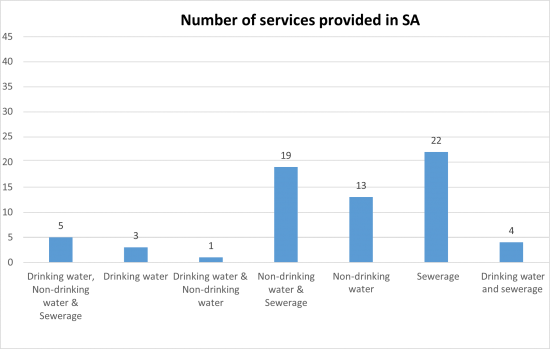
Figure W 1: Split between services provided by water industry entities in South Australia
Of the current 67 water industry entities in South Australia, most provide sewerage services (80% of all entities) via Community Wastewater Management Schemes (CWMS), formerly known as Septic Tank Effluent Disposal Schemes (STEDS). These schemes typically comprise a gravity drain collection network (connecting to customers’ on-site septic tanks), which convey all of the septic tank effluents to a treatment system and disposal facility. CWMS are typically owned, operated and managed by local Councils as the water industry entity.
In addition to drinking and sewerage services, water industry entities can provide non- drinking water services which include the distribution of non-drinking water for irrigation and non-drinking water use, such as toilet flushing.
15.1. Regulation of Water Industry Entities
Water industry entities must provide their Safety, Reliability, Maintenance and Technical Management Plan (SRMTMP) to the Technical Regulator in accordance with the Water Industry Act 2012 and Water Industry Regulations 2012.
The SRMTMP shall include the following matters, as a minimum:
- Safe design, installation, commissioning, operation, maintenance and decommissioning for water and/or sewerage infrastructure owned or operated by the water industry entity.
- Maintenance of water and/or sewerage services of the quality required to be maintained by or under the Water Industry Act 2012, the Water Industry Regulations 2012, licence or other conditions.
- Monitoring compliance with safety and technical requirements imposed by or under the Water Industry Act 2012, the Regulations, licence or the conditions of any exemption.
- Monitoring water and/or sewerage infrastructure owned or operated by the water industry entity that is considered unsafe or at risk of failing or malfunction.
- Establishment of indicators and the collection and recording of information to measure the water industry entity’s performance.
SRMTMPs are ‘live’ documents and any changes and/or revisions are required to be approved by the Technical Regulator.
Following the submission and subsequent approval of a SRMTMP by the Technical Regulator, the water industry entity must complete audits as described in Sections 2.3.1 and 2.3.2.
SRMTMP Assistance
The OTR Guidance Document provides advice and assistance to water industry entities for the development of their SRMTMP that is acceptable to the Technical Regulator and deemed to comply with the Water Industry Act 2012 and Water Industry Regulations 2012. The focus is placed on safe and reliable operation for people and plant to ensure a safe and reliable service to customers. In many cases, the water industry entity already has existing documentation which meets the minimum information required.
15.3.1. National Performance Reporting
The OTR is one of two South Australian jurisdictional coordinators for National Performance Reporting (NPR) since 1 July 2021. The NPR Framework supports commitments made by States and Territories under the National Water Initiative (NWI), to report publicly and independently on the performance of urban water utilities. The NPR is published annually by the Bureau of Meteorology (BoM). The OTR’s role as jurisdictional coordinator is to be a point of contact for BoM for all data collection, submission, and auditing issues as well as any participation in Framework Reviews as directed by the Urban Water Reform Committee (UWRC).
A major review of the NPR Framework was undertaken in 2019 and as a result a set of recommendations were delivered to ensure the NPR’s relevance and value into the future. In response to some of the recommendations an Indicator Review was undertaken in 2021 which sought to identify a set of nationally relevant and future focused themes, outcome areas and reporting metrics.
The Indicator Review was undertaken by Hydrology and Risk Consulting (HARC) in partnership with Aither and Risk Edge Consulting. The Review engaged with existing and potential users through consultation, workshops, and briefing papers. Local government, privately owned and State-owned corporation service providers with less than 10,000 connected properties do not currently report under the Framework. The Review recommended that reporting should be extended to include those with less than 10,000 connected properties.
From October 2021 through to April 2022, the OTR ran a two-part voluntary trial in conjunction with HARC. Phase-one of the trials was about developing a shared understanding of the proposed reporting requirements and gave entities the opportunity to provide a considered response and self-assessment on each of the proposed indicators in terms of ability, as an organisation, to provide the data identified. Phase-two focused on trialling data collection using the Queensland Water Directorate’s Statewide Water Information Management (SWIM) web portal. Phase-two was based on the current NPR indicator set minus any indicators marked for retirement through the Indicator Review. The OTR published a Summary of the SA National Performance Report Trial (PDF, 620.8 KB).
In early 2023 the OTR undertook consultation on the Review's proposed indicator subset for service providers with less than 10,000 connections. The purpose of the consultation was to understand what data would be used and to better understand the relevance of indicators. The OTR published a National Performance Report (NPR) SA Subset Consultation Report (PDF, 698.3 KB) which outlines the consultation process and outcomes. The work on a subset for service providers with less than 10,000 connections is still ongoing at a national level and the OTR has shared the outcomes from the SA consultation.
The draft findings and recommendations of the NPR Indicator Review indicated broad support across Australia for the inclusion of entities with less than 10,000 connections to provide performance reporting data to the NPR. The Indicator Review’s Recommendations have now been endorsed by all States at a national level. Service providers with less than 10,000 connections will begin collecting data from the start of the 2024-2025 financial year and reporting against NPR Indicators will commence from 1 July 2025. Through its role as joint jurisdictional coordinator the OTR will provide support and education as well as communicating any new updates as they occur.
15.4. Water and Sewerage Infrastructure Incidents
15.4.1. Water and Sewerage Infrastructure Incident Classification and Notification Protocol
There is a Water and Sewerage Infrastructure Incident Notification and Communication Protocol, which provides water industry entities with a clear understanding of their notification and reporting requirements to the Technical Regulator. The Protocol is an overarching document, is applicable to all water and sewerage infrastructure and provides incident classification and notifications requirements. The protocol does not absolve the entities from responsibilities to any other agencies, such as those that are included in the Department for Health and Wellbeing (DHW) / Environment Protection Authority (EPA) Water/Wastewater Incident Notification and Communication Protocol or other similar documents.
The Technical Regulator periodically updates the protocol to ensure that the information is current and accurately reflects all water and sewerage infrastructure incidents and regulatory requirements.
15.4.2. Other Incident Classification and Notification Protocol
The Technical Regulator is also included in the DHW and EPA Water/Wastewater Incident Notification and Communication Protocol as a notifiable agency. This Protocol is specific to SA Water, EPA and DHW and was first established in 1999. This protocol meets the Safe Drinking Water Act 2011 requirements for an approved incident identification and notification protocol.
Section 16: Plumbing Installation
16.1. Plumbing Regulation
The Water Industry Act 2012 and the Water Industry Regulations 2012 provide the legislative framework for the regulation of the on-site plumbing industry in South Australia. The Technical Regulator monitors and regulates plumbing and associated equipment, under section 9 of the Water Industry Act 2012. On-site plumbing installations are audited for compliance with the Performance Requirements of the National Construction Code (NCC) Volume 3 – Plumbing Code of Australia (PCA).
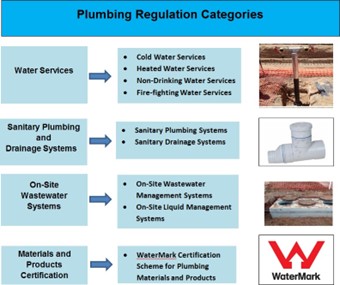
Figure W 2: Plumbing categories that are monitored and regulated through on-site audits by the OTR
16.2. Plumbing Compliance
The Technical Regulator is responsible for monitoring and regulating technical Standards with respect to on-site plumbing. Plumbers constructing, installing, replacing, repairing, altering and maintaining pipes or any other equipment, products or materials used in connection with plumbing are required to book these installations for audit with the Office of the Technical Regulator.
The Technical Regulator undertakes routine sample audits of plumbing installations, non-compliant plumbing installations are rectified to ensure technical compliance with the Plumbing Standard issued by the Technical Regulator under section 66 of the Water Industry Act 2012.
Testable backflow prevention devices on the customer’s side of any water connection point must be commissioned and tested after installation in compliance with AS 2845.3.
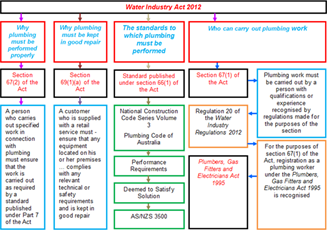
Figure W 3: Details of plumbing obligations under the Water Industry Act 2012
16.3. Plumbing Audits
16.3.1. Plumbing Bookings and Audits
The Technical Regulator audits plumbing installations in South Australia for compliance with the Plumbing Standard published pursuant to section 66 of the Water Industry Act 2012. This Standard has adopted relevant sections of the Plumbing Code of Australia (PCA). All plumbing installations must meet the performance requirements of the PCA through the deemed-to-satisfy solutions set out in the AS/NZS 3500 plumbing and drainage Standard Suite or by satisfying the performance requirements set out in the PCA.
The plumbing installations audited can range from the addition of a toilet en-suite, a residential home, to more complex commercial installations within shopping centres or multi-storey high-rise apartments. Final audits of complete plumbing installations are undertaken to monitor more complex multi-storey installations or in situations where ongoing non-compliance has been identified.
Auditing Policy
The Technical Regulator selects sites for auditing by:
- Scheduling a random selection of sites by relying on the integrity of the Plumbing case management system to identify all plumbing work being performed through the booking process.
- Focusing on a particular category of plumbing, based on the risk involved e.g. maintaining a regular presence in the south-east region, where there are currently no local inspectors, by scheduling periodic visits from head office and maintaining a strong focus on non-drinking water installations and backflow protection.
- Responding to complaints from either the public or plumbing industry.
- Responding promptly to emergency situations.
- Failed jobs cases are monitored through a fortnightly review allowing the Technical Regulator to ensure all outstanding non-compliant installations are accordingly rectified.
Plumbing audits booking system
The Technical Regulator maintains a plumbing case management system to record information relating to on-site plumbing audits. This system records the plumbers audit request dates and the results of the audits carried out by the OTR plumbing installation officers.
| Commercial and industrial plumbing inspections include: | Residential plumbing inspections include: |
|---|---|
| Above-Ground Sanitary. | Above-Ground Sanitary. |
| Backflow Audits. | Building Plans. |
| Drainage. | Drainage. |
| Encumbrance Investigations. | Final Inspections. |
| Final Inspections. | Fire Services. |
| Fire Services. | Hot & Cold Water. |
| Hot & Cold Installation. | Recycled Water In-Wall. |
| Hot Water. | Hot & Cold Installation. |
| Rainwater Inspection. | Hot Water. |
| Non-Drinking Water In-Ground. | Rainwater Inspection. |
| Non-Drinking Water In-Wall. | Non-Drinking Water In-Ground. |
| Non-Drinking Water – Investigations. | Non-Drinking Water In-Wall. |
| Sewer Investigations. | Non-Drinking Water – Investigations. |
| Site Meetings/Inspections. | Sewer Investigations. |
| Trade Waste Plumbing. | Site Meetings/Inspections. |
| Underfloor Plumbing. | Trade Waste Plumbing. |
| Water Inspections/Investigations. | Underfloor Plumbing. |
| FPAA101D Sprinkler Systems. | Non-Drinking (New Meter Connections) |
16.3.2. Policy for Acting on Non-Compliance
In each case of non-compliance, the seriousness of the offence is assessed by:
- Assessing the technical compliance of the plumbing work presented with the plumbing installation performance requirements set out under the Plumbing Code of Australia.
- Determining the technical and safety aspects of the non-compliant plumbing work for both the customer concerned and the public.
- Identifying what actions are required to address the cause and correct the condition.
Once the seriousness of the breach is determined, the Technical Regulator acts on the non-compliance according to the severity of the breach by taking escalating measures such as:
- Education.
- Warning.
- Notice to rectify in the form of enforcement notices.
- Enforcement Notice against the affected property.
- Issuing an Expiation Notice to the Plumbing Contractor.
- Prosecution for the most serious offences.
16.3.3. Inter-Agency Referrals to Consumer and Business Services
The Technical Regulator regularly refers to the Consumer and Business Services (CBS) website to monitor plumbers’ registration and contractor licence details to ensure plumbers are appropriately licensed as per the requirements of the Water Industry Act 2012. The Technical Regulator additionally advises CBS where a plumber is operating outside of the scope of their trade license.
16.3.4. Fees for Reinspection
The Technical Regulator has introduced a reinspection fee to be charged to plumbing contractors who must rectify non-compliant plumbing work and re-submit the installations for further auditing.
The reinspection fee is commensurate with the reasonable costs associated with on-site re-inspections. A service fee can be charged in accordance with regulation 35(1)(a) of the Water Industry Regulations 2012:
If-
(a) a person’s acts or omissions require the Technical Regulator (or a person acting on behalf of the Technical Regulator) to undertake a reinspection of any work, or to re-attend at any place for any other reason, in connection with the operation or requirements of a standard under Part 7 of the Act,
the person is liable to pay a fee of an amount equal to the reasonable costs of the reinspection or reattendance (as the case may be).
Fees are payable via cheque, money order, credit card or B-Pay and the plumbing work must not be covered over until the reinspection has occurred and the work is compliant.
16.3.5. Expiation Notices
Regulation 41 of the Water Industry Regulations 2012 provides for the issuing of expiation notices for breaches against the Water Industry Act 2012, allowing the Technical Regulator to enforce compliance of plumbing work.
While the decision to issue an expiation notice is not taken lightly, it is used on occasions where the technical and safety aspects of an on-site plumbing and equipment installation place the customer or the integrity of the property at risk.
Non-drinking water installations have the potential to compromise public health through contamination of the drinking water network supply.
While every effort is made to work with the plumbing industry to assist plumbers in complying with the Plumbing Standard, it is ultimately up to the certifying plumber to ensure that their work is compliant.
16.3.6. Hydraulic design submissions
In addition to plumbing audits, hydraulic designs of sanitary plumbing and drainage installations are required by the Technical Regulator for commercial and more complex residential plumbing installations. Hydraulic designs are referred to by the Technical Regulator when auditing on-site plumbing installations and for desktop referencing of plumbing installations should information or advice be required by industry.
The Technical Regulator requires plumbers to submit hydraulic designs submissions for the following types of developments:
- Commercial and industrial developments, including extensions.
- Multi-storey developments of three or more floor levels.
- Building developments within the Adelaide CBD.
- Housing developments of three or more dwellings.
- Any building that includes an alternative performance based plumbing design.
- Non-drinking water irrigation installations for recreational and commercial/industrial sites, and residential sites.
- FPAA101D sprinkler systems.
- Inground fire hydrant systems.
The lodgement of hydraulic designs and the subsequent booking of inspections by the plumbing contractor is an important part of monitoring and regulating on-site plumbing. The hydraulic design submission process encourages compliant and safe plumbing work particularly in major developments across the State. Smart hydraulic design, in accordance with the National Construction Code Volume 3 (Plumbing Code of Australia), ensures durability, ongoing quality and economic value for commercial developments within the Adelaide CBD and across South Australia. Design plans can additionally identify the use of compliant products and materials on the customer’s side of an installation.
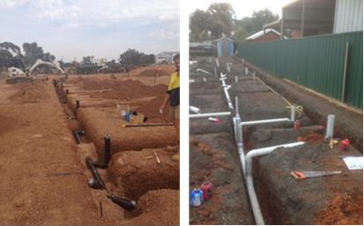
Figure W 4: Examples of Plumbing and Drainage Installations in residential developments
16.3.7. Metropolitan Areas
Most plumbing bookings of on-site sanitary underfloor and drainage inspections are undertaken in the metropolitan areas and include sanitary underfloor and drainage inspections, related to residential and commercial developments.
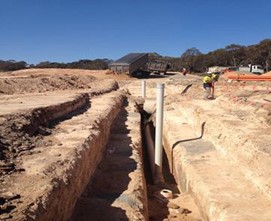
Figure W 5: Commercial Drainage Installation
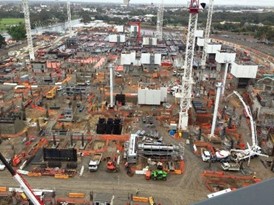
Figure W 6: New Royal Adelaide Hospital under construction
16.3.8. Regional Areas
The Technical Regulator has maintained a regulatory presence in regional areas through programmed audits of on-site plumbing. The Technical Regulator has one full- time Regional Plumbing Installations Inspector based in Port Pirie. This inspector conducts audits of plumbing installations north of Adelaide including the Mid North and Eyre Peninsula regions.
Regional areas including the Barossa, Murraylands and the Southeastern areas of the State are monitored by Adelaide-based plumbing installations inspectors. This requires targeted regional visits to areas such as the Riverland, Kangaroo Island, Mount Gambier, Port Lincoln and the Yorke Peninsula.
The Technical Regulator is dedicated to ensuring the integrity of the State’s drinking water supply and continues to highlight non-compliance issues and provide standard updates to the Department for Health and Wellbeing and those local councils responsible for auditing on-site wastewater systems where the plumbing and equipment are not connected to SA Water’s sewerage/water infrastructure.
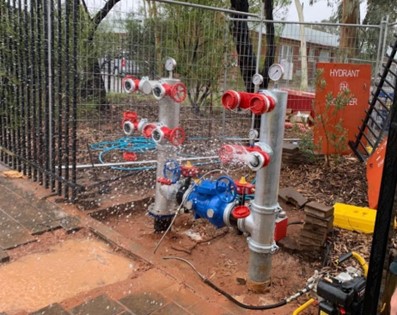
Figure W 7: Technical Regulator audit of inground fire system
16.4. Non-Drinking Water (Recycled Water)
Non-drinking water is water that has been generated from sewage, greywater or stormwater systems and treated to a standard that is appropriate for its intended use. In South Australia, recycled water is typically provided by a water industry entity through a reticulated water network system to dedicated properties for use. Most properties supplied with recycled water have a dual supply consisting of a drinking water supply for personal hygiene use and a non-drinking water supply (recycled water) for gardens and non-personal hygiene use.
In South Australia, the number of non-drinking water sources has increased with many residential developments (i.e. subdivision) adopting dual water reticulation services to properties. Consequently, this has dramatically raised the risk to the technical and safety integrity of on-site plumbing and non-drinking water infrastructure systems. Ensuring a safe drinking water network is paramount to the health of the community which is why non-drinking water systems require appropriate management systems to be in place to prevent cross-connection of drinking and non-drinking water supplies.
Water industry entities, consultants, landscapers, irrigators, plumbers and property owners involved with non-drinking water systems are to comply with requirements as set out in the Water Industry Act 2012 and associated legislation. The Technical Regulator conducts numerous training and education sessions with the industry to raise awareness of their responsibility to ensure non-drinking water system installations are compliant.
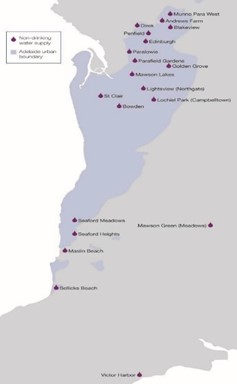
Figure W 8: Areas of metropolitan Adelaide with non-drinking water
Systems can vary in complexity, and it is imperative that the industry is made aware of their obligation to ensure the integrity of both the water infrastructure and on-site plumbing systems. The requirement to upskill plumbers in this particular area has become evident through the number of non-compliant non-drinking water installations audited by the Technical Regulator.
All non-drinking water infrastructure and plumbing installations require appropriate warning and prohibition signage indicating that the non-drinking water is not suitable (fit) for human consumption in accordance with AS 1319 as shown below.
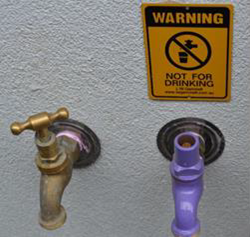
Figure W 9: example of non-drinking water signage
The Technical Regulator requires the submission of a detailed plan for all sites with multiple water supplies. These must include information showing appropriate backflow prevention devices and accurate hydraulic designs showing there are no cross- connections between the drinking and non-drinking water services.
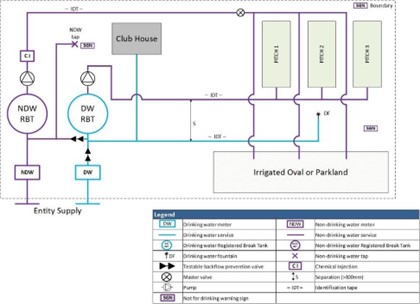
Figure W 10: Typical irrigation installation with Registered Break Tanks installed on both water systems
Figure W11 demonstrates a typical drinking water/non-drinking water installation on a community title development with appropriate signage and physical separation of services.
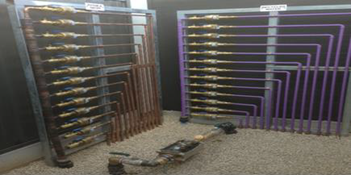
Figure W 11: Drinking and non-drinking water meters
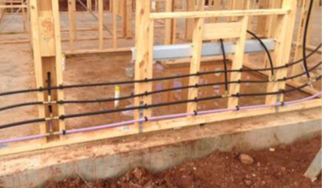
Figure W 12: Plumbing installation showing in-wall non-drinking and drinking water pipework
16.5. Fire Fighting Water Services
16.5.1. Compliance of fire hydrant water services
The Technical Regulator regulates in-ground fire water service installations. Fire hydrant water services must comply with the PCA and referenced Standards AS/NZS 3500.1 – Water Services and AS 2419.1 – Fire Hydrant Installations – System Design, Installation and Commissioning.
The current Standard requirements mandate that a booster assembly is constructed with WaterMarked products i.e. isolating and backflow prevention valves. There is also a requirement that all materials upstream (inlet side) of the backflow prevention valve be suitable for contact with drinking water. This requirement is covered by AS/NZS 4020 – Testing of products for use in contact with drinking water. Where existing fire services are replaced or upgraded, they must meet current regulatory requirements.
The Technical Regulator has audited many sites where major additions and alterations have required fire hydrant water service extensions and, in turn, an upgrade to the inlet/booster connections. These audits, along with advice from the Technical Regulator, have resulted in a higher level of compliance in this area. The audits are to ensure the correct pipework including the backflow prevention device is installed and the system is hydrostatically tested at 1,700 KPa for a period of two hours.
Following the audit, the contractor must submit a plan of the work carried out along with a Certificate of Compliance to the OTR. This information is then forwarded to the Metropolitan Fire Service who then conduct a flow test of the system.
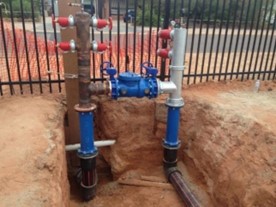
Figure W 13: Fire Service Installation with Backflow Prevention Device
16.5.2. Example of a variation to a fire hydrant booster
Fire hydrant booster assemblies can vary depending on the requirements for a particular site. The Technical Regulator conducts sample audits of these installations to ensure they comply with the appropriate Standards. An example of a combined fire and sprinkler service connected within the booster assembly installed with compliant valves is shown in Figure W13.
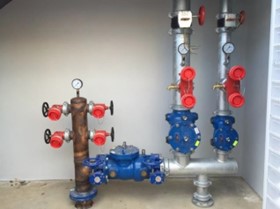
Figure W 14: Variation to a standard fire hydrant booster service
There are several aspects of this combined fire booster which have been designed to comply with the performance requirements of the NCC. The installation includes a WaterMarked testable backflow prevention device on the inlet or upstream side of the connection to the Water Entity’s supply. The feed hydrant riser is constructed of copper which is compliant with AS/NZS 4020, the Standard for “Materials in contact with drinking water”.
All valves in the combined booster assembly are required to be WaterMarked, including the backflow prevention full flow, non-return and isolating valves.
16.6. Cross-connection Control and Backflow Prevention
The Technical Regulator monitors drinking water and non-drinking water service installations for compliance with the performance requirements of the National Construction Code Volume Three. The Technical Regulator’s Cross-Connection and Backflow Prevention Program is the primary method of ensuring that testable backflow prevention devices are installed to protect the integrity of the drinking water supply.
The National Construction Code Volume 3 specifies the performance requirements for drinking and non-drinking water systems. AS/NZS 3500.1 is the deemed-to-satisfy provisions for ensuring the performance requirements are achieved.
AS/NZS 3500.1 defines a cross-connection as any connection or arrangement, physical or otherwise, between any drinking water supply either directly or indirectly connected to a water main, and any fixture, storage tank, receptacle, equipment or device through which it may be possible for any non-drinking water used, unclean, polluted or contaminated water, or any other substance, to enter any part of a drinking water supply.
For example, a cross-connection in a residential house can be described as a connection between a household drinking water supply and a contaminated source such as an unprotected irrigation system where pesticides or fertilizers can enter the drinking water system or the installation of douche toilet seat without appropriate backflow prevention devices being installed.
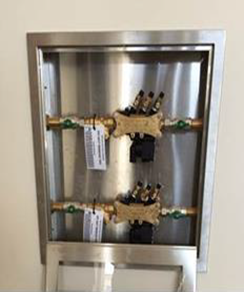
Figure W 15: Reduced Pressure Zone Backflow Devices in in-wall stainless steel tundish box
The Technical Regulator maintains a register of over 30,000 backflow prevention devices installed on drinking water services throughout South Australia. Each device is registered on the system when it is installed, and a reminder letter is sent to the property owner each year to have the device retested to ensure the device is functioning correctly. Audits of backflow prevention devices are undertaken to ensure they are installed in accordance with the National Construction Code Volume Three and associated Standards.
Use of non-drinking water for irrigation purposes
The use of non-drinking water for irrigation of municipal parks and gardens, sports fields and school ovals has significantly increased over the last few years. The primary reason for the increased uptake of non-drinking water for such usage is sustainability and the efficient use of an alternative, cost-effective product. The availability and uptake of non- drinking water for irrigation has led to increased regulatory involvement of the Technical Regulator to ensure the ongoing safety in both plumbing and broad-scale irrigation systems.
The Technical Regulator has established technical sample monitoring to ensure that inter-connections between drinking and non-drinking water supplies are installed with appropriate backflow prevention devices. This requirement has been articulated through communication sessions with industry (see Section 16). Ongoing communication has focused on engaging directly with industry stakeholders to ensure compliance measures are adhered to.
16.7. Property Interest Reporting and Data Management
16.6.1. Property interest reporting
The Technical Regulator is required to disclose required information on the sale or change of ownership of a property under section 12 of the Land and Business (Sale and Conveyancing) Act 1994, regulation 16 of the Land and Business (Sale and Conveyancing) Regulations 2010 and regulation 12 of the Regulations. The Technical Regulator provides interested persons with information relating to encumbrances registered against a particular property. These encumbrances are comprised mostly of Backflow Prevention Devices (which require annual maintenance) and general non- compliant plumbing work.
The Technical Regulator receives daily correspondence from the Land Services Group (LSG) relating to the sale, potential sale or change of ownership of a property. The Technical Regulator is required to respond to the interested party within seven days.
16.6.2. Enforcement and Encumbrance Notices
The Technical Regulator places a notice on a property where plumbing audit results confirm a serious technical or safety issue associated with the on-site plumbing or where a backflow prevention device has been installed in connection with a drinking water service. Encumbrances held by the Technical Regulator relate to backflow prevention devices. The remaining enforcement notices relate to non-compliant plumbing and drains crossing boundaries. These notices are registered on the South Australian Integrated Land Information System (SAILIS). A notice will remain on a property until the plumbing work is made compliant or the Backflow Prevention Device is no longer required.
16.6.3. Self-management of testable backflow prevention devices
The Technical Regulator has implemented a policy for the management of testable backflow prevention devices located on State Government and local Council properties. The policy allows the South Australian Government and local Councils to manage the testing and maintenance of their own backflow prevention devices.
Following consultation with several local Councils, the Technical Regulator saw an opportunity for customers to reduce administrative costs and produce a maintenance schedule suitable to their specific needs. Most Government departments and local Councils already maintain appropriate databases which made resubmitting details to the Technical Regulator repetitive and time consuming. The objective of the policy was to simplify administrative requirements for Government Agencies, local Councils and the Technical Regulator through a reduction of reporting requirements associated with testable backflow prevention devices maintenance. The Technical Regulator has approached relevant customers individually and worked collaboratively with them to promote self-management of their Backflow Prevention Device test records. Instead of sending all test records to the Technical Regulator at the time of testing, Government Agencies and local Councils will manage their own backflow devices. The Technical Regulator will conduct desktop and site audits at pre-determined intervals throughout the year to ensure compliance.
The response from customers has been overwhelmingly positive. One local Council wrote to the Technical Regulator stating that the ‘benefits for Council are quite significant’ and was appreciative of the Technical Regulator in recognising them as a suitable candidate for the introduction of the self-management project.
One of the key requirements of implementing the Self-Management system is that the government department or local Council has no backflow devices that are delinquent or overdue for retest. The strong desire to self-manage is encouraging customers to keep all devices appropriately maintained. The Technical Regulator will continue to work with State and Local Government to explore more opportunities for the self-management of testable backflow prevention devices.

Figure W 16: Example of a section of a backflow management template
Section 17: Consumer Safety Awareness
17.1. Plumbing advisory notes
The Technical Regulator produces advisory notes to help people working in the plumbing industry interpret the requirements for on-site plumbing installations. Those notes are available on the website and refer to specific issues such as hydraulic submission applications and general plumbing and equipment installation requirements.
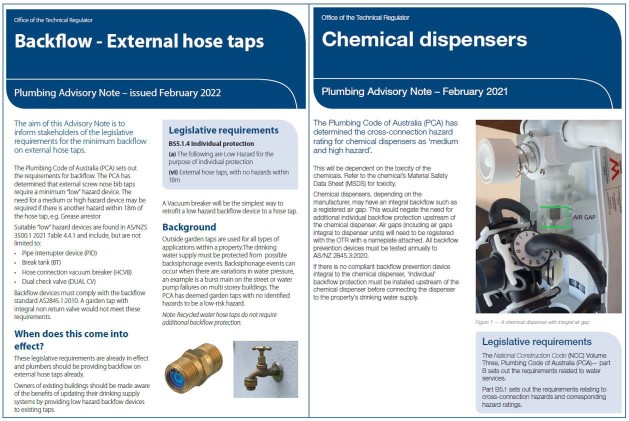
Figure W 17: Examples of Plumbing Advisory Notes
17.2. Training Sessions for Water and Plumbing Industries
Regular training, consultation and information sessions are conducted with the water and plumbing industries.
The Technical Regulator uses these training sessions as an opportunity to discuss and clarify changes to regulatory Standards and practices. Examples of training session topics include:
- Updates on changes to National Construction Code Volume 3 – Plumbing Code of Australia (PCA).
- Updates to the AS/NZS 3500 Plumbing and drainage Standard series which include Water Services, Sanitary Plumbing & Drainage, and Heated Water Services.
- Safety and technical requirements for Non-drinking Water in South Australia.
- Technical issues such as sanitary drainage, non-Drinking Water installations, Legionella Control, Fire Service installations, Backflow Prevention for irrigation systems, WaterMark compliance and Water Efficiency Labelling Compliance (WELS).

Figure W 18: Training session conducted by the OTR plumbing section at Tonsley TAFE.
The Technical Regulator has strong relationships with the following groups and is regularly engaged to conduct or attend information sessions:
- Plumbing Industry Reference group (TAFE SA).
- Department for Health and Wellbeing.
- Master Builders Association Technical Committee.
- Backflow Prevention Association of Aust.
- Hydraulic Consultants Association (HCAA).
- PlanSA.
- Master Plumbers Association of SA Inc.
- The Commission.
- Peer Training Reference Group.
- Australian Building Codes Board.
- SA Water.
- Local Government Association of SA.
- Backflow Prevention Association of Australia.
- Regional Local Government Groups.
- Water Industry Technical Advisory Committee.
- Fire Industry Association (FIA).
- Country Fire Service (CFS).
- Australian Water Association (AWA).
- Building Consultants Forum.
- Metropolitan Fire Service (MFS).
- Water Industry Alliance (WIA).
- Wastewater Special Industry Group (Environmental Health Officers).
Master Plumbers Association of South Australia Inc. (MPA)
The Technical Regulator consults with the MPA on a regular basis and has utilised their forum to improve plumbing regulation including conducting presentations at their regional and local Roadshows. The Technical Regulator has also collaborated with the MPA to actively address regulatory issues, licensing matters, the electronic Certificate of Compliance project and continuing professional development. The Technical Regulator provides regular articles for the MPA’s Plumbing SA newsletter and is represented on the MPA selection panel for the Plumbing Gold Medal Award which is presented annually to the Apprentice of the Year.
Hydraulic Consultants Association Australasia (HCAA) (South Australia)
The Technical Regulator actively engages with members of the HCAA and seeks their input into proposed amendments to the Plumbing Code of Australia and associated Standards. Attendance at meetings provides the Technical Regulator with the opportunity to clarify issues as they are presented. The Technical Regulator has conducted presentations on non-drinking water and fire service installations.
Wastewater Special Industry Group (Environmental Health Officer)
The Wastewater Special Industry Group comprises predominately of Environmental Health Officers (EHO’s) and SA Health Officers who monitor on-site wastewater treatment systems. The Technical Regulator provides updates on the National Construction Code Volume 3 and associated Standards. Presentations have been made on the electronic Certificate of Compliance project and the as-constructed drainage plan project. The Technical Regulator engages with EHO’s in regional areas and provides training on regulatory and on-site plumbing requirements. Training has been provided for EHO’s in the South-East Region, York Peninsula and Kangaroo Island.
The Plumbing Industry Reference Group (PIRG)
PIRG is an Industry Reference Group. PIRG members represent various sectors of the plumbing industry including the Technical Regulator, MPA, Plumbing Contractors, the Construction Industry Training Board, manufactures and apprentice providers.
The committee meets quarterly to discuss matters that affect the training of apprentices which includes discussion on the following topics:
| E-Learning. | Reporting on the training package. |
| Licensing matters. | Quality and Industry Validation. |
| Training and information sessions conducted to staff and students by the Technical Regulator. |
Training Gaps. WHS. |
| Continual professional development. | Business Development. |
Building industry technical advisory committees
The Technical Regulator is involved with the Master Builders Association (MBA) and the Housing Industry Association (HIA) technical committees. The Technical Regulator provides information and advice to the MBA and HIA on plumbing regulation in South Australia.
SA Water Industry Regulators
The Technical Regulator has operational agreements and Memoranda of Understanding (MOUs) with key intra-government water regulatory agencies. These agreements and MOUs are intended to promote a streamlined regulatory process for the water industry by working with other government agencies to optimise each agency’s regulatory input. Furthermore, the Technical Regulator has been fundamental in the development of an intra-government water regulatory consortium, where agencies are able to share key information about their current operations and any impacts of the water industry and/or other agencies. The water agencies involved in this consortium are:
- Office of the Technical Regulator.
- Department for Environment and Water.
- Essential Services Commission of South Australia (the Commission).
- Department for Health and Wellbeing.
- Environment Protection Authority (EPA).
Section 18: Water and Plumbing Regulatory Coordination
18.1. Technical Standards
The Technical Regulator has the power to publish Standards relating to infrastructure or equipment that is used, or is capable of being used, in the water industry under section 66 of the Water Industry Act 2012.
18.1.1. Water and Sewerage Infrastructure Technical Standards
The Technical Regulator has published an Infrastructure Standard which adopts the Water Services Association of Australia (WSAA) codes as the principle minimum Standard for water and sewerage infrastructure.
Water Services Association of Australia (WSAA)
The Water Services Association of Australia (WSAA) has developed National Codes (WSAA Codes) for the urban water industry detailing performance requirements for design, installation, inspection, alteration, repair, maintenance, removal, disconnection or decommissioning of water and sewerage infrastructure. The WSAA Codes have been widely adopted by water utilities across Australia and the water industry. The WSAA Codes allow for water industry entities to make appropriate modifications (where necessary) to accommodate their needs and preference as well as local construction practices and products.
The Department for Health and Wellbeing, Local Government Association and Environment Protection Authority also have technical Standards, codes and guidelines for the water industry, in particular related to the design and installation of CWMS.
The Technical Regulator has identified the WSAA Codes, and any technical Standard, code or guideline stated in legislation as suitable Standards for the South Australian water industry. These codes, Standards and guidelines are referenced during the review and approval of water industry entities’ SRMTMPs, and for the provision of advice in relation to safety or technical matters to the water industry.
If an alternative Standard is proposed, it is necessary for the water industry entity to identify all potential risks and develop associated mitigation measures and approaches to reduce or eliminate the relevant risks. Following the receipt of this information, the Technical Regulator will then determine whether the alternative approach adequately meets the required performance outcome.
18.1.2. Plumbing Technical Standards
The Technical Regulator has published a Plumbing Standard under section 66 of the Water Industry Act 2012 that provides the basis for calling up the relevant sections of the National Construction Code (NCC) Volume 3 – Plumbing Code of Australia (PCA) (see Appendix 9).
National Construction Code (NCC)
The NCC is an initiative of the then Council of Australian Governments (COAG), developed to incorporate all on-site construction requirements into a single code.
The NCC is model regulation developed by the Australian Building Codes Board (ABCB) and takes effect through legislation of the States and Territories which administer and enforce building and plumbing regulation.
Building regulation is covered in Volumes 1 and 2 – the Building Code of Australia (BCA). Volume 3 covers plumbing regulation – the Plumbing Code of Australia (PCA).
Australian Building Codes Board and Plumbing Code Committee
The Plumbing Code Committee (PCC) is the ABCB’s peak plumbing technical advisory body. The PCC is a valuable national forum through which regulatory authorities and industry consider technical matters relevant to plumbing regulatory reform and plays an active role in assisting the Board in meeting its obligations under the Guidelines and the Inter-Government Agreement.
The PCC operates in alignment with the ABCB’s Building Codes Committee (BCC) to ensure a coordinated approach to building and plumbing regulatory reform. The Technical Regulator regularly provides agenda items for discussion at PCC meetings. Issues including sanitary drainage, non-drinking water, fire service installations and water services have been presented to the committee with recommendations for amendments to the Plumbing Standards.
The NCC Series is drafted in a performance format allowing a choice of Deemed-to- Satisfy Solutions or the flexibility to develop Performance Solutions (refer to the figure below).
One of the essential elements for introducing a performance mind-set is to re-educate the plumbing industry on the methods of achieving compliance by analysing the Performance Requirements against the standard Deemed-to-Satisfy Solutions and the Performance Requirements in the PCA.
The ABCB is undertaking a project to quantify plumbing and drainage performance. The information gathered from this project will allow the ABCB to develop existing performance requirements set out in the PCA into simpler, more measurable expression. The resulting performance requirements will be included in the next PCA edition due to be published in 2022.
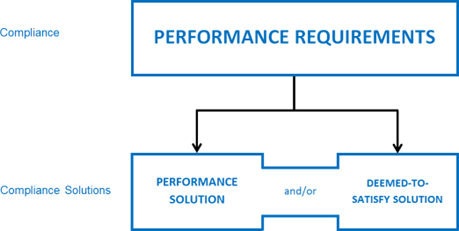
Figure W 19: NCC Compliance Structure
WaterMark Certification Scheme
The WaterMark Certification Scheme is a mandatory certification scheme for plumbing and drainage products to ensure that plumbing and drainage materials and products are fit for purpose and appropriately authorised for use in plumbing installations. The WaterMark Scheme is administered by the ABCB; the PCC, as the primary plumbing technical advisory committee, is regularly engaged to comment on changes to the Scheme.
The ABCB released a new improved WaterMark Scheme on 1 July 2016. The new WaterMark Scheme Product Database has also been published on the ABCB’s website. This database is based on a single material and product certification level (where previously there were 2 levels of certification).
The aim of the revised Scheme and database is to streamline requirements, processes and enforcement creating a reliable, consistent and level playing field for scheme participants and mitigating risks to the ABCB. This enables the scheme to deliver plumbing and drainage products that are safe and fit for their intended use in and around buildings in an environment that is increasingly challenged by reduced resources for enforcement, increased product non-conformity and an ever-expanding global market.
AS/NZS 3500 Plumbing and Drainage Standard
Standards Australia has recently updated the following sections of the AS/NZS 3500 Plumbing and drainage Standard:
Revision of AS/NZS 3500 series:
| Part 1 Water services. | (version published 28th May 2021) |
| Part 2 Sanitary plumbing and drainage. | (version published 28th May 2021) |
| Part 4 Heated water services. | (version published 28th May 2021) |
| Part 5 Housing installations. | (Part 5 has been discontinued) |
The AS/NZS 3500 Plumbing and Drainage Standard Series is prepared by Standards Australia to provide plumbers with Deemed-to-Satisfy Solutions to comply with the Performance Requirements of the PCA. The WS-014 Committee assists Standards Australia in the administration of the AS/NZS 3500 Series.
18.1.3. OTR Guidelines
Non-Drinking Water Guidelines
The Technical Regulator released non-drinking water guidelines titled Guidelines for Non-drinking Water in South Australia. The guidelines were developed for the water and plumbing industries and are applicable to all non-drinking water installations in South Australia.
The guidelines are presented in three parts and outline requirements and responsibilities for installing, operating and maintaining non-drinking water systems in accordance with the Water Industry Act 2012, the Regulations, and appropriate technical Standards, and will be used by the plumbing and water industries, water industry entities and property owners with a non-drinking water supply.
18.2. Committee Representation
The Technical Regulator provides expert technical input for the revision of key Standards through representation of the following Standards committees:
| ABCC | Australian Building Codes Plumbing Codes Committee |
| WS-014 | Plumbing and Drainage Standard – Part 1 – Water services |
| WS-014 | Plumbing and Drainage Standard – Part 2 – Sanitary plumbing and drainage |
| WS-014 | Plumbing and Drainage Standard – Part 4 – Heated water services |
| WS-039 | Mirror Committee for ISO/TC 275 - Sludge recovery, recycling, treatment and disposal |
| WS-041 | Mirror Committee for ISO/TC 224 – Service activities relating to drinking water supply systems and wastewater systems - Quality criteria of the service and performance indicators |
Appendix
Appendix 1: OTR Activity Report – 2022-2023
This is an activity report that describes the operations of the Technical Regulator in the Electrical, Gas, Plumbing and Water industries over the 2022-2023 financial year.
The Technical Regulator is a statutory office established by:
- Section 7 of the Electricity Act 1996. Robert Faunt has held this office since he was appointed as the Technical Regulator under the Electricity Act 1996 on 28 February 2003.
- Section 7 of the Gas Act 1997. Robert Faunt has held this office since he was appointed as the Technical Regulator under the Gas Act 1997 on 28 February 2003.
- Section 8 of the Water Industry Act 2012. Robert Faunt has held this office since he was appointed as the Technical Regulator in 2012.
Technical Regulator: Robert Faunt
Address: Level 8, ANZ Building
11 Waymouth Street
Adelaide 5000
Postal Address: GPO Box 320 Adelaide SA 5001
Telephone: (08) 8226 5500
Facsimile: (08) 8226 5529
Office Hours: 9 am to 5 pm, Monday to Friday (except public holidays)
Website: www.sa.gov.au/otr
Email: DEMOTRMail@sa.gov.au
ISSN: 1832-8687
Note: All photographs in this report have been used with the permission of the relevant provider.
Overall Activities for 2022-2023
Section A1: Overall Activity
1.1. Electronic Certificate of Compliance (eCoC)
Certificates of Compliance are an instrument used to demonstrate that an installation is compliant and can be used by a property owner to demonstrate that they have met their duty to ensure that their property is safe. The electronic Certificate of Compliance (eCoC) system was launched for registration only in August 2016 and for the creation and submission of eCoCs in January 2017. Following an 18-month transition; paper certificates were discontinued on 30 June 2018. Usage of eCoCs rose sharply after 30 June 2018, while new registrations peaked at 1,200 – 1,500 registrations per month in June and July 2018.
In recent years, new registrations have stabilised at around 1,200 – 1,400 electrical registrations per year, and between 300 – 400 registration per year for the plumbing and gas industries. The lower registration numbers for 2022-23 may be partly explained by a system error affecting the self-registration system between February- July of 2023, and requiring a manual process to complete registration. The automated self-registration system has since been resolved and future statistics will be expected to show whether this dip in registrations was due to the error, lower numbers of industry licensees or a combination of both factors. These statistics are
summarised for the last five financial years in the table below.
Table A1 1: Electronic Certificates of Compliance statistics as of 30 June 2023
| Electrical | Gas | Plumbing | Total | ||
Submitted eCoCs | 2018-19 | 293,244 | 28,591 | 20,251 | 342,086 |
| 2019-20 | 318,442 | 31,021 | 26,672 | 376,135 | |
| 2020-21 | 401,659 | 36,180 | 35,227 | 473,066 | |
| 2021-22 | 340,837 | 28,201 | 31,445 | 400,483 | |
| 2022-23 | 341,375 | 26,203 | 31,930 | 399,508 | |
| Total eCoCs | 1,695,557 | 150,196 | 145,525 | 1,991,278 | |
New Licences Registered | 2018-19 | 4,609 | 1,380 | 1,425 | 5,195 |
| 2019-20 | 1,728 | 425 | 434 | 2,587 | |
| 2020-21 | 1,285 | 324 | 341 | 1,950 | |
| 2021-22 | 1,457 | 428 | 463 | 2,348 | |
| 2022-23 | 972 | 215 | 224 | 1,405 | |
| Total Licences | 15,334 | 4,615 | 4,800 | 18,492 (Unique Licensees) |
Note: Total eCoC and License numbers are since eCoC records began in January 2017 and August 2016 respectively. Note that many licences permit the holder to work in several industries, and so these licences contribute to the figures in several industry columns but are counted only once in the total.
eCoC submission rates have since increased year-on-year, exceeding the annual volume of paper certificates which were printed before the introduction of eCoC. When considering wastage associated with correcting paper certificates, this trend indicates increasing levels of compliance within industry. The Technical Regulator now receives up to 35,000 electrical eCoCs each month. Plumbing and gas work generates fewer certificates, up to 2,500 and 3,000 each month respectively as seen in the figure below.
While rates of eCoC submission had continued to increase compared to earlier years throughout the COVID-19 restrictions in place throughout 2020 to 2022, indicating that levels of industry compliance and number of certified installations endured minimal impact due to the pandemic. Subsequently, the figure below shows that since FY 2020-2021, the number of eCoC submissions has stabilised to more consistent rates (with seasonal variability). The vast majority of eCoCs relate to electrical work as can be seen in the comparative axes of of Figure A1-1.
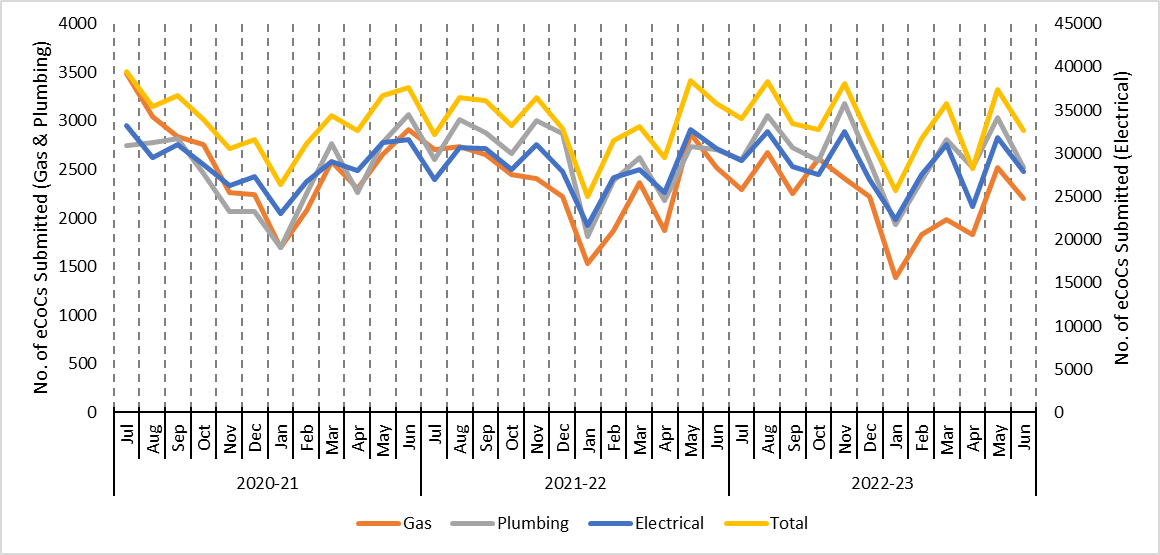
Figure A1 1: Electronic Certificate of Compliance Submission Rates by Industry
Note that Gas and Plumbing eCoC submissions are plotted on the primary vertical axis while Electrical and Total eCoC submissions are plotted on the secondary axis. This reflects the approximate 10 times rate of Electrical eCoC submissions vs other installation types.
The eCoC platform is free of charge and is available on a range of devices, allowing tradespersons to complete the form on site using their smartphone, tablet or computer. The OTR continues to provide eCoC user support through the otr.ecoc@sa.gov.au inbox and a dedicated support phone number, staffed on business days, from 8:30-4:00 PM. Common issues, user registrations and advice on account set-up is provided through these services as well as providing valuable user feedback, system error reporting and suggestions for new features or tools on the eCoC platform.
Automatic Mutual Recognition (AMR) of Interstate Licenses
AMR is a federal government led program intended to enable workers who need to be licensed or registered to take up new work opportunities across most of Australia. AMR allows workers to use their home state’s current licensing in other jurisdictions without having to apply or pay for a new license in that state or territory. AMR commenced in South Australia on 1 February 2022 through Consumer and Business Services (CBS) register. Interstate plumbers, electricians and gas fitters using the AMR scheme to work in South Australia can contact the OTR after registration with CBS in order to have a user profile created in the eCoC system, allowing AMR participants to fulfill their worker and contractor obligation is South Australia and create and submit eCoC documentation for any work undertaken. To date, 19 accounts have been registered for eCoC systems under AMR arrangements, allowing a range.
1.2. Emergency Management
In 2022-2023, no declaration of an Electricity Supply Emergency was made pursuant to the Emergency Management Act 2004 and nor were any emergency declarations made under the Gas Act 1997 or the Petroleum Products Regulation Act 1995.
Weatherwise, the 2022-2023 summer season was only slightly warmer than average from a temperature perspective, however there were events that resulted in significant damage to electricity infrastructure. The most significant events in 2022- 2023 consisted of:
- 12 November 2022 severe storm event;
- 20 December 2022 severe storm event;
- 20 March 2023 gully winds event; and
- River Murray flooding December 2022 – February 2023.
An organised line of severe thunderstorms associated with a complex low-pressure system and troughs moved through Adelaide and South Australia late in the afternoon on Saturday 12 November 2022, causing the felling of large trees and widespread damage to infrastructure. This included the felling of a transmission tower on a transmission line which joins into the Heywood interconnector south of Tailem Bend. South Australia was then operating as an electrical island until the restoration of the Heywood interconnector with temporary transmission towers. This necessitated personnel from the Office of the Technical Regulator being involved as departmental Support Agency staff during activation of the State Emergency Centre as well as assisting with coordination across government to help respond to the electricity supply and demand conditions. South Australia remained electrically separated until Saturday 19 November 2022.
On Tuesday 20 December 2022, severe thunderstorms passed through the northern part of the State, with transmission towers on the Davenport to Pimba transmission line experiencing severe damage. Supply was lost to the townships of Pimba and Woomera and was restored on Friday 23 December 2022. The Office of the Technical Regulator was updated with the impacts from the event and with respect to supply restoration.
While gully winds are not uncommon in Adelaide, an event during the morning of Monday 20 March 2023 saw damaging gully winds develop mainly along the Adelaide Hills face zone. This event brought down numerous trees and powerlines, with around 33,000 distribution network customers affected. Supply was progressively restored as repairs could be effected by SA Power Networks.
In relation to the Murray River, major flooding occurred along the length of the river in South Australia from December 2022 through to February 2023. Approximately 3,360 connection points were disconnected by SA Power Networks for safety reasons at the peak of the event and a number remain disconnected. These will likely remain disconnected for an extended period of time due to the extent of damage to dwellings (which in many cases are awaiting structural assessments).
Power is available on the network to the property boundary for nearly all properties. This event necessitated personnel from the Office of the Technical Regulator being involved as departmental Support Agency staff during the lengthy activation of the State Emergency Centre as well as assisting with coordination across government and with electricity utilities.
More broadly, the Office of the Technical Regulator maintains well-developed relationships with the Australian Energy Market Operator (AEMO), State and Territory Governments and the Australian Government, as well as other bodies such as the Bureau of Meteorology to help facilitate information flows and maintain situation awareness in relation to power and gas system issues. Where possible, the Office of the Technical Regulator will collaborate with other agencies for mutual benefit, for example as we have with the Bureau of Meteorology in relation to their research into the climatic impact of heatwaves on energy infrastructure.
The Office of the Technical Regulator monitors the National Electricity Market in real time, receives information from AEMO at least weekly in relation to supply and demand projections, and reports on the status of the power system weekly. The Office of the Technical Regulator also closely monitored developments in relation to weather, international developments such as the ongoing war in the Ukraine, and generator availability in energy markets.
The Office of the Technical Regulator also monitors the natural gas and liquid fuel industries and prepares regular periodic reports on the state of these industries and supply levels.
Personnel from the Office of the Technical Regulator have participated in emergency management exercises over the last twelve months, including the annual exercise with respect to electricity and gas coordinated by AEMO, a national liquid fuel emergency exercise coordinated by the Australian Government, and emergency management exercises held more generally by SA Police.
1.3. Consumer Safety Survey
For 2022-2023, the key outcomes and reporting from the Consumer Survey included:
- Across the sample, 31% recall seeing at least one form of OTR advertising, a slight increasing compared to last year (26%), and more in line with previous wave (2021 [42%] and 2020 [30%]).
- The top three messages that survey participants recalled seeing or hearing were: “use licensed trade” (21%); “electrical, gas and plumbing appliances and fitting must be certified for use in Australia” (16%), and “avoid scalding from hot water” (14%). The other two messages, “beware of toxic carbon monoxide in your home” and “check BBQ gas connection before every use” obtained the lowest recall (13% and 12% respectively).
- Online/internet (44%) and Facebook (40%) remained the most significant sources of advertising platforms over the last three years. Billboard (28%) was another source of advertising that performed well.
- 70% of the survey respondents indicated they were aware of the dangers of Carbon Monoxide (CO) poisoning from malfunctioning gas appliances/installations in enclosed spaces, similar to previous years. However, only 24% service their gas appliances at least every two years.
- The proportion of respondents who never service their gas appliances are higher for those who are aware of the risks of CO poisoning, while those not aware tend to service their gas appliances less frequently.
- Knowledge of safety management, awareness of CO poisoning and where to report gas leaks generally observed similar measures to previous years.
- Amongst those who had work done on their property in the last 12 months: 84% were aware that the law requires a plumber to hold an appropriate license. 85% were aware that the law requires an electrician to have an appropriate license, and 83% were aware that the law requires a gas fitter to hold an appropriate license. These results were similar to the percentage obtained in previous years.
- Generally, recall of all safety messaging has increased from 2022. However, knowledge of safety behaviours, such as regularly checking electrical appliances, has decreased and regularly check my gas appliances has stayed similar to last year.
- A large portion of the sample, 34%, never test their electrical safety switch or service their gas appliances; however, testing of electrical safety switches remains the most frequent behaviour.
- 40% of the respondents have had their electrical wiring inspected by licensed electrician whereas 48% had not.
- 70% of respondents who ever had their electrical wiring inspected by a licensed electrician received a report of electronic Certificates of Compliance. 21% of those who never had their electrical wiring inspected had considered doing so.
- Provision of Certificates of Compliance for plumbing work has seen a significant decrease after seeing a consistence increase over the last 3 years. Provision of Certificates of Compliance for electrical work has been increasing consistently over the past years. Whereas provision of Certificates of Compliance for gas work has increased significantly.
- Awareness of the law requiring electricians to hold appropriate licensing and provide customers with a Certificate of Compliance upon completion has decreased slightly.
- Awareness of law that requires plumbers to hold appropriate licensing, provide a Certificate of compliance upon completion and diagram showing any new sanitary drain location has remained consistent since 2020.
- Awareness of law that requires gas fitters to hold appropriate licensing and provide customers with a Certificate of Compliance upon completion has remained consistent.
- The requirement for tradespersons to be licensed increased significantly (38%) compared to last year (29%).
- Awareness of product safety certification schemes has seen a positive trend emerging from 2020, with a tracking high of 42% in 2023.
- A significant proportion of respondents were not provided with a safety certification (28%) for their online purchase compared to the 2022 sample (27%).
- 86% of the survey respondent understand a Certificate of Compliance for plumbing, electrical or gas work is beneficial for a variety of reasons, most notably as a verification that work is safe and completed by a licensed professional.
- A common theme emerging from responses was that (7%) learnt something about gas, electrical and plumbing safety. 3% believe there is a need for more safety coverage in mainstream media, 2% were interested in learning more and 1% feel existing safety information is either vague or difficult to find.
It is worth noting that the same safety campaign designs were used as 2021-2022. The results were consistent with the last few years, indicating that demographic factors may influence safety attitudes and behaviours. The Technical Regulator has considered this feedback and will be designing the next safety campaign and the messages.
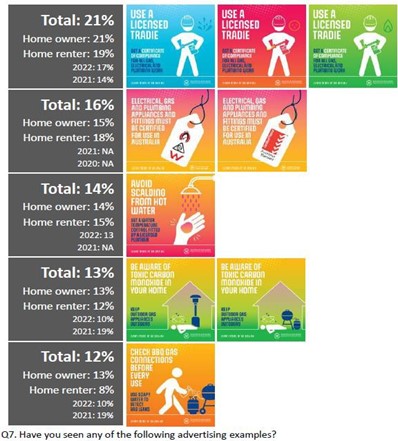
Figure A1 2: Survey participants recalled seeing or hearing Consumer campaign for 2023
Volume I – Electrical Industry
Section A2: Electrical Infrastructure
2.1. Audits by the Technical Regulator
2.1.1. SRMTMP Field Audits
In 2022-2023 Pelican Point Power Station, Visy Board, Korvest and Safecorp were audited against compliance with their SRMTMP.
The areas audited variously included:
- Training systems.
- Safe Work Systems.
- Contractor management.
- Isolation practices.
- High voltage switching.
- As built drawing management.
- Accident investigation and reporting.
- Maintenance management systems.
Overall, no evidence was found that would indicate that the entities do not generally comply with the processes listed in their respective SRMTMPs. In each case, the OTR provided advice and recommendations to the entity on opportunities for improvement to their processes.
2.1.2. Visy Board Pty Ltd
The Visy Board cardboard box manufacturing facility at Gepps Cross has 5,649 roof mounted solar panels, with an export limit of 1.7 MW. A Tesla Powerpack battery energy storage system (BESS) is also installed.
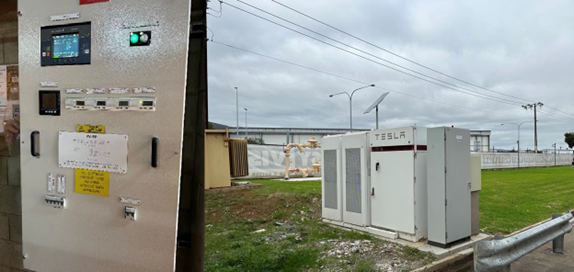
Figure A1 E 1: Visy Board Solar and BESS equipment
2.1.3. Korvest Ltd
The Korvest manufacturing facility at Kilburn has 958 solar panels with an export limit of 200 kVA. The panels are mounted on the roof of two of the site industrial buildings.
2.1.4. Safecorp Group Limited
The Safecorp ESCOSA generation is for 568 solar panels mounted on the roof of the Princes Linen Services processing facility at Gepps Cross. The site is export limited to 199 kW.
2.1.5. Pelican Point Power Station
Pelican Point Power Limited, wholly owned by ENGIE operates the Pelican Point Power Station, a natural gas fired combined cycle gas turbine power station on the LeFevre Peninsula in Adelaide with a total capacity of 490 MW.
OTR officers recommended two opportunities for improvement related to documentation.
2.1.6. Other SRMTMP investigations
In addition to audits of compliance against an entity’s SRMTMP, during the bushfire season OTR staff assist in the State’s emergency management response as Control Agency for energy (or as a Support Agency where there is another Control Agency), and subsequently investigates bushfires where electrical infrastructure may have been involved in starting a major fire, including site visits, data analysis and compliance auditing.
As part of the ongoing monitoring of SA Power Networks’ asset inspection system, OTR officers attended distribution system inspection training as audit students. The course was delivered by SA Power Networks’ training provider, using the same materials as inspectors.
2.2. Generation
The Planning, Development and Infrastructure (General) Regulations 2017 require all new proposed generator plants of greater capacity than 5 MW to seek approval from the Technical Regulator to ensure it meets certain technical requirements to contribute to power system security in South Australia.
Since 1 July 2017, the Technical Regulator has technical requirements that proposed generators must achieve to receive a certificate from the Technical Regulator and progress to the Development Application stage.
The Technical Regulator has worked closely with the industry since these requirements have been put in place and continues to receive numerous generator applications throughout the year. The proposed projects cover a wide range of technologies and complexities. In 2022-2023, the Technical Regulator issued 14 certificates to proposed generators.
2.3. Transmission
2.3.1. Transmission Line Availability
The electricity transmission system transports power from the power stations directly to a series of sub-stations and switchyards, which in turn supply the distribution system and directly connected transmission customers. The major transmission entity in the State, ElectraNet, owns and operates a network of approximately
6,454 circuit kilometres of transmission lines. The network operates at nominal voltages of primarily 275 kV and 132 kV with a smaller number of 66 kV lines. The transmission system also includes around 98 substations and switchyards.
Transmission line availability in 2022-2023 was 99.31%. ElectraNet’s Key Performance Indicators (KPIs) from its SRMTMP are listed in Table K1 in Volume IV.
2.4. Distribution
The distribution network delivers power to consumers. The major distribution network operator, SA Power Networks (SAPN), formerly known as ETSA Utilities, owns and maintains over 90,322 kilometres of overhead and underground distribution lines.
The lines operate at 132 kV, 66 kV, 33 kV, 19 kV (SWER), 11 kV, 7.6 kV and low voltage (400/230 V). The network includes around 400 substations and switchyards.
The South Australian distribution network serves approximately 915,091 customers.
In 2022-2023, fire starts attributed to distribution infrastructure showed a small increase to 0.6 fire starts per 1,000 km of mains. SA Power Networks’ KPIs are provided in Table K2 in Volume IV.
2.4.1. Reliability
The reliability indicator “normalised Unplanned System Average Interruption Duration Index” (USAIDIn) for the SA Power Networks’ distribution system in 2022-2023 was an average of 142.7 minutes per customer. This has increased from 136 minutes per customer reported in the previous year but achieves the service standard implied target of 150 minutes.
The Bureau of Meteorology (BOM) advised of numerous severe weather events in 2022-2023 of which many were categorised as Significant Weather Events (SWE). There were six days classified under the more severe category of Major Event Days (MEDs). Such events pose a major challenge for the reliability and management of the electricity distribution network. These five events contributed 262.2 minutes to USAIDI and are removed from the calculation of normalised USAIDI.
The Technical Regulator is continuing to monitor SAPN’s performance across all areas.
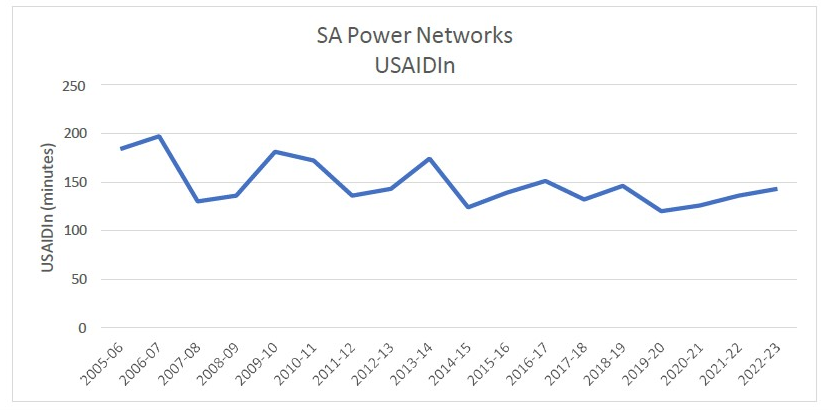
Figure A1 E 2: State-wide Unplanned SAIDI for SA (minutes per customer)
SA Power Networks has excluded the major impact of significant weather events by excluding Major Event Day (MED) performance from the normalised performance. The MED is determined in accordance with the Australian Energy Regulator’s (AER) Service Target Performance Incentive Scheme Guideline which mirrors the IEEE (The Institute of Electrical and Electronics Engineers) Standard 1366.
Includes unplanned interruptions on the high voltage and low voltage distribution network.
The State-wide transmission outage (i.e., Black-start event) occurred on 28 September 2016 and is excluded from the above figures as it was related to a transmission outage.
SA Power Networks also provides quarterly reports to the Technical Regulator which details all major outages in the previous quarter.
2.4.2. Outage Causes
The two major causes of unplanned interruptions across the State during the 2022- 2023 regulatory period continued to be weather and equipment failure. Using the performance measure of USAIDIn, these two causes accounted for 26% and 24% respectively of the interruptions in 2022-2023. Grey-headed flying foxes continue to cause interruptions, especially in the January to March quarter of the year.
The outage causes were generally relatively consistent with the previous years, as causes fall within the normally expected range. The Technical Regulator will also continue to monitor equipment failure reports.
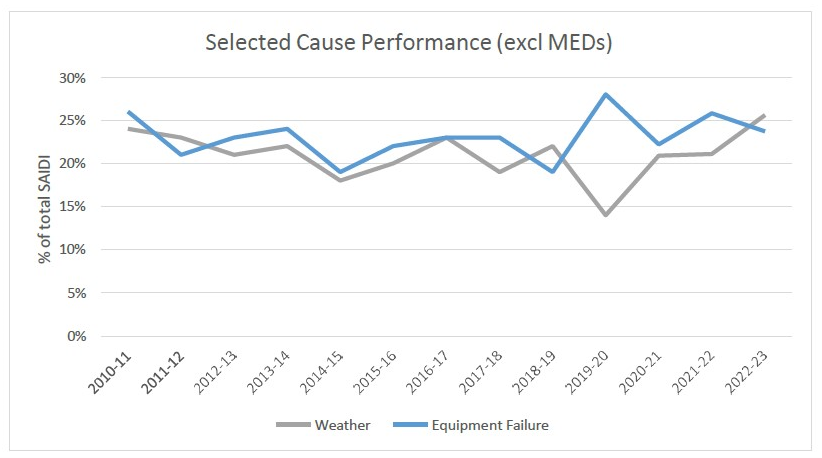
Figure A1 E 3: Contribution to State-wide SAIDI for SA (minutes per customer)
2.5. Safety Clearances to Powerlines
2.5.1. Vegetation Clearance
Planting Lists and Bushfire Risk Areas
The Electricity (Principles of Vegetation Clearance) Regulations 2021 require the bushfire risk areas and the lists of trees approved for planting near powerlines to be published on a website determined by the Technical Regulator. The maps are published on the South Australian Resources Information Gateway at map.sarig.sa.gov.au, and the trees lists on sa.gov.au. No additions to the tree lists were made in 2022-2023.
Alternative Clearance Zones
Clearance zones calculated for a particular powerline span using for example, actual sag and swing characteristics or interpolation near the prescribed span division steps may be determined by the Technical Regulator on application by electricity entities, as an alternative to requiring a prescribed worst-case clearance distance for each voltage to be used. No successful applications to the Technical Regulator were made in 2022-2023.
Risks associated with Vegetation near Powerlines
Falling vegetation continues to be a major factor in electricity outages. Damaged powerlines are a risk that can lead to sparking, and fires along with a risk of electric shock. In recent times, damage to electricity infrastructure due to falling trees and other vegetation – at times from outside the prescribed clearance zone – has led to major bushfires.
These incidents highlight the risks associated with vegetation near powerlines and the continued need for an effective vegetation management scheme.
Vegetation Clearance Objections
During the year, the Technical Regulator assisted with six objections regarding vegetation clearance issues. In most cases, a mutually acceptable outcome was achieved.
Exemption to Planting Restrictions
The Technical Regulator publishes lists of species of vegetation that may be planted under or in proximity to powerlines, under the Electricity (Principles of Vegetation Clearance) Regulations 2021. The selected species are not expected to exceed a certain height or encroach into the buffer or clearance zone.
In some instances, the Technical Regulator may allow non-listed vegetation to be planted in proximity to powerlines. This is done through a conditional exemption from planting restrictions. The conditions generally specify the minimum safety clearance between vegetation and powerlines and put an obligation on the exemption recipient to maintain these clearances at all times.
2.5.2. Building and Working Clearances
Building Clearance Approvals
The Technical Regulator is responsible for granting approvals under section 86 of the Electricity Act 1996 for the erection of buildings in proximity to powerlines.
Any requests for approval to build within the prescribed safety clearance area are assessed individually, by means of a risk assessment which takes into consideration the safety of building construction and maintenance as well as the finished building. Nine approvals were granted in 2022-2023.
Equipment contacting overhead powerlines
16 incidents involving contact of equipment with powerlines were reported to the Technical Regulator in 2022-2023. In each case, the OTR reviews reports to ensure that the cause of the contact has been correctly identified, and measures put in place to mitigate the risk of future incidents.
Section A3: Electrical Installations
3.1. Audits
In 2022-2023, the Technical Regulator audited 2,015 electrical installations for compliance with the Electricity Act 1996 and associated regulations. The number of audits conducted in the last 12 months have been impeded, in comparison to historical audits, due to staff shortage and complexity of work. These restrictions have also affected intrastate auditing while delivering safety presentations. The majority of the audited installations are randomly selected from eCoC system, lists of new connections supplied by the distribution network service provider, SA Power Networks and other network operators. Additional installations electrical audits were conducted due to complaints or a history of non-compliance.
The Technical Regulator assisted South Australian Police (SAPOL) at a total of 182 occasions. This includes attending 172 illegal cannabis growers’ premises where dangerous wiring, including meter bypasses, were suspected. Numbers were low due to other commitments by SAPOL. Power was disconnected for installations deemed immediately dangerous until they were rectified by a licensed electrician/contractor.
The Renewable Energy team conducted 1,186 audits, 80 solar installations audited and 36 battery audits. Audit numbers are slightly lower than last year; however, the number was impacted significantly, due to staff numbers. A new sector of auditing has been added to the renewable energy section, managing the inverter export settings. A total of 1,070 audits were completed which still highlighted an incidence of over 70% of non-compliance.
3.2. Enforcement
In 2022-2023, the Technical Regulator issued 54 expiation notices, slightly higher than last year. A total of 47 homeowners were issued with an expiation notice for not maintaining their electrical installation to an acceptable safe level (majority due to cannabis crop).
Seven expiation notices were issued to contractors/workers due to non-compliance or repeat of non-compliance. Seven contractor/workers were referred to Consumer and Business Services (CBS) for licensing disciplinary action.
3.3. Safety Awareness and Education
The Technical Regulator received 23,058 phone enquiries for interpretations or technical advice in relation to various electrical installation standards, from industry stakeholders, government departments and members of the public. Most of these calls were of a highly technical nature due to new industry innovation, modifications to multiple Australian standards and complex the nature of work being done.
Attended industry events to discuss safety and compliance issues with electrical contractors. A total of 99 presentations were delivered, covering legislation and AS/NZS 3000 Wiring Rules and related standards, the updates to the electronic Certificates of Compliance system, changes to solar photovoltaic (PV) installation standards, and reports on major and minor incidents. Safety and technical presentations were also delivered to apprentices, industry groups, public events and government departments such as South Australian police department (SAPOL) and the Metropolitan fire department (MFS) across the state.
Regulation Roundup editions 50 and 51 were published and distributed to electrical workers , contractors and accessible on the OTR website. The two editions covered technical information relating to specific sections of the Wiring Rules and other electrical standards, information on solar PV, battery installations and safe working practices and amendments to the SA Power Networks service and installation rules. The feedback received from the industry demonstrates that Regulation Roundup has become a highly valued source of vital information to the electrical industry.
The Technical Regulator has retained a prominent profile in the electrical industry with a continued demand for a presence at industry functions. At these events, the OTR is available to provide valuable information to electrical workers and contractors. The OTR discuss a vast variety of electrical safety and compliance issues in detail.
The awareness promoted to the electrical installations industry in South Australia, at the annual National Electrical and Communications Association (NECA) Roadshows and Master Electricians Australia (MEA) presentation nights, includes changes to various Australian standards and an update on activity within the electrical and Renewable Energy industry.
The Technical Regulator has conducted additional presentations to SAPOL and the MFS. The presentations are on electrical hazards encountered on sites and increasing the awareness of alternative power supplies including solar and battery installations which are becoming more complex as industry innovation continues to develop.
The Technical Regulator’s safety presentations to the industry continue to have a vital role in maintaining a good safety record within the industry and improving relations with electricians. The Technical Regulator also provides safety and technical presentations to apprentices, industry groups and other government departments on a regular basis.
The Technical Regulator was present at the Master Builders Association, the Sunday Mail home building expos, Trade tool expos and the Caravan and Camping Shows throughout the year. Such events create an ideal opportunity to further promote electrical safety, and answer queries from the public in a relaxed and friendly environment while also increasing public relations.
3.4. Incidents
In 2022-2023, there was a total of zero electrical fatalities. There were six major electrical incidents; including Battery and charging devices and appliances to be recalled and others involving cannabis growers.
There were 34 minor electrical incidents (including arcing incidents), excluding contact with powerlines but includes four fires from Hydroponic set ups and five from Arc / Flashes.
There were 220 Prescribed fires including 28 being solar fires, two Solar battery fires, 26 non-solar battery fires, and 24 Arc flash fires.
The Technical Regulator received a total of 1,199 electric shock reports over the last 12-month period. These shock reports include incidents with electrical installations, owner/occupier error and the electrical infrastructure which accounted for 78% of events reported, see Table A1 E1 and Figure A1 E4.
Table A1 E 1: Numbers and Percentage of Shock Report by Recipient Category
| Recipient Category | Number | % |
|---|---|---|
| Electrical Workers | 47 | 4% |
| Employees | 183 | 15% |
| General Public | 931 | 78% |
| Other Trades | 38 | 3% |
| Total | 1,199 | 100% |
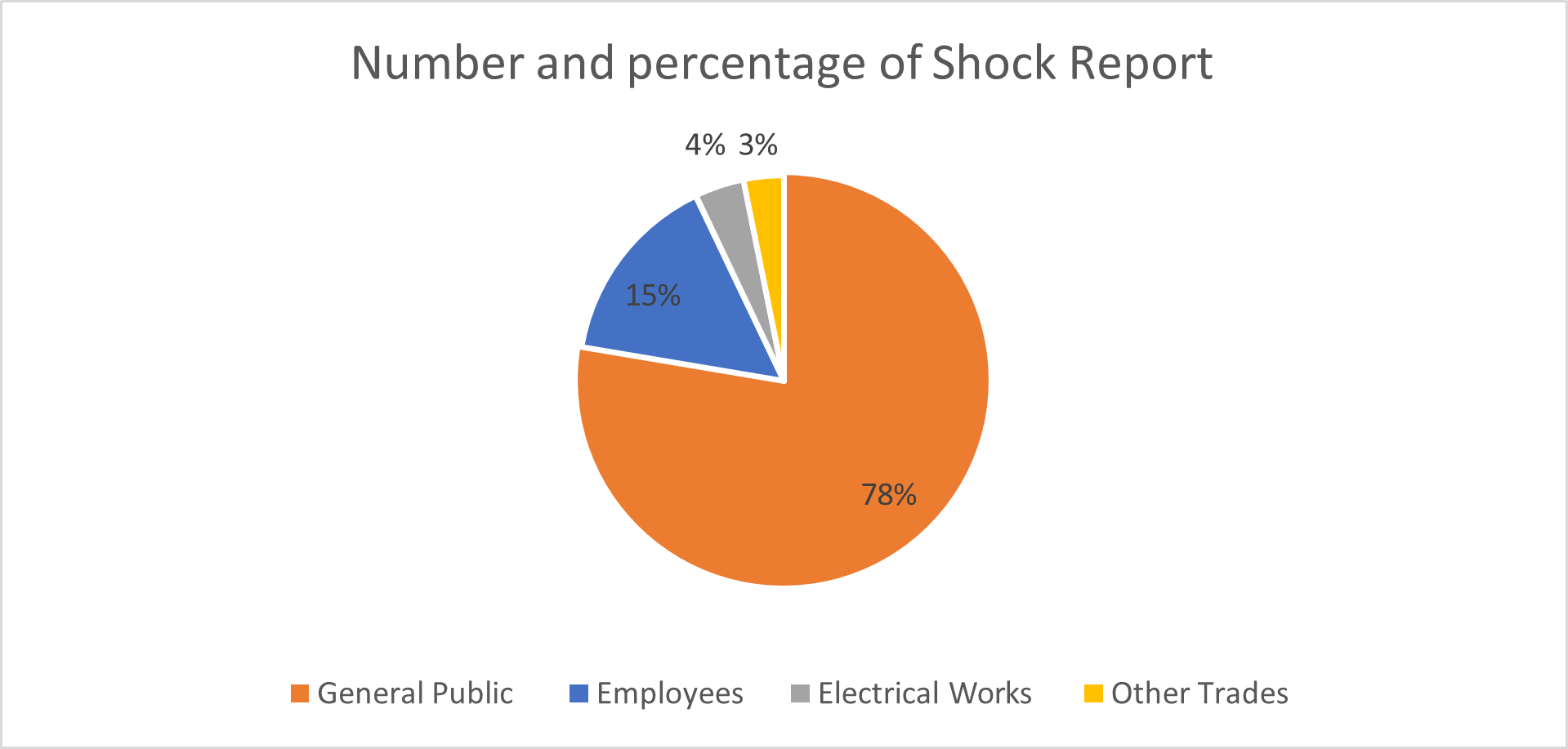
Figure A1 E 4: Shock Report for 2022-2023 by Recipient Category
The 1,199 electric shock reports are further broken down into translated Cause category on Table A1 E2 and Figure A1 E5
Table A1 E 2: Numbers and Percentage of Shock Report by Translated Cause Category
Translated Cause Category | Number % | |
|---|---|---|
| Defective insulation | 124 | 10% |
| Direct contact with live parts | 141 | 12% |
| Electrical faults | 20 | 2% |
| Electrostatic phenomena | 35 | 3% |
| Inadequate circuit design | 13 | 1% |
| Lack of earthing | 10 | 1% |
| Loss of earthing | 18 | 2% |
| Other | 121 | 10% |
| SAPN MEN | 717 | 60% |
| Total | 1,199 | 100 % |
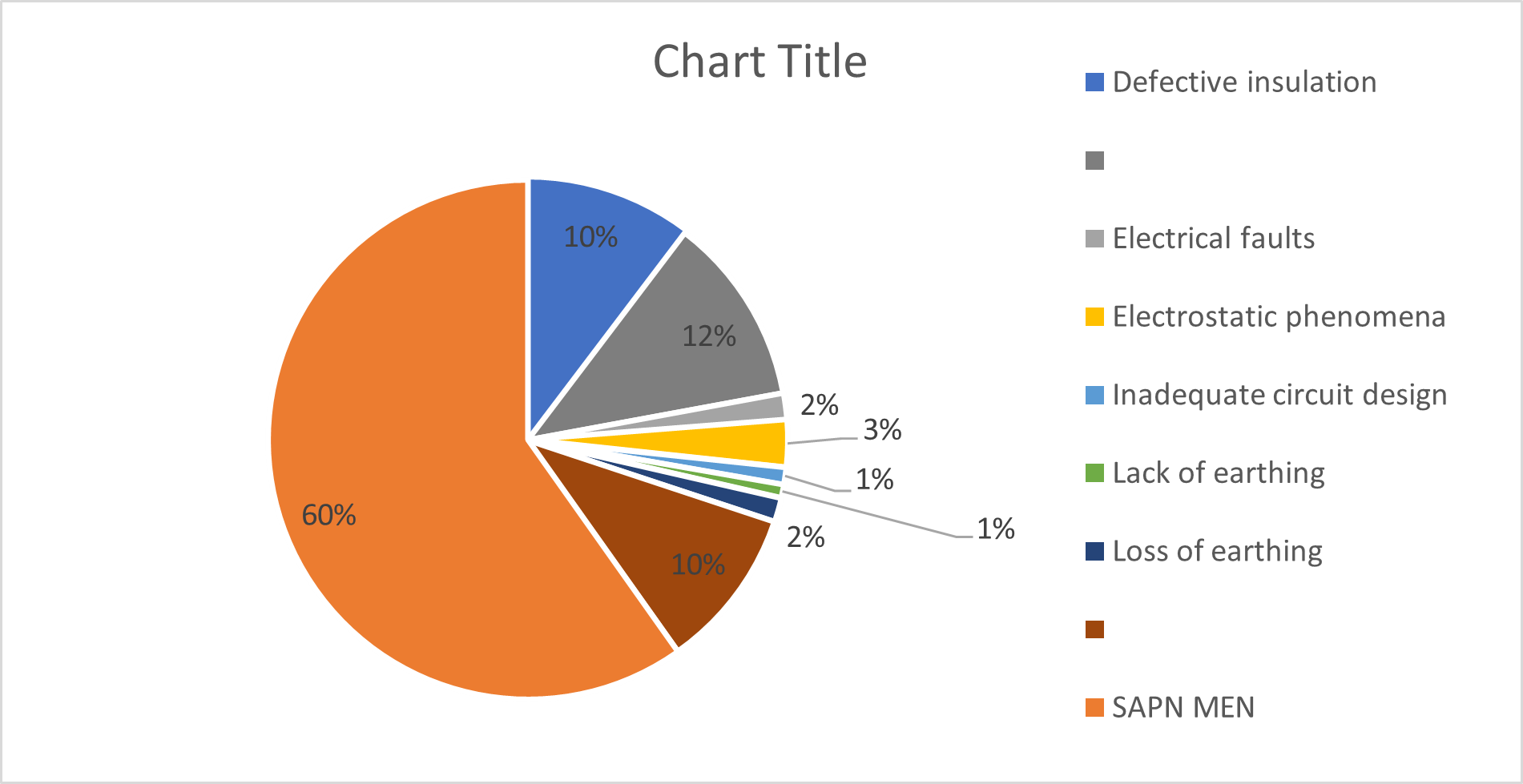
Figure A1 E 5: Shock Report for 2022-2023 by Translated Cause Category
Section A4: Electrical Products
The OTR monitors suppliers of electrical appliances and accessories for compliance with the Energy Products (Safety and Efficiency) Act 2000. A certification service assists the industry to meet compliance obligations. The OTR had a total of 106 applications for product approval, there were 15 desktop audits were undertaken, and 27 product related incidents were investigated.
One voluntary recall notice was issued following negotiations with the suppliers.
Section A5: Electrical Safety Awareness
To help maintain a good safety record within the industry and to promote public awareness, the Technical Regulator has:
- Ensured OTR engineers frequently made site visits to share information about working safely near powerlines with building industry companies and local councils and provided advice on safety and regulatory compliance of buildings and structures.
- Continued the “Be Energy Safe” campaign, with advertisements in print and other media to support specific campaigns, warnings and recalls.
- Provided safety brochures on request to local Councils, electricity entities and the public.
Volume II – Gas Industry
Section A6: Gas Infrastructure
6.1. Utilisation of Natural Gas Industry in South Australia
Natural gas is delivered to South Australia from Moomba (SA) and Queensland via the Moomba to Adelaide Pipeline and from Victoria via the Port Campbell to Adelaide Pipeline. Table A1 G1 shows the amount of gas delivered to the State. About 49% of gas delivered in SA was used in generating electricity in 2022- 2023, which is in line with previous years.
Table A1 G 1: Overview of natural gas delivered to the South Australia
Financial Year | Total amount of gas | Amount delivered for | Amount delivered to networks |
|---|---|---|---|
| 2021-2022 | 72.2 PJ | 37.0 PJ | 35.2 PJ |
| 2022-2023 | 70.0 PJ | 32.9 PJ | 34.7 PJ |
| Variation | 3.1% | 12.5% | 1.4% |
Figure A1 G1 demonstrates the amount of gas being used to generate electricity in South Australia over the past two years.
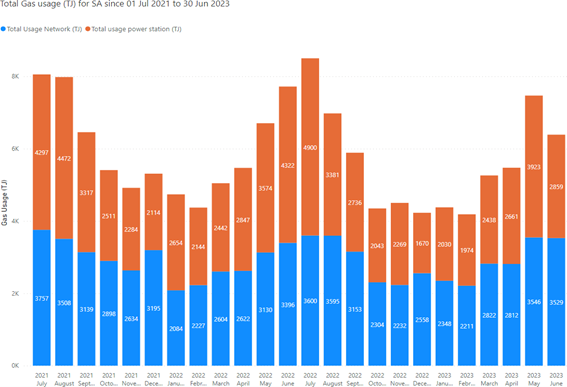
Figure A1 G 1: Total gas usage and usage for power generation in 2021-2022 and 2022-2023
In South Australia, natural gas is supplied from several sources and is transported to its destinations in the various transmission pipelines, as indicated in in Table A1 G2.
Table A1 G 2: Overview of natural gas delivered to the State
Source | 2019-2020 | 2020-2021 | 2021-2022 | 2022-2023 |
|---|---|---|---|---|
| South Australia (SA) | 26% | 36% | 30% | 25% |
| Victoria (VIC) | 35% | 36% | 44% | 37% |
| Queensland (QLD) | 39% | 28% | 26% | 38% |
In 2022-2023, as indicated on Figure A1 G2, the majority of gas was delivered from Queensland (QLD).
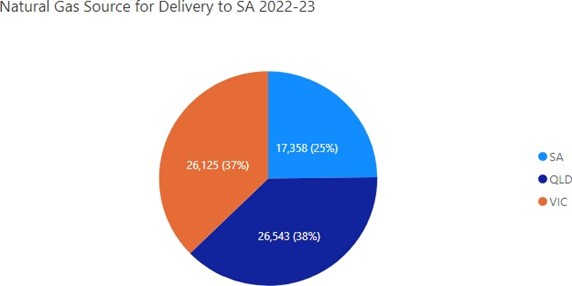
Figure A1 G 2: Natural gas delivered to the SA in 2022-2023
Table A1 G3 demonstrates the quality of gas entering Australian Gas Networks’ (AGNs) South Australian distribution network, including Farm Taps, for 2022-2023.
Table A1 G 3: Annual quantity of gas entering AGN’s SA networks (including Farm Taps)
Transmission pipeline | Gas Quantity (tera-joules, TJ) (1 July 2022 – 30 June 2023) |
|---|---|
| Moomba and QSN (MAP Gas) | 17,351 |
| SEAGas | 403 |
| South East | 3,696 |
| Farm Taps | 8,987 |
| TOTAL | 30,437 |
It can be seen from Figure A1 G3 that the overall amount of gas supplied to the networks in 2022-2023 has decreased from 2021-2022. Despite the slight increase in 2018-2019 and 2021-2022, there has been a steady decline while the total number of consumers increased by 5,243 last financial year. The distribution of consumers across the State is demonstrated on Table A1 G4 and Figure A1 G4.

Figure A1 G 3: Trend in the quantity of gas entering the distribution system over the last 10 years
The following table shows the number of consumers within the metropolitan and regional areas of SA.
Table A1 G 4: Approximate number of Consumers in the natural Gas Distribution network in South Australia
| Network location | Consumers (as of 30 June 2023) |
| Adelaide (including Virginia, Waterloo Corner & Two Wells) | 454,457 |
| Whyalla | 4,227 |
| Port Pirie | 5,501 |
| Mount Gambier | 9,522 |
| Peterborough | 79 |
| Nuriootpa | 1,352 |
| Angaston | 397 |
| Tanunda | 339 |
| Berri/Glossop | 117 |
| Murray Bridge | 527 |
| Freeling/Wasleys | 387 |
| Total | 476,905 |
The number of consumers connected to natural gas has been steadily growing over the years as demonstrated in Figure A1 G4.
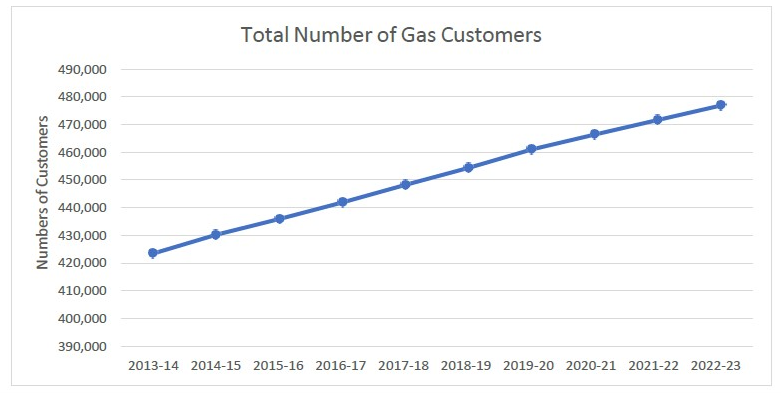
Figure A1 G 4: Numbers of consumers in the natural gas distribution networks over the past 10 years
6.2. Gas Infrastructure
6.1.1. Natural Gas networks
In July 2019, Enwave Tonsley Pty Ltd commenced gas supply to the embedded natural gas distribution network at the new residential site at the Tonsley Innovation District. In September 2020, the Technical Regulator was advised that Enwave Tonsley Pty Ltd became CleanPeak Energy Tonsley Pty Ltd (‘CPE’) and the CPE gas distribution licence was issued by the Essential Services Commission of South Australia (‘the Commission’) which reflects this change of name. As a result of the change, the Technical Regulator reviewed and approved the appropriate changes which CPE has incorporated into their Safety, Reliability, Maintenance and Technical Management Plan. CPE has expectation to expand their network for 70 customers in 2023-2024.
The embedded network is a reticulated natural gas network with a capacity to supply approximately 805 residential customers. Gas is supplied to the embedded network from the Australian Gas Networks (AGN) natural gas distribution system via a non- pressure regulated metered supply point. As of 30 June 2023, there were 202 customers connected to gas supply at the site. In 2022-2023, the network has been operated in conformance with the Safety, Reliability, Maintenance and Technical Management Plan approved by the Technical Regulator.
6.2.1. Hydrogen Park SA (HyP SA)
In 2022-2023, AGN provided the regular updates to the Technical Regulator on the operations of their 5% hydrogen blended renewable gas facility (HyP SA) at the Tonsley Innovation District. The initial blending network covered approximately 750 connections.
In 2023, the Technical Regulator approved AGN’s proposal to expand the blended network to an additional 3,030 customers covering West and North of the Mitchel Park. The expansion went live in March 2023 and AGN confirmed that there were no reported issues after completion of the expansion work.
6.3. Safety of Natural Gas Infrastructure
In August 2022, AGN submitted a revised Gas Measurement Management Plan (GMMP) for 2022-2023 which was reviewed and approved by the Technical Regulator. From July 2020, the Technical Regulator is responsible for an approval of the GMMP following the changes made to the Gas Metering Code by the Commission.
Despite the slight increase in the numbers of overdue gas meters, in 2022-2023, the Technical Regulator was pleased with AGN’s performance (Table A1 G5 and Figure A1 G5). The Technical Regulator was advised that the appropriate measures implemented by AGN (e.g. new program to organise access to meters and a process change in the way meters approaching the end of their approved service life are identified) contributed to the reduction and likely to trend downward the numbers in the future.
Table A1 G 5: Overdue gas meters in 2020-2021, 2021-2022 and 2022-2023
Overdue Gas Meters | With 10-year life | With 15-year life |
|---|---|---|
| As of July 2021 | 299 | 165 |
| As of July 2022 | 405 | 117 |
| As of July 2023 | 433 | 122 |
Figure A1 G5 demonstrates overdue gas meters over the last 8 years.
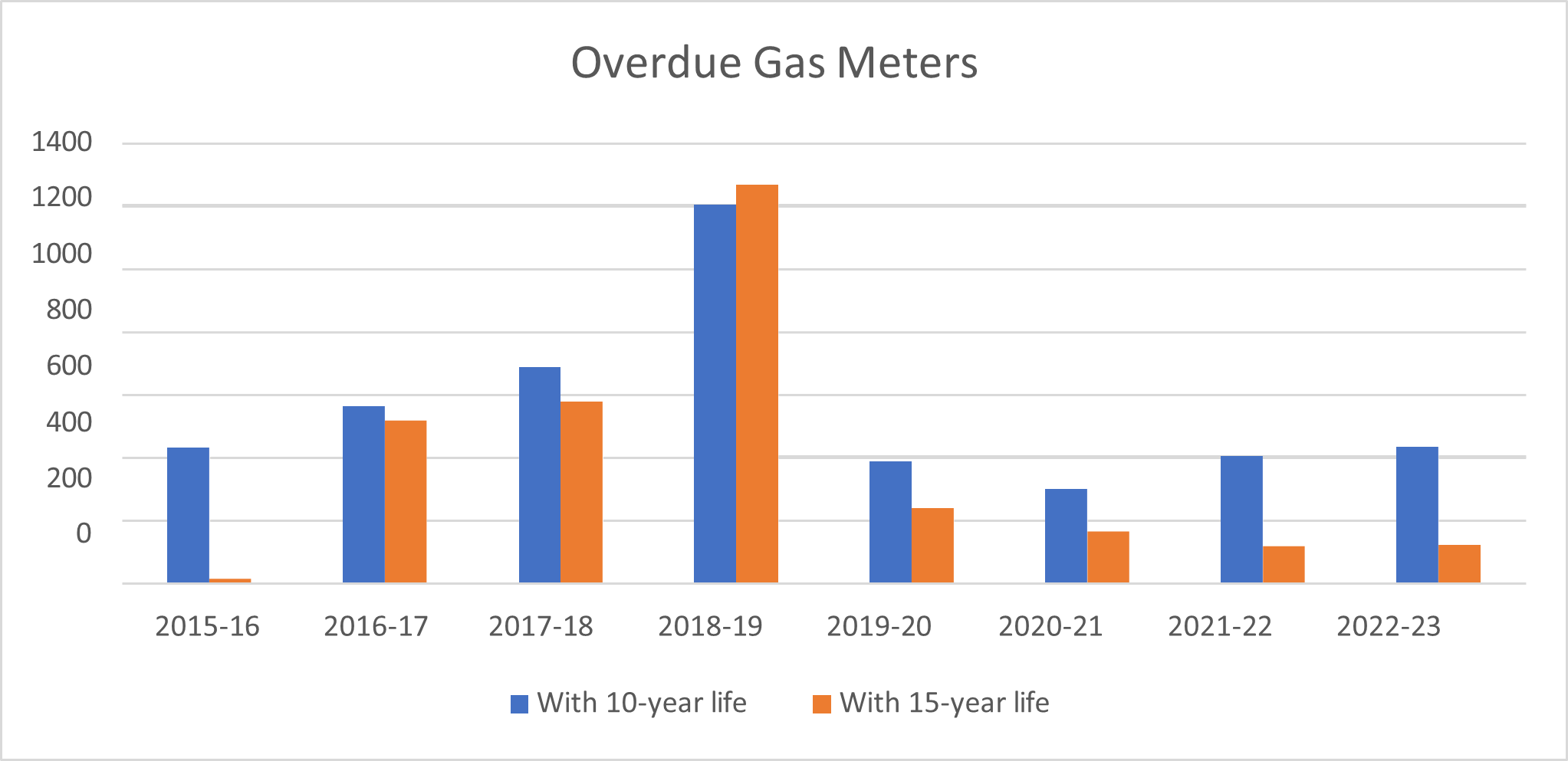
Figure A1 G 5: Overdue gas meters over the past 8 Financial years
6.3.1. Safety Reliability Maintenance and Technical Management Plan (SRMTMP)
In August 2022, AGN submitted a revised Safety Reliability Maintenance and Technical Management Plan (SRMTMP). Discussions between the Technical Regulator and the stakeholders ensured that the SRMTMP met all the requirements of the legislation and the distribution licence, thereby safeguarding the interests of the community. The Technical Regulator approved the SRMTMP.
The Technical Regulator noted that the key performance indicators (KPIs) provided by AGN (see Table K3 in Volume IV) indicate that their distribution systems are generally in a sound condition and are being competently operated. There are some concerns about the condition of the remaining cast iron (CI) and unprotected steel (UPS) mains and some classes of high-density polyethylene (HDPE) mains within the network, which is being addressed through an asset monitoring and replacement program.
In December 2022, the Technical Regulator approved the CleanPeak Energy Tonsley Pty Ltd SRMTMP. This document relates to the design, construction, commissioning, management, operation, maintenance and decommissioning of the embedded natural gas distribution network located at the Tonsley Innovation Centre.
The SRMTMP has been prepared to describe how CleanPeak Energy’s operations and maintenance staff ensure safe, reliable and sustainable management of the network.
6.3.2. Auditing for safety and technical compliance
During 2022-2023, the Technical Regulator carried out a series of desktop and field audits against AGN’s SRMTMP. This included a review of the Unaccounted for Gas (‘UAFG’) Plan comprising of a Leakage Management Plan (‘LMP’) and Distribution Mains and Services Integrity Plan (‘DMSIP’), and Gas Measurement Management Plan (‘GMMP’). The audits were carried out in areas that directly affect consumers, the public in general, and/or the safety, reliability, maintenance and integrity of the distribution network.
These audits included a review of the following:
- Evidence of completion of outstanding corrective actions on all recommendations noted during the Technical Regulator’s audit 2021 and any Australian Gas Networks’ (AGN’s) and APA’s external audits in 2022 -2023.
- Network Capacity – Understand how capacity designs, network load impact assessments and network capacity analyses are managed and utilised by APA (Section 4 of SRMTMP).
- Mapping and records of asset locations processes – Understand how mapping and records updates activities are managed by APA, how asset location is captured and maintained and how it is accessed (Section 4.5.2 of SRMTMP).
- BYD Australia – Review how APA manage BYD request from third parties and reduce risks of third-party damage to its gas assets (Section 4.5.3 of SRMTMP).
- Materials and Components Control Process – Review the processes to assess new materials and components for inclusion in the SA networks and how APA ensure that materials and components in the networks are fit for purpose (Section 4.3 of SRMTMP).
- Systems and procedures to fulfil APA’s obligations with respect to installations, operations, maintenance and emergency preparedness of the regional gas distribution network in Whyalla and Port Pirie. Carried out discussions with local field supervisor and contractors responsible for management of the gas distribution network (Section 4.5 of SRMTMP).
- Leak survey – Field processes/practices to review how APA’s contractors undertake leak survey to ensure that the long-term integrity of the gas distribution is maintained and the appropriate and timely responses to any reported gas outages/incidents are carried out.
- MRP – Field processes/practices to review how APA’s contractors undertake main replacement to ensure that the mains replacement prioritisation process. Review the impact of APA’s mains replacement and other contributable factors, which are under control of APA, on the UAFG level over the last 12 months.
- Hot Tap Process – Field processes/practices to review how APA’s contractors undertake Hot Tapping process.
- Regular reporting of outcomes from the APA Frontline Assurance Program – Quarterly reports highlighting non-compliance detected via the framework (compared total inspections) and what corrective action were undertaken.
The OTR audits found that the implementation of AGN’s SRMTMP, LMP, DMSIP and GMMP (in the audited areas) met the minimum requirements prescribed by the Gas Act 1997, the Gas Regulations 2012, AGN’s Distribution Licence conditions, safety and technical standards, and industry codes.
APA staff provided documents on behalf of AGN, which assured the auditors that APA have sound and well-developed systems in place to ensure that the risks to the South Australian community from the operation of the distribution networks are managed to an acceptable level. APA also presented evidence that the systems they have in place are adequate to ensure the training and assessment of the competency of the APA staff (and contractors) in the areas audited.
6.3.3. Gas incidents
There were 23 major outages in 2022-2023 (that is outages that affected more than five consumers) but no deaths or personal injuries were reported as a result of incidents in the distribution system. The Technical Regulator noted that the number of major outages in 2022-2023 was similar to the number of major outages (14) in 2021-2022.
6.3.4. Gas leak reports
APA Group provides the Technical Regulator with distribution system operational data on an annual basis. This data includes third party damage, gas leak public reports and Unaccounted for Gas (UAFG) values. Table A1 G6 provides the trend in these parameters for the last five years.
Table A1 G 6: Data reported by the APA group over the last five financial years
Data reported by APA | 2018-2019 | 2019-2020 | 2020-2021 | 2021-2022 | 2022-2023 |
|---|---|---|---|---|---|
| Third party damage | 665 | 537 | 460 | 475 | 434 |
| Gas leak public reports (excluding third party) | 1,673 | 1,600 | 1,304 | 1,545 | 1,149 |
| UAFG (tera-joules, TJ) | 692 | 603 | 437 | 392 | 312 |
During 2022-2023, APA Group provided approximately 99,902 location services to various third parties via DBYD, higher than 2021-2022 (94,602). This indicates that the South Australian public is aware of using the DBYD service to minimise the risks of gas incidents.
Public reports for gas leaks have been reduced over the last year 1,583 recorded for 2022-2023 (Figure A1 G6) which can be divided between:
- 1,149 publicly reported gas mains and services leaks.
- 434 public reports of third-party damage
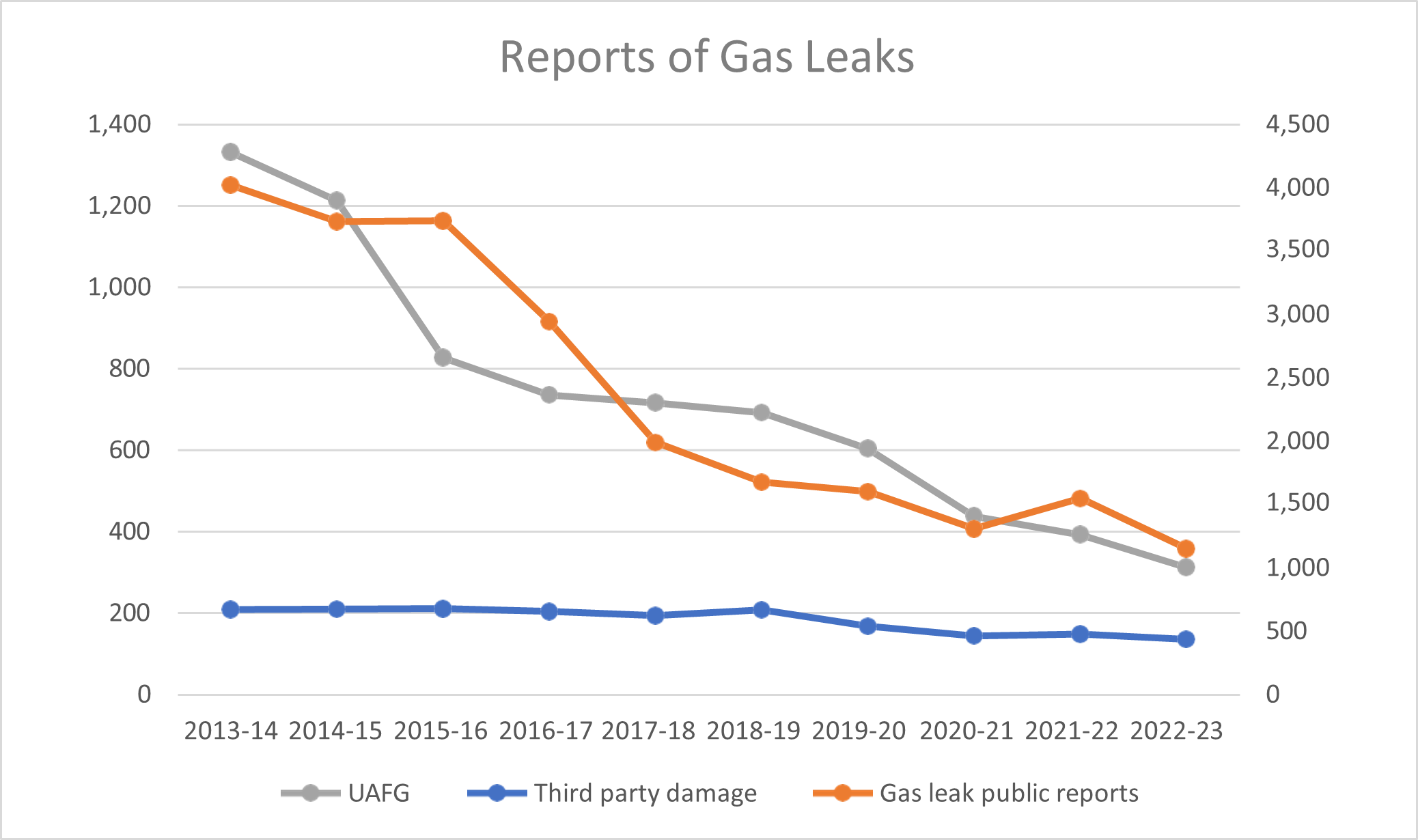
Figure A1 G 6: Numbers of public reports of gas leak and UAFG
The Technical Regulator noted that the reported UAFG value was 312 TJ, based on the Australian Energy Market Operator (AEMO) calculations (as of 30 June 2023). This has greatly reduced over the last 10 years (Figure A1 G6). This value represents approximately 1.0% of the total quantity of gas that entered the distribution system (including Farm Taps) and approximately 1.45% (excluding Farm Taps). The great reduction of UAFG seems to be mainly attributed to the amount of cast iron and unprotected steel mains replacement which AGN carried over the last 10 years. This significant decreasing trend in UAFG to 312 TJ is a pleasing outcome indicating improvement into the integrity of the AGN distribution networks, reliability of gas supply and the significant reduction of methane emissions into the atmosphere.
It is also noted that the number of third-party damage to gas infrastructure has been reducing in recent years which is a positive outcome. This can be attributed to the awareness campaigns that APA run with third party to educate on how to identify gas infrastructure before digging.
The Technical Regulator has also supported and promoted a use of six-part series videos produced by SafeWork SA for all industry stakeholders which address the appropriate safety and procedural steps to be undertaken by third parties working in the proximity of the utilities’ assets to reduce the safety risks to the public in South Australia. These videos have been established following a number of Utility Asset Strike Avoidance’ workshops organised by SafeWork SA in which the Technical Regulator has participated.
6.3.5. AGN mains replacement program
Following a review of the AGN mains replacement program (as AGN reported to the Technical Regulator in 2022-2023), the Technical Regulator noted that AGN has replaced approximately 178.41 km of old cast iron, unprotected steel and HDPE gas mains. The overall progress of mains replacement was approximately 6.41 km above the AGN annual target of 172 km.
The Technical Regulator is pleased that AGN has achieved its annual regulatory target of mains replacement in the Adelaide Central Business District (CBD) in 2022- 2023 and has successfully completed all of the Adelaide CBD mains replacement program with all extreme risks removed.
AGN advised the Technical Regulator that it has budgeted to replace a further 159 km of gas mains in 2023-24. The Technical Regulator noted that, in addition to block low pressure cast iron and unprotected steel mains replacement (114 km), AGN will continue work in 2023-24 on the replacement of 45 km of HDPE mains prioritised as locations of greatest risk.
Generally, the Technical Regulator supports most of the technical/field activities which AGN proposed to carry out on the gas distribution networks in South Australia to ensure safety and reliability of the networks over the five years of the AGN Access Arrangement. The AGN mains replacement program during the 2021-2026 Access Arrangement period was the major issue for the Technical Regulator’s consideration.
6.4. Safety of LPG Distribution Networks
The Technical Regulator was advised by ELS that they expect their existing developments to continue to expand within the immediate Mount Barker area and they have no current plans to expand in areas outside of Mount Barker city limits.
In 2022-23, the Bluestone Estate development was close to completion, with approximately 1,564 allotments installed and 1,254 customers connected to the LPG distribution network.
The Technical Regulator monitored the progress of the construction of ELS’ new LPG distribution networks in Mount Barker located at the Aston Hills Estate (300 allotments completed and 257 customers connected), the Springlake Estate (446 allotments completed and 364 customers connected) and at Newenham Estate (258 allotments completed and 190 customers connected) along with other sites as per Table A1 G7.
The Technical Regulator was advised that, in 2022-2023, ELS continued the construction of the LPG networks at the 2 new developments in Mount Barker (Peach Development, 45 connections and Woolworth Shopping Complex, 1 connection). In addition, in 2022-2023, AGN continued the construction of its own LPG distribution network at the Glenlea Estate in Mount Barker with approximately 143 customers connected to the network. The Technical Regulator will be monitoring all ELS and AGN field activities at the sites in Mount Barker to ensure that they are carried out in accordance with the correct technical requirements.
Table A1 G 7: LPG distribution networks under development in South Australia
Network Location | Owner/ Operator | Length of Main (m) | Operating Pressure (kPa) | Number of expected customers |
|---|---|---|---|---|
| Mount Barker (Bluestone Estate) | ELS | 21,298 | 120 | 1,688 |
| Mount Barker (Scarlet Crest Estate) | ELS | 394 | 120 | 25 |
| Mount Barker (Springlake Development) | ELS | 6,637 | 120 | 446 |
| Mount Barker (Aston Hills Development) | ELS | 6,492 | 100 | 300 |
| Mount Barker (Peach Development) | ELS | 818 | 70 | 45 |
| Mount Barker (Newenham Development) | ELS | 4,584 | 70 | 258 |
| Mount Barker (Hawthorn Road) | ELS | 1,563 | 70 | 62 |
| Mount Barker (Minters Fields Development) | ELS | 5,242 | 100 | 417 |
| Mount Barker (Amblemead Development) | ELS | 1,777 | 120 | 198 |
| Mount Barker (Blefari Development) | ELS | 6,427 | 700 | 391 |
| Mount Barker (Matilda Rise Development) | ELS | 1,156 | 70 | 78 |
| Mount Barker (Clover Park Development) | ELS | 4,009 | 70 | 271 |
| Mount Barker (The Lodge Development) | ELS | 330 | 70 | 54 |
| Mt Barker (Adore Development) | ELS | 188 | 70 | 28 |
| Mount Barker (Glenlea Development) | 4,300 | 100 | 143 | |
| Mount Barker (Emerald Way) | ELS | 1,528 | 100 | 130 |
| Mount Barker (Woolworth Shopping Complex) | ELS | 698 | 140 | 1 |
| Clare (Hanlins Rise Estate) | Elgas | 1,900 | 140 | 66 |
Figure A1 G 7: Total numbers of LPG consumers over the past 5 financial years
6.4.1. Auditing for safety and technical compliance
There was no audit conducted for LPG distribution networks in 2022-2023 apart from SRMTMP approval. In October 2022, the Technical Regulator carried out a field visit to observe the ongoing development of the distribution networks managed by ELS in Mount Barker.
The Technical Regulator was satisfied that the risks to the community from the operation of the LPG distribution networks are being managed to an acceptable level by competent and appropriately trained personnel.
6.4.2. Incident reporting
There were no deaths or personal injuries from the LPG distribution networks incidents in South Australia during 2022-2023.
ELS reported to the Technical Regulator that there was only one gas leak reported to ELS from the LPG distribution networks in Mount Barker in 2022-2023. Leak has been promptly repaired by ELS’s field staff.
Section A7: Gas Installations
7.1. Natural Gas and LPG Installations
7.1.1. Residential and Light Commercial Gas Installations
The Technical Regulator is responsible for ensuring that installation work is performed in a safe manner, using appropriate methods and materials that are compliant with relevant Standards. Generally, gas installation work involves the connection of new gas appliances, pipework, flueing and ventilation where necessary. The following table shows the approximate number of new or modified installations and connections over the year.
Table A1 G 8: New or modified installations and connections
| 2020- 2021 | 2021- 2022 | 2022- 2023 | |
|---|---|---|---|
| New domestic and light commercial appliances installed | 26,124 | 25,207 | 19,371 |
| Existing installations that required replacement | 12,267 | 11,299 | 9,345 |
| New natural gas connections to distribution network (residential & commercial/industrial) | 8,005 | 7,433 | 7,371 |
| New reticulation LPG connections to residential and light commercial premise | 410 | 426 | 786 |
In larger new residential developments such as Mount Barker Estate where natural gas is not available, LPG (Propane) is supplied by means of reticulated gas network systems supplied from large storage tanks located on the perimeter of the estate.
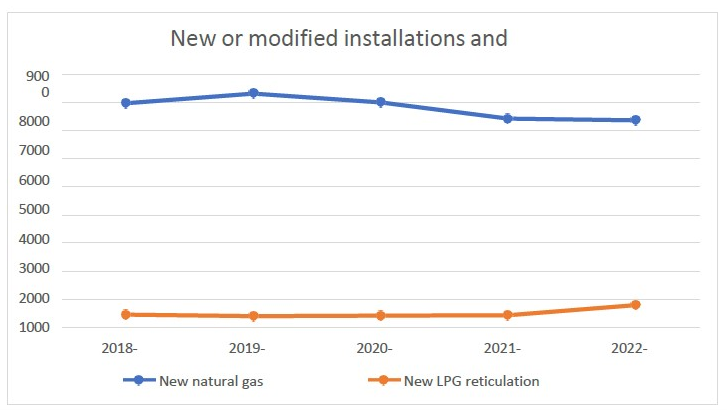
Figure A1 G8: New natural gas connection and reticulation LPG connection the past 5 years
7.1.2. Industrial and Large Commercial Gas Installations
The OTR monitors industrial and commercial, elevated pressure and complex gas installations in the design and construction phases. There were several complex projects throughout the 2022-2023 period such as the University of Adelaide Mechanical Engineer Laser Laboratory project (on-going), Iberdrola Australia Bolivar Power Station and Thomas Foods Industries. The OTR undertook desktop reviews of all initial designs and visited the work sites on numerous occasions for each project. Where compliance issues were identified the installations were modified by the contractors to meet the deemed to satisfy requirements of AS/NZS 5601.1 gas installation standard and performance-based designs.
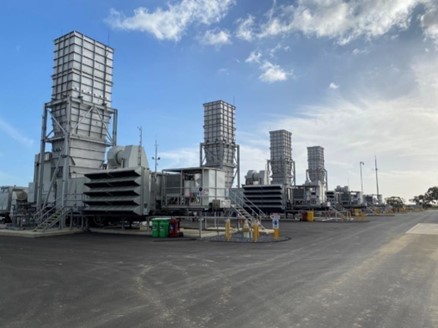
Figure A1 G 9: Bolivar Power Station
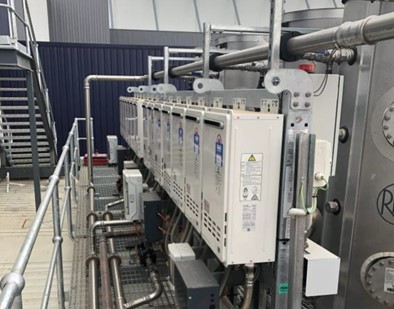
Figure A1 G 10: Thomas Foods Industries
Industrial and Commercial Type B Appliances
There is a legislative requirement for Type B (industrial) gas appliances to be certified to AS 3814 before commercial operation. The OTR monitors Type B appliance certifications through accredited certifiers. Submissions are provided to certifiers by equipment suppliers, manufacturers, or commissioning agents for desktop review. If satisfactory, temporary commissioning gas is granted. The equipment can then be commissioned under supervision before on-site safety testing and certification. The OTR monitors Type B appliance certifications by certifiers. In the 2022-2023 period, there were 146 Type B appliances tested and certified.
Type B appliances are individually tested and certified by private certifiers accredited by the Technical Regulator prior to commercial operation.
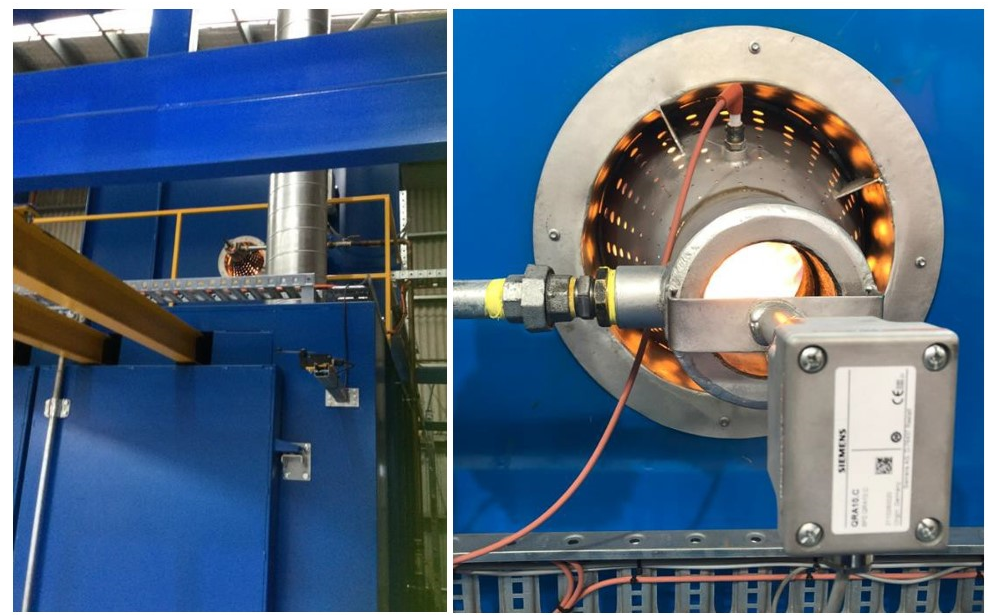
Figure A1 G 11: Photo of a Type B powder coat oven
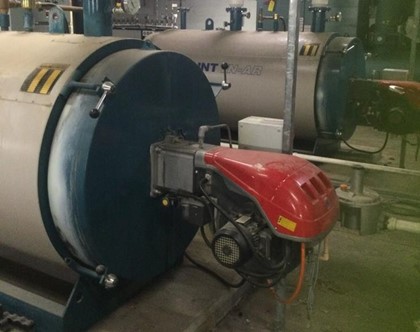
Figure A1 G 12: Photo of a Type B steam boiler
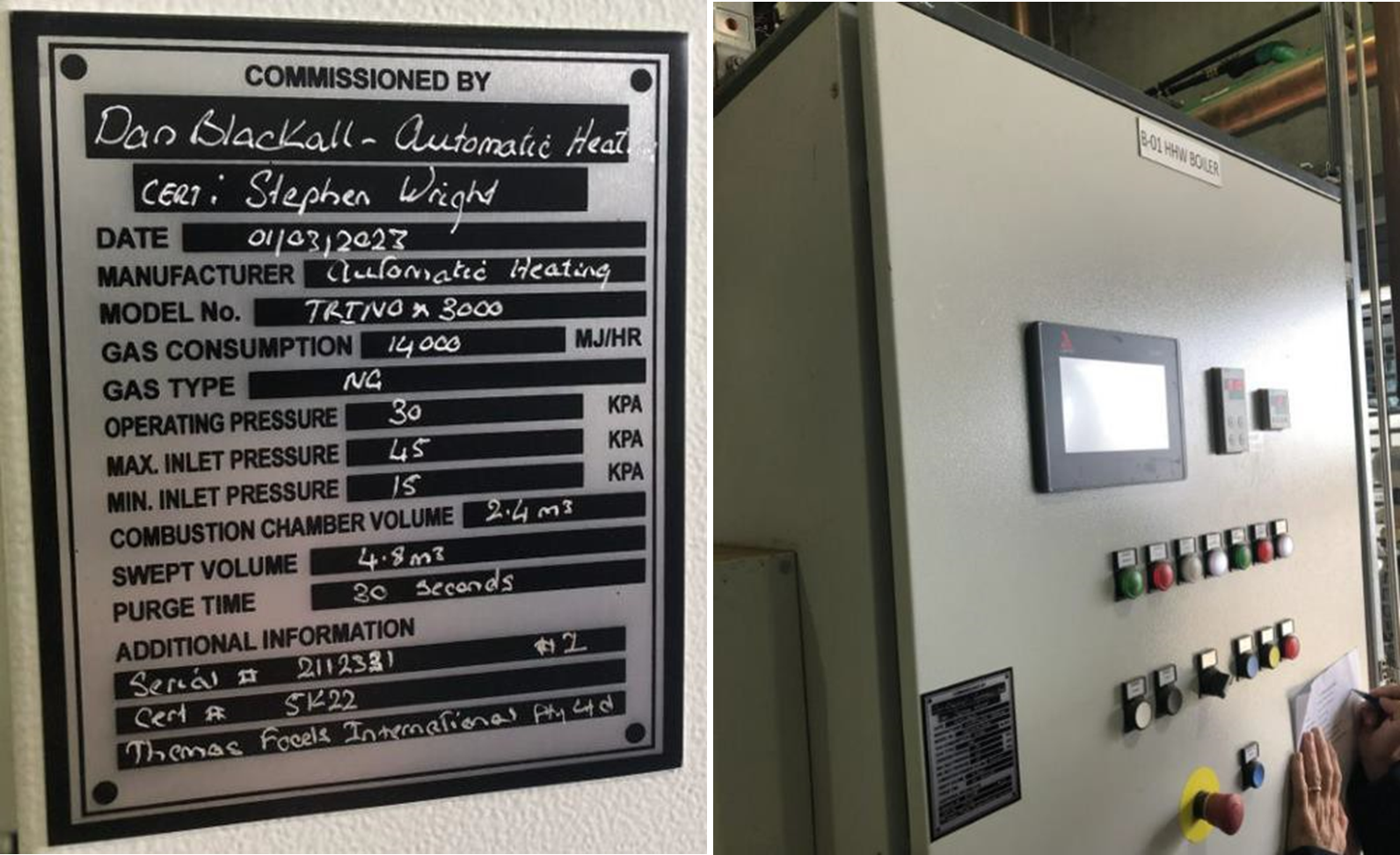
Figure A1 G 13: Typical Type B appliance certification badge plate affixed adjacent to appliance controls
7.1.3. Investigation
The OTR reactively investigates complaints and reports of incidents/accidents involving gas installations and appliances. The figure below illustrates an example of cases attended throughout 2022-2023.
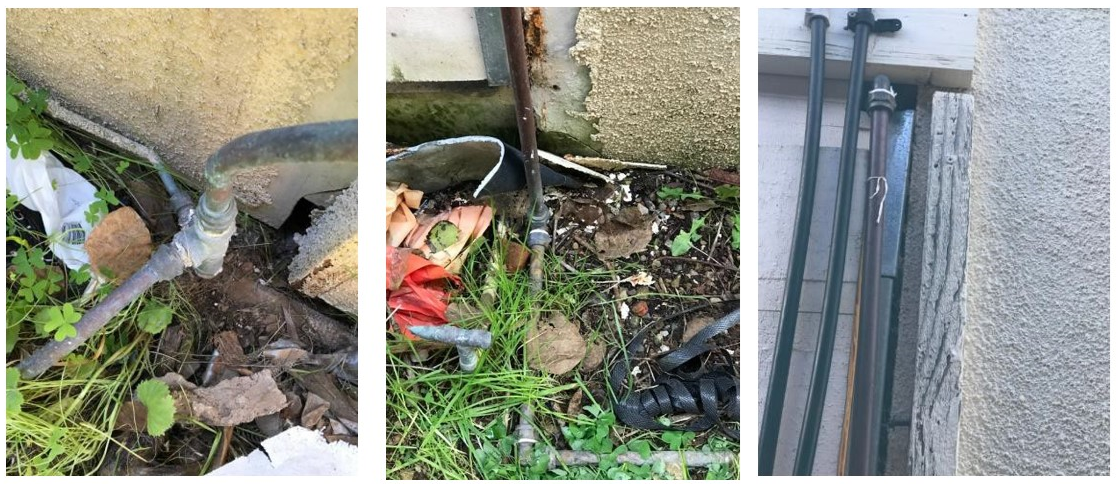
Figure A1 G 14: Failed outlet service
The photos above show a non-compliant gas outlet service laid on the ground surface running on the neighbor’s property with some of the gas connections approved for water only.
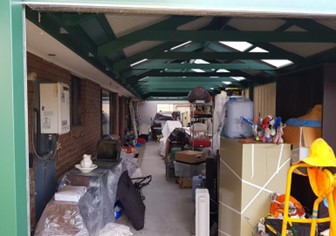
Figure A1 G 15: Non-compliant HWS location
Photo showing unsatisfactory ventilation for an external model water heater located inside a fully enclosed carport. Gas fitter instructed to return and relocate the water heater outside.
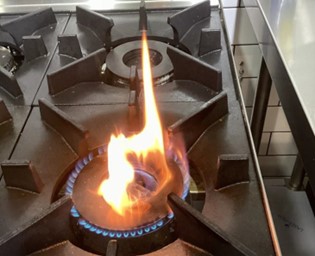
Figure A1 G 16: Non-compliant installation appliance not commissioned
7.1.4. Auditing for Compliance
Proactive Audits
22,588 residential and light commercial gas installation jobs were completed in South Australia during 2022-2023 and of these installation jobs 1,102 were audited. Audits are generated by our senior regulatory compliance officer who responds to gas eCoCs that have been submitted by randomly sending text messages to owner / operators of a newly installed gas installation. The text message advises recipients that an authorised gas inspector will be in contact with them shortly to arrange an onsite inspection. Also owner / operators who receive a submitted gas eCoC can contact our office via a link in the email and register for expression of interest to have gas work recently completed audited and safety checked 992 large commercial and industrial gas installations were completed during 2022- 2023 and the Technical Regulator pro-actively audited 271 of these jobs for compliance with AS 3814– Gas Fired Industrial and Commercial Appliances and AS/NZS 5601 – 2013 Gas Installations.
Table A1 G 9: Results of installation auditing
Area of Audit | 2018-2019 | 2019-2020 | 2020- 2021 | 2021- 2022 | 2022- 2023 |
|---|---|---|---|---|---|
| Domestic/light commercial audits | 1,419 | 1,542 | 1,427 | 1,044 | 1,102 |
| 100% Domestic safety checks at all new meter connections * | 7,979 | 8,323 | 8,005 | 7,433 | 7,371 |
| I&C audits | 97 | 80 | 76 | 206 | 271 |
| Caravan & tourist park gas safety audits | 0 | 0 | 0 | 7 | 16 |
| Caravan Retailer audits ** | 13 | 23 | 4 | 1 | 1 |
| Complaints resolved | 605 | 421 | 462 | 426 | 480 |
| Investigative interviews | 6 | 4 | 2 | 1 | 2 |
| Warning letters sent | 150 | 147 | 106 | 73 | 116 |
| Expiation notices issued | 0 | 1 | 3 | 0 | 6 |
| Referrals to Consumer and Business Services (CBS) – re: licensing issues | 7 | 3 | 3 | 1 | 2 |
| Referrals for remedial training. (Self-initiated enrolment) | 1 | 1 | 2 | 0 | 2 |
* New residential consumer installation and appliance safety checks were performed by Phoenix Pty Ltd and McPlumb technicians (contractors for the APA Group) prior to connection to the natural gas distribution system for the first time under an agreement with the Technical Regulator.
** Caravan retailers audited commenced in 2018-2019.
When undertaking complex audits, OTR inspectors inspect the following as applicable: NG meter or LPG cylinder/tank placements, pipe work is fit for the application, appliance types and evidence of certification, over pressure protection, flueing, ventilation systems and compliance documentation covering electronic Certificates of Compliance / pressure test results, purge plans and commissioning, and approval for Type B appliances. Installations are assessed to ensure that they meet the requirements and standards called up by the Gas Act 1997.
Audits of permanent gas installations at tourist and caravan parks
Sixteen caravan and tourist park gas installations were audited in 2022-2023.
Installation Audit Results
The number of proactive audits of residential and light commercial installations that were completed in the year was 1,102, with a split of 734 inspections for natural gas versus 368 for LPG installations. LPG installations are audited at a higher relative rate for the population base for several reasons:
- LPG is potentially a more hazardous fuel as it is heavier than air with a higher heating value.
- Because these jobs are often found in more remote locations there may be the perception that compliance with the Standards is not so important because there is less chance that the Technical Regulator will audit the work.
- Often existing gas work on site has been performed by unlicensed persons due to the limited availability of skilled licensed persons in some areas or the DIY mentality in some remote areas.
Enforcement activities for non-compliant gas installations
A total of 116 warning letters were issued during the year, 76 to gas fitting contractors and 40 warning letters to owners. Six expiation notices were issued in 2022-2023. The Technical Regulator prefers that non-conformances are addressed and rectified by the gas fitter as part of their remediation of work and education. This results in a positive outcome for the consumer in that the installation is made compliant and the gas fitter actively learns from their mistake. Gas fitters also lose income earning opportunities while rectifying their work. Taking legal action may introduce the risk of not facilitating remediation of the actual non-conformance.
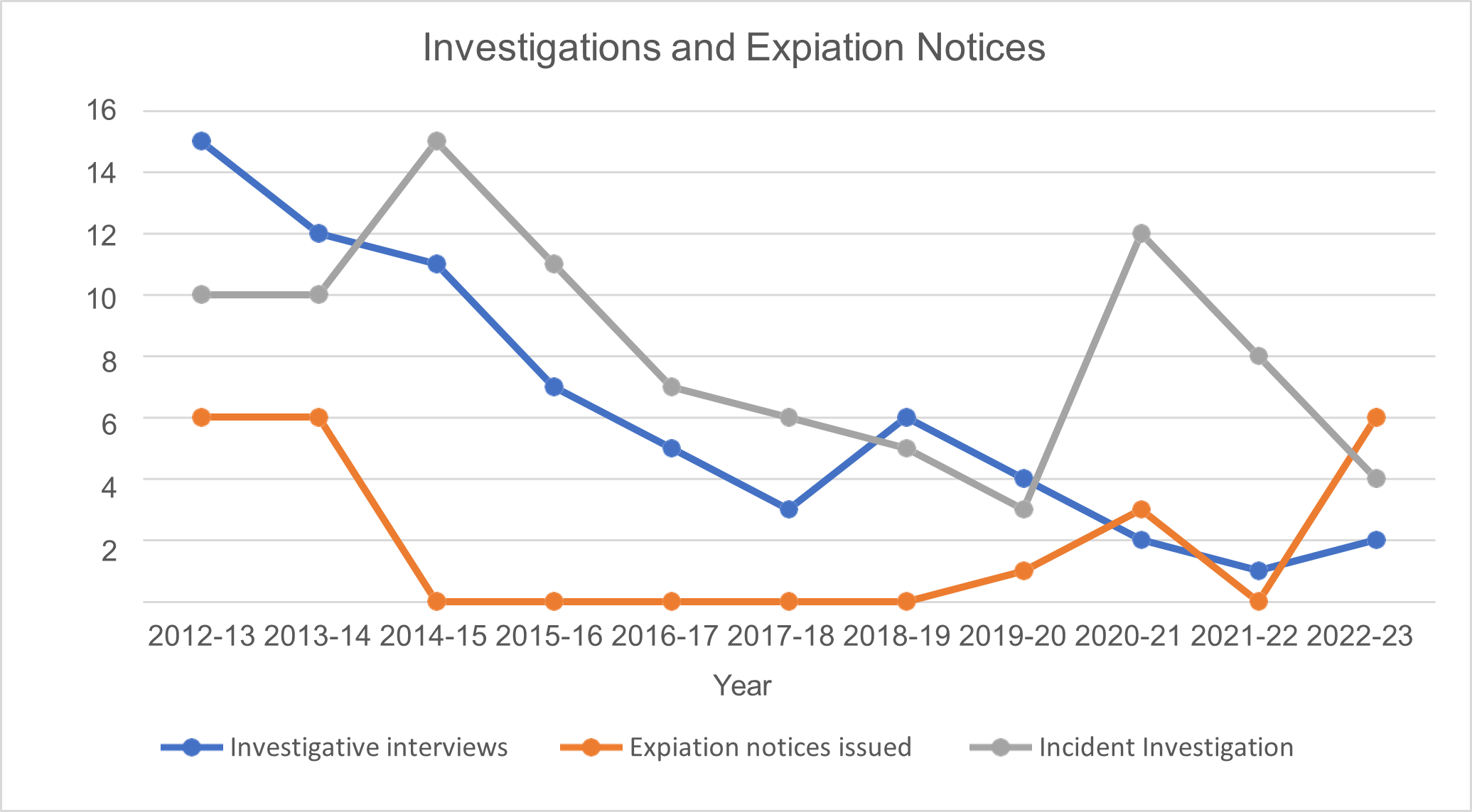
Figure A1 G 17: Investigations and Expiation Notices
Referrals to CBS
There were two referrals to CBS during the year. People found to be performing gas installation work whilst unlicensed, unregistered or performing work outside the scope of their licence or registration are referred to the licensing authority CBS for action. CBS investigates the matters and considers the recommendations made by the Technical Regulator in making their deliberations.
Meter fix hang and wad trial
APA Group and the OTR have agreed to trial a new arrangement for meter fix installations for new residential connections. This trial will be for six months, where it will then be reviewed by the OTR and APA Group.
The requirements of the AS/NZS5601.1 -2022, clause 6.11.2 are that Type A appliances shall be commissioned by a suitably licensed person who installs the appliance when gas is available at the completion of an installation.
As of 1 May 2023, APA Group has commenced hang and wad meters for all new connections in South Australia. The meter fix can only occur after the first fix gas installation has been completed. It is the gas fitter’s responsibility to connect the outlet service to the meter and complete the purging and commissioning of the appliances as required by Clause 6.11.2.
The gas installers will be required to issue an eCoC covering the installation and commissioning of the appliances on completion, as required by the Act Gas 1997.
APA set the working and lock up pressures on the service regulators during the hang and wad process, they also do a visual inspection of the outlet service to ensure meter box and outdoor appliance location/ventilation will be suitable. If a meter fix is not completed due to a non-compliance, APA will communicate through their normal channels so the gas fitter can rectify the issue and then request another meter fix.
The OTR will conduct proactive random audits on these new installations to ensure compliance with the AS/NZS5601.1 – 2022 gas installation standard is being met and eCoC’s have been submitted.
7.1.5. Gas incidents – Installations
In 2022-2023, there were a total of four gas related incidents reported to the OTR resulting in injury or property damage. All reported incidents were LPG related. They were all investigated and are summarised as follows:
Rotary salt dryer explosion – Type B appliance.
A gas fitter investigating why the pilot would not light on an industrial salt dryer inadvertently caused an explosion when excess gas built up inside the combustion chamber. The explosion caused the oven door, weighing 25kg, to be shot out over 60 metres. Fortunately, nobody was injured.
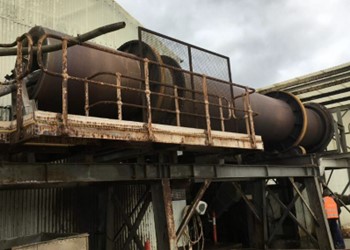
Figure A1 G 18: Rotary salt dryer involved in incident
LPG explosion at a football club.
An incident causing serious injuries from a gas explosion occurred inside a commercial catering kitchen. A deep fryer was removed for an external event prior to the incident date and was returned a few weeks later and slid back into place. The fryer was not reconnected, however, leaving an open-end pipe.
A community group booked the football club for a Christmas function turned the gas on and they tried to light the fryer, which resulted in an explosion injuring the two volunteer staff members causing them to be hospitalised. The investigation found:
- The gas worker disconnected the fryer, but did not cap off the ball valve or the hose assembly.
- The appliance was returned, and moved into place but was not reconnected.
- The community group was unaware the fryer was not connected.
- Lock out or danger tags were not fitted.
- The community group could not hear gas escaping as the exhaust canopy was in operation.
- LPG heavier than air, and it spread out over the floor until it found an ignition source. It is difficult to smell.
- Two women received burns to 30% to their bodies and were hospitalised.
- The victims have been recovering but they will have scars for life.
- The football club has been fined for not operating a safe gas installation.
- The gas worker has been fined for leaving an open-end pipe and fined for not issuing an eCoC.
- At the request of the OTR, CBS have cancelled the gas worker’s registration.
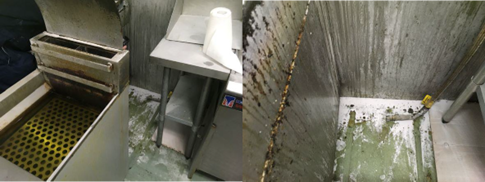
Figure A1 G 19: Deep fryer and open-end hose assembly involved in explosion incident
Outdoor portable HWS and 9kg cylinder incident.
- A recreational outdoor portable water heater was installed indoors: a non- compliant location.
- An HWS was connected to a 9kg LPG cylinder, also located indoors – not recommended.
- A loose POL connection at cylinder, and leaking gas ignited off HWS.
- Owners did not check hose assembly connection at cylinder after cylinder swap over.
- Extensive damage to rear of house resulted.
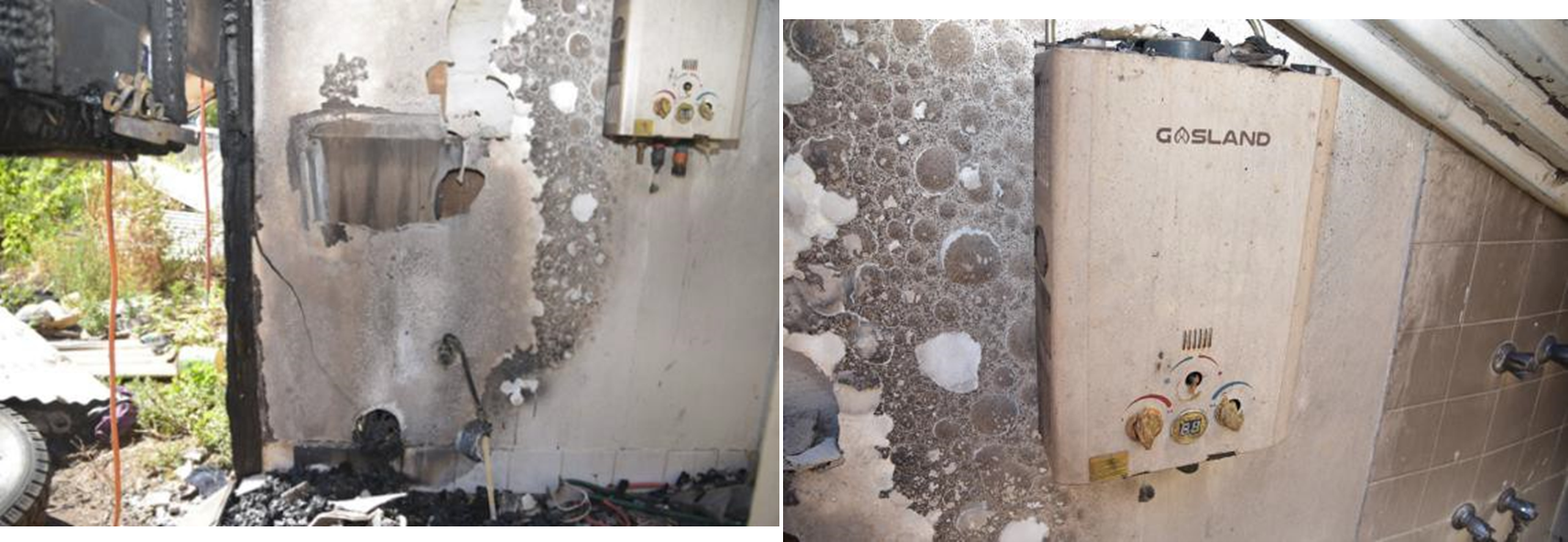
Figure A1 G 20: Recreational outdoor model water heater involved in explosion incident
Outdoor wok burner and 9kg cylinder incident.
- Similar to the previous incident, an outdoor portable wok burner was used indoors.
- Owners disconnected cylinder to check LPG level.
- They reconnected it, but unfortunately damaged O-ring on POL connector.
- Owner did not check for leaks, and escaping gas ignited off wok burner causing an explosion.
- Person received burn injuries as they moved the burning cylinder outdoors.
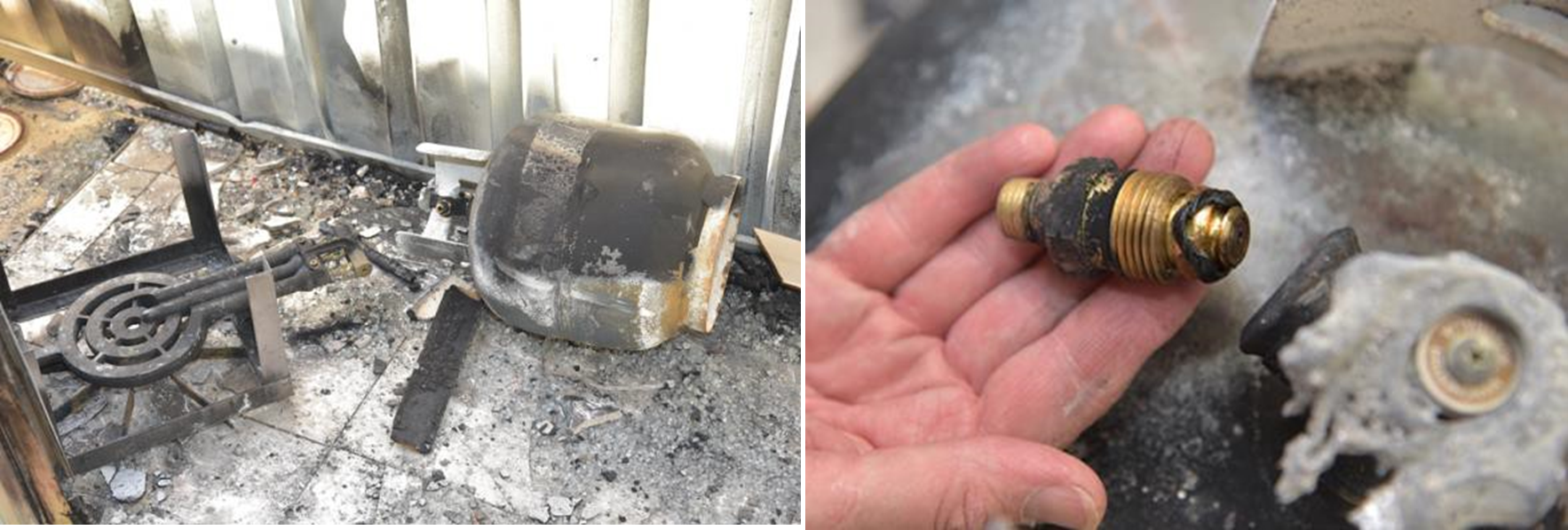
Figure A1 G 21: Outdoor portable wok burner and damaged POL connector involved in explosion incident
Figure A1 G 22: Comparison of Significant Incident Statistics
7.1.6. Electronic Gas Certificates of Compliance (eCoC)
The Gas Installation and Appliance Safety team have developed a new system to generate gas safety audits by utilising the electronic Certificates of Compliance (eCoC) email delivery platform. When a contractor/worker submits a gas eCoC. the recipient receives an email with a .pdf eCoC attachment, and in this email there is a link for the recipient to nominate an expression of interest to have the gas work indicated in the eCoC safety checked. When the recipient clicks on the link all they need to do is add the gas eCoC number, email address and confirm their contact details are correct, and then a case number is automatically created in PEGI and placed in the audit dashboard for the inspectors to access. The inspector simply contacts the recipient either by phone or email and arrange for a site visit to complete the audit. Emails can be dispatched in real time, thus improving communications with recipients to give them an option to have the recent gas work completed audited and safety checked. This process has been designed to increase efficiency for the gas team to create auditing opportunities.
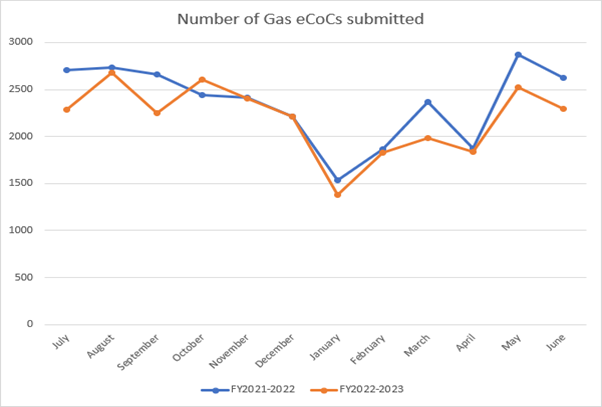
Figure A1 G 23: Gas electronic certificate of complaint submitted over the last two financial year
7.1.7. Communication and Education
Industry Liaison and Support
The Technical Regulator provides information about Standards to gas fitting contractors, architects, and engineers, as well as to commercial and industrial users of gas. During the year, staff handled approximately 7,568 technical enquiries relating to gas installations or appliances.
The Technical Regulator has developed several technical guides and bulletins which address the most commonly asked technical gas enquiries. These are provided at no charge, and, in some cases, we have versions for the public and the trade depending on the target group.
Technical Presentations
The gas installation and appliance safety team has been utilising eCoC system to contact all gas fitters registered to eCoC on a regular basis advising on standards updates, recruitment and webinars.
Section A8: Gas Products
The program audits and monitors retailer stores with a view to eliminating the sale of uncertified gas appliances in South Australia, targeting smaller stores that are less likely to be aware of certification requirements for gas appliances. The objective is to increase community awareness and change the behaviours of sellers. A risk-based approach is used to monitor physical stores.
Currently, the primary issue is the regulation of appliances sold via online marketplaces, i.e. eBay, Facebook marketplaces or Amazon. The OTR has been collaborating with Consumer and Business Services (CBS), the Australian Competition and Consumer Commission (ACCC) and other regulatory agencies in other jurisdictions to achieve better outcomes at a national level. The formation of a working group with other regulators aims to identify ways which reduce the risk of unsafe electrical and gas appliances sold via online marketplaces to Australia and New Zealand consumers. The working group objective is to increase consumers and suppliers/distributors’ awareness regarding certification requirements through education and to reduce sales of unsafe appliances through marketplaces as well as finding effective ways of monitoring marketplaces.
Over 2022-2023, the OTR monitored online marketplaces such as eBay, Amazon and Facebook and small physical retailer stores. The OTR was able to identify ten small retailer stores selling uncertified gas appliances and issued them with a warning letter. The OTR also requested the removal of several uncertified appliances from online marketplaces, such as eBay.
Section A9: Gas Regulatory Coordination
9.1. Committee Representation
The Technical Regulator is represented on, or has provided valuable technical comments, to several Standards Australia committees as well as many other committees, forums and associations.
9.1.1. AG-001, Gas Appliances Committee
In 2022-2023, the Technical Regulator participated on the AG-001 Gas Appliance Committee as a representative of the GTRC. The committee convened periodically throughout the year to discuss and review gas appliance safety issues and to carry out the ongoing review of the gas appliance standards.
The Committee presides over the harmonisation of the old AS 455x series of Standards (16 in all) as they are drafted across into the new joint AS/NZS 5263 series of Standards. This process began in 2010 and is ongoing with standards being revised and updated as required.
The following projects were undertaken during 2022-2023:
- Publishing of AS/NZS 5263.0 – Gas Appliances General Requirements. This is the main gas appliances standard and was revised for the first after its initial publication in 2017.
- Ongoing projects to include Nb gas into Type A standards, for standards which have not included limit gas testing for historical reasons. AS 4563, AS/NZS 5263.1.4, AS/NZS 5263.1.7, AS/NZS 5263.1.10 and AS/NZS
5263.1.11. All drafts have been completed with publication expected in the second half of 2023.
- Joint project between AG-001 and ME-093 members to put together an Australian Technical Specification, SA TS 5390 for the design and manufacturing of hydrogen appliances based on existing Australian Standards. The draft technical specification was completed and expected to go through public comments in the second half of 2023.
9.1.2. AG-008, Gas Distribution Committee (AS/NZS 4645)
In 2022-2023, the Technical Regulator participated in the AG-008 Gas Distribution committee as a representative of the GTRC. The committee members continued to carry out numerous discussions throughout the year using Microsoft Teams and through on-site meetings to address the future amendments to all three Parts of Gas Distribution Standard AS/NZS 4645 (Part 1: Network Management’, Part 2: ‘Steel pipe systems’ and Part 3: ‘Plastic pipe systems’).
The main areas of amendments for the Committee’s consideration covered the following: gas meter locations requirements, formal risk assessment criteria, gas quality assessment, gas incidents register systems and implementation of standardisation for Future Fuels e.g. hydrogen, biomethane and biogas. The issues related to gaps in legislation and technical and standards requirements to enable safe blending of hydrogen, biomethane and biogas in gas distribution networks represented the main focus of the recent discussions between the Committee members.
During the Committee’s activities, the Technical Regulator communicated information to and from industry stakeholders (e.g. gas distribution networks operators, Future Fuels Cooperative Research Centre (FFCRC) researchers, the public in South Australia, and GTRC) and Standards Australia (e.g. ME 093 Committee – Hydrogen Technologies) to ensure that their views are represented in the development of the future improvement to AS/NZS 4645.
It is expected that a formal proposal will be put together in the second half of 2023 to conduct a full revision of all three parts of the standard.
9.1.3. AG-010, Natural Gas Quality Specifications
The Technical Regulator is a member of the AG-010 Natural Gas Quality Specifications Committee as a representative of the GTRC. The committee is principally responsible for the review of AS 4564 – General Purpose Natural Gas which had last been published in June 2020.
AS 4564 lists the general characteristics of natural gas to be used for industrial, commercial or domestic use. Most jurisdictions call up this Standard in their legislation relevant to natural gas.
In 2022-2023, AG-010 did not undertake any specific activity, however, a proposal was approved in May 2023 to revise the standard to consider reference to hydrogen and reviewing the oxygen limit to facilitate injection of biomethane in gas networks. It is expected that this work will take place over the next two years.
9.1.4. ME-093 Hydrogen Technologies
In 2022, the Technical Regulator participated in the ME-093 Committee as a representative of the GTRC. This Committee was created as a mirror committee of the International Standard Committee ISO TC 197.
It incorporates a broad scope including hydrogen fuel cells, generators, production, storage, transport, use in networks and appliances and liaises on a regular basis with other Standards Australia Committees to identify gaps in Standards in regard to hydrogen.
The Technical Regulator was also involved with two working groups within ME-093, one related to gas distribution networks and one related to gas appliances, which are responsible for developing guidance documents for the industry as the first step of developing specific hydrogen Standards.
The following projects were undertaken during 2022-2023: Publishing of the following standards:
- AS 19880.1:2023 – Gaseous hydrogen – Fuelling stations, Part 1: General requirements (ISO 19880-1:2020, MOD).
- SA HB 225:2023 – Guideline for blending hydrogen into pipelines and gas distribution networks.
- SA TS 5359:2022 – The storage and handling of hydrogen.
- AS 62282.2.100:2022 – Fuel cell technologies, Part 2.100: Fuel cell modules – Safety (IEC 62282-2-100:2020 (ED.1.0) MOD).
Development of the following documents with publication expected later in 2023:
- AS 13984 – Liquid hydrogen – Land vehicle fuelling system interface.
- AS 13985 – Liquid hydrogen – Land vehicle fuel tanks.
As of the beginning of 2023, Standards Australia undertook a restructure of the committee and reduced the membership. As a result, the Technical Regulator is no longer involved with the main committee and the working groups, although it is expected that involvement with working groups will resume once relevant projects are put forward.
9.1.5. AG-006, Gas Installation Committee (AS/NZS 5601)
For 2022-2023, the OTR has provided committee representation on behalf of the GTRC nominated member.
The OTR is pleased to announce the new AS/NZS5601.1 – 2022 Gas Installation Standard has been published. This new standard replaces the old AS/NZS5601.1- 2013. Standards are reviewed or amended periodically to ensure they keep pace with design innovation on gas installations, consumer product development, and new engineering / industry practices appliance manufacturer requirements.
Legislation – Implementation
SA legislation automatically calls up referenced Standards including subsequent revisions and amendments. The new 2022 edition of the AS/NZS 5601 Part 1 was published on 30 September 2022. Technical Regulators allows for a transition period of 6 months for industry to transition to a new standard. We do this as stakeholders need time to adjust. As such, the OTR implemented the new standard on the 31 March 2023.
The AG-006 technical committee has continued to convene throughout the year with 2 technical committee meetings held in Brisbane in February 2023 and Melbourne in June 2023 as well as working group meetings held vis Teams’ meetings submitting project proposals for amendments and revisions of the following Standards:
- AS/NZS 5601.1:2022, Gas Installations, Part 1: General installations (yet to be published).
- AS/NZS 5601.2:2020, Gas installations, Part 2: LPG installations in caravans and boats for non-propulsive purposes.
The new published AS/NZS56.1.1 defines and aligns performance based and deemed to satisfy clauses, revisits and provides additional pipe sizing tables, homogenises defined terms with other standards where possible, introduces new terms and aligns the content to Standards ISO requirements for terms and language.
Volume III – Water and Plumbing Industry
Section A10: Water and Sewerage Infrastructure
10.1. Regulation of Water Industry Entities
10.1.1. Technical review of licence applications
There was one licence application and no licence exemption applications or licence variation applications received or reviewed during 2022-2023.
10.1.2. Safety, Reliability, Maintenance and Technical Management Plans (SRMTMPs)
The Technical Regulator reviewed and approved the following SRMTMPs during 2022-2023:
Table A1 W 1: Number of SRMTMPs received, reviewed and approved
| Year | SRMTMPs Received and Reviewed | SRMTMPs approved |
|---|---|---|
| 2022-2023 | 37 | 28 |
| 2021-2022 | 33 | 25 |
| 2020-2021 | 34 | 26 |
| 2019-2020 | 32 | 29 |
| 2018-2019 | 19 | 14 |
10.1.3. Water industry entity audits
During 2022-2023, a total of 15 audits of water industry entities were undertaken to confirm compliance with their SRMTMP and to ensure the safe and reliable operation of the infrastructure. The services that the water industry entities provided is included in Table W2.
Table A1 W 2: Number of audits undertaken in per type of services
| Type of services | Audits undertaken 2020-2021 | Audits undertaken 2021-2022 | Audits undertaken 2022-2023 |
|---|---|---|---|
| Drinking water, non-drinking water and sewerage | 2 | 3 | 2 |
| Drinking water | 1 | 0 | 0 |
| Drinking and sewerage | 0 | 0 | 1 |
| Non-drinking and drinking water | 0 | 0 | 1 |
| Non-drinking water and sewerage | 12 | 6 | 5 |
| Non-drinking water | 3 | 2 | 2 |
| Sewerage | 1 | 6 | 4 |
| TOTAL | 19 | 17 | 15 |
The licence type of water industry entities audited is included in in Table W3.
Table A1 W 3: Number of audits undertaken per type of licence
Type of licence | Audits undertaken 2020-2021 | Audits undertaken 2021-2022 | Audits undertaken 2022-2023 |
|---|---|---|---|
| Minor | 7 | 7 | 4 |
| Intermediate | 11 | 9 | 10 |
| Major | 1 | 1 | 1 |
| TOTAL | 19 | 17 | 15 |
10.2. Industry Training
10.2.1. Brown Card Training for South Australia
In May 2022, the OTR launched the SA Brown Card training for water industry entities and water industry contractors in South Australia.
The course was developed by the Queensland Water Directorate and the Water Skills partnership to educate the importance of, and requirements for, maintaining public health, minimising environmental harm as well as general workplace health and safety when working around sewerage and recycled water assets.
The OTR coordinated a review of the original Brown Card in conjunction with other South Australian Government departments to modify the training to include South Australian regulatory requirements. The training is supported by the South Australian Government and is available at no charge to water industry employees and contractors working with wastewater and recycled water in South Australia.
The training takes approximately 90 minutes to complete and consists of information slides and a short quiz. Once the training is complete a “Brown Card” certificate of completion is issued to the participating person and is valid for three years. The SA Brown Card is a non-accredited course but a valuable learning resource for sewerage and recycled water workplace health and safety basics.
Information on how to sign up to the SA Brown Card can be found on the OTR webpage. There were 135 completions of the SA Brown Card training during 2022- 2023.
10.2.2. Water Industry Operator of the Year
The Department for Energy and Mining (through the Office of the Technical Regulator) sponsored the 2022 South Australian Operator of the Year award. The award is presented to operations staff in the South Australian Water industry annually to recognise excellent performance, initiative, and all-round attention to detail. The South Australian Operator of the Year is run by the Water Industry Operators Association of Australia (WIOA), who is the peak body nationally for people in operational roles in the water industry.
Nominees of the award are required to be employed in South Australia and should have direct responsibility for operational decisions within network systems or at community water and wastewater facilities. WIOA consider key features when considering worthy recipients, which include:
- Continuing education/training achievement.
- Overall plant or system management and condition.
- Demonstrated attention to work, health and safety and other regulatory responsibilities.
- Initiative and innovation, demonstrating improved treatment efficiency.
The completed applications were judged by an independent panel nominated by WIOA and the winner of the South Australian Operator of the Year Award was announced at the 2023 WIOA South Australia Water Industry Operations Conference and Expo. Congratulations to the 2022 South Australian Operator of the Year Award winner, Jamie Hay from the District Council of Coober Pedy.
Section A11: Plumbing Installations
11.1. Plumbing Compliance
11.1.1. Expiation Notices and Enforcement
The following compliance activities were undertaken between 1 July 2022 to 30 June 2023:
- 6,553 plumbing audits were conducted.
- 20 enforcement notices and 12 warning letters were issued for breaches of the Water Industry Act 2012.
- 8 Expiation Notices were issued of which 5 were non-compliant plumbing, 3 were for not making appropriate bookings for inspection and one for working without a valid license (was subsequently withdrawn).
- 156 compliance investigations were initiated.
- 4 plumbing interviews were conducted to discuss non-compliant plumbing installations.
- 9 plumbing induction interviews were conducted.
- 3 re-inspection fees were issued.
- 11 investigations were referred to Consumer Business Services (CBS).
- 2 Freedom of Information (FOI) requests were processed.
Plumbing compliance investigations are instigated as a result of reports from customers alerting the OTR to non-compliant plumbing, or non-compliant plumbing being identified through sample audits of on-site plumbing installations. Plumbing installation audit results are monitored through a fortnightly data review allowing the Technical Regulator to ensure all outstanding non-compliant installations are rectified. The OTR Plumbing Section works with industry to achieve a high level of technical and safety outcomes for on-site plumbing installations in South Australia.
11.1.2. Plumbing Certificates of Compliance
For the period 1 July 2022 to 30 June 2023, 31,730 plumbing Certificates of Compliance were submitted to the Office of the Technical Regulator.
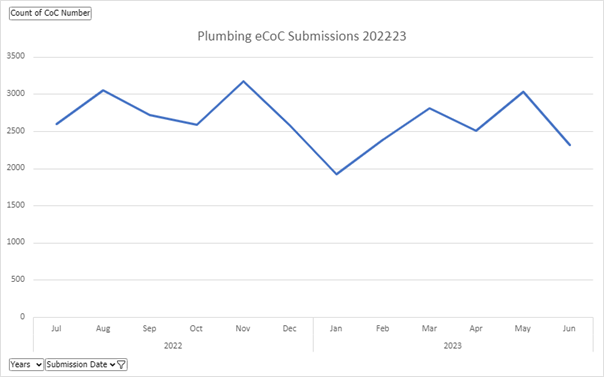
Figure A1 W 1: Plumbing Certificates of Compliance statistics
11.2. Plumbing Audits
11.2.1. Plumbing Bookings and Audits
Plumbers are required to notify the Office of the Technical Regulator when on-site plumbing and drainage installations are connected to SA Water infrastructure. Site audits are random and selected within the electronic Certificate of
Compliance (eCoC) ’Plumbbookings’ case management system. OTR audit allocations depend upon booking type, associated risks and relevant public safety issues (for example in-ground drainage, backflow protection, non-drinking water) and contractors case history.
The Technical Regulator conducted a total of 6,553 on-site plumbing audits and 573 desktop hydraulic design audits in 2022-2023. On-site audit included 108 final audits on newly constructed residential and commercial developments.
Table A1 W 4: On-site Plumbing Audits 2022 – 2023
Audit Category | Commercial | Residential | Total |
|---|---|---|---|
| Above Ground Sanitary Plumbing | 241 | 1,216 | 1,457 |
| Relining of Sanitary Drainage Pipework | 3 | 18 | 21 |
| Sanitary Drainage Installations | 235 | 1,308 | 1,543 |
| Trade Waste Plumbing | 203 | 203 | |
| Underfloor Plumbing | 225 | 1,614 | 1,839 |
| Non-Drinking Water (in ground) | 4 | 177 | 181 |
| Non-Drinking Water (in wall) | 11 | 336 | 347 |
| Non-Drinking Water Irrigation - Parks/Recreational | 3 | 2 | 5 |
| Non-Drinking Water (New Meter Connection) | 19 | 19 | |
| Drinking Water Irrigation - Parks/Recreational | 2 | 5 | 7 |
| Fire Services (in ground) | 210 | 0 | 210 |
| Fire FPAA101D | 3 | 0 | 3 |
| Hot Water Heater Installations | 21 | 219 | 240 |
| Hot and Cold (first fix) | 22 | 120 | 142 |
| Backflow Audit | 31 | 3 | 34 |
| Encumbrance Investigation | 5 | 30 | 35 |
| Site Inspection | 23 | 27 | 50 |
| Site Meeting | 27 | 18 | 45 |
| Final Audit | 108 | 108 | |
| Sewer Investigations | 5 | 28 | 33 |
| Water Investigations | 13 | 18 | 31 |
| Total | 1,414 | 5,139 | 6,553 |
Plumbing and drainage installations can range from the addition of a toilet en-suite on a residential home, to more complex commercial and industrial installations within shopping centres, industry, or multi-storey high-rise apartments. All plumbing audits are assessed against the Plumbing Standard (published by the Technical Regulator pursuant to section 66 of the Water Industry Act 2012). This Standard has adopted relevant sections of the Plumbing Code of Australia (PCA). All plumbing installations must meet the performance requirements of the PCA through the deemed-to-satisfy solutions as set out under the AS/NZS 3500 plumbing and drainage Standard or, in some cases, by a Performance Solution in accordance with the performance criteria set out under the PCA.
11.2.2. Metropolitan and Regional Audits
The OTR undertakes audits of plumbing installations in both the metropolitan and regional areas of South Australia. In 2022-2023, 5,990 audits were conducted with in the metropolitan areas of SA (refer to Figure A1 W2: Metropolitan on-site plumbing installation audits for 2022-2023).
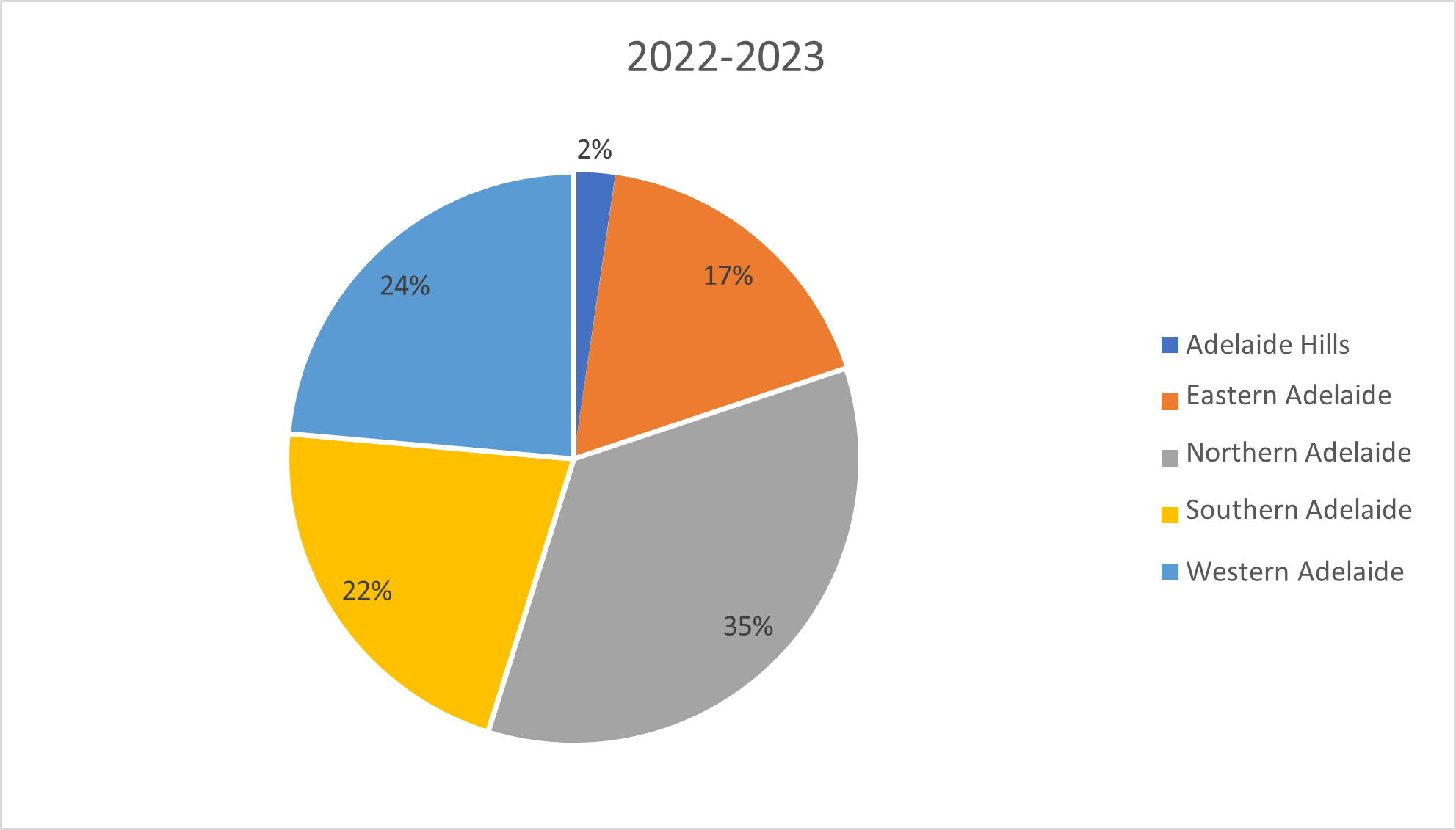
Figure A1 W 2: Metropolitan on-site plumbing installation audits for 2022-2023
The Technical Regulator has continued to maintain its regulatory presence in regional areas of South Australia via programmed audits of on-site plumbing.
In 2022-2023, 563 audits were conducted in regional areas of South Australia (refer to Figure below: Regional on-site plumbing installation audits for 2022-2023).
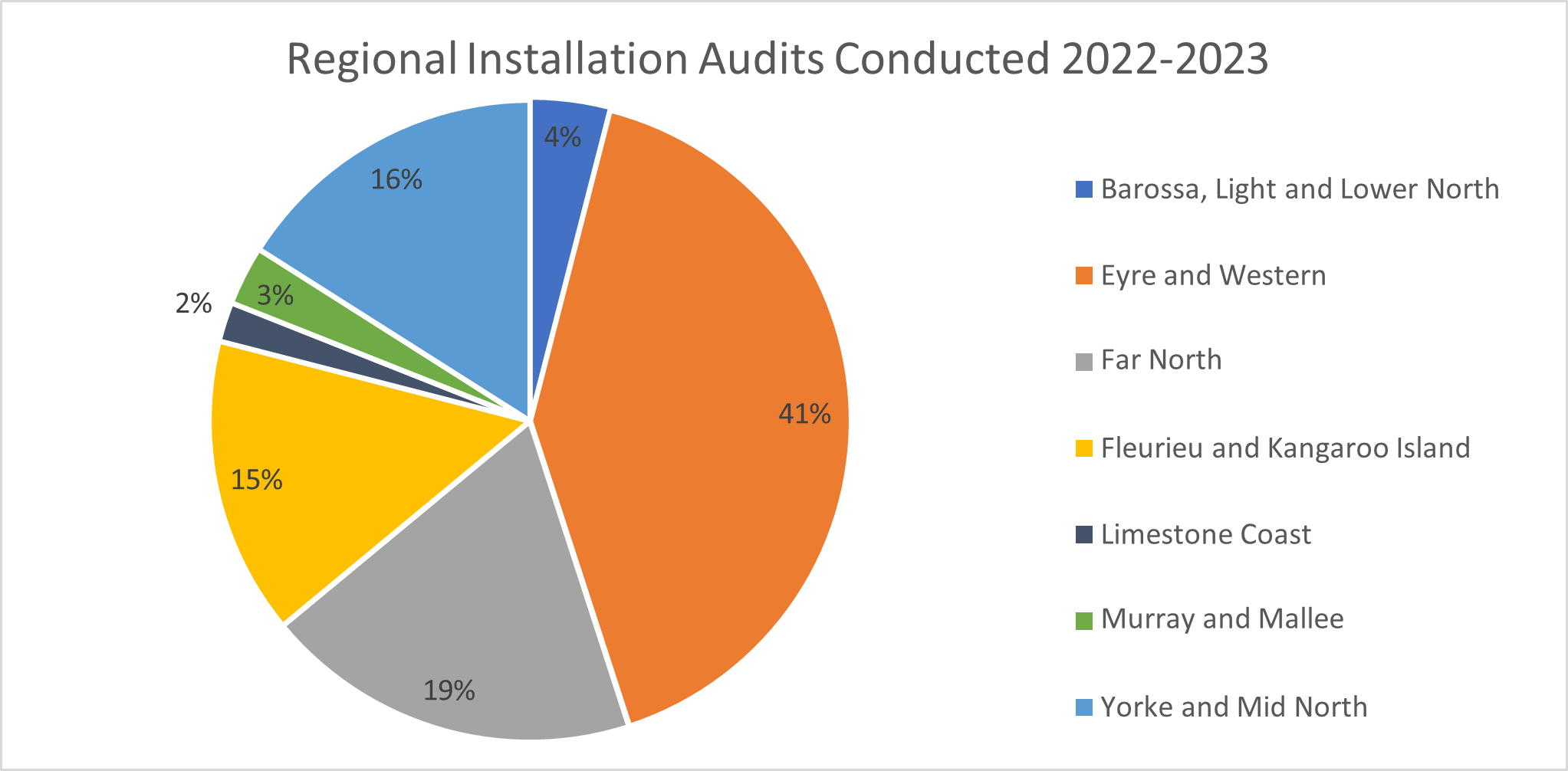
Figure A1 W 3: Regional on-site plumbing installation audits for 2022-2023
11.3. Fire Fighting and Non-drinking Water Services
The Technical Regulator consults with plumbing practitioners, hydraulic consultants, designers, and industry stakeholders on installations and hydraulic designs relating to inground fire hydrant services, drinking and non-drinking water services.
11.3.1. Fire Service Audits
During 2022-2023, 213 fire service audits were carried out. Hydraulic Design Submissions provided by the industry contractors were reviewed to assist the OTR in monitoring and auditing on-site fire service installations and audits of on-site water services.
The Office of the Technical Regulator is not the regulator for fire sprinkler systems. However, where fire sprinkler systems are interconnected with a building’s drinking water pipework, the OTR undertakes sample audits of these systems to ensure the safety of the drinking water supplies to the building.
The Australian Building Codes Board have referenced a new fire sprinkler system specification into the National Construction Code Volume 3. The new system is the FPAA101D specification. The design and installation of these new systems has been subject to desk top auditing and on-site compliance checking. These types of systems are not yet common throughout the industry but there is an expectation for growth in popularity to occur due to the anticipated industry cost savings this system provides where compared to a conventional fire sprinkler system. These booking types are increasing due to wider industry awareness.
11.3.2. Non-Drinking Water Services Audit
OTR Plumbing Installations Inspectors conducted 552 non-drinking water audits on new residential dwellings, commercial properties and municipal parks plumbed with dual water services (drinking water and non-drinking water services). The trend to use non-drinking water as the primary irrigation supply for municipal parks and gardens remains constant, these public areas are audited to ensure separation of the services and public safety. Non-Drinking Water (New Meter Connection) booking type has been added this financial year to ensure that water entities are meeting the onsite plumbing requirements when they are connecting to the consumer pipework downstream of the meter.
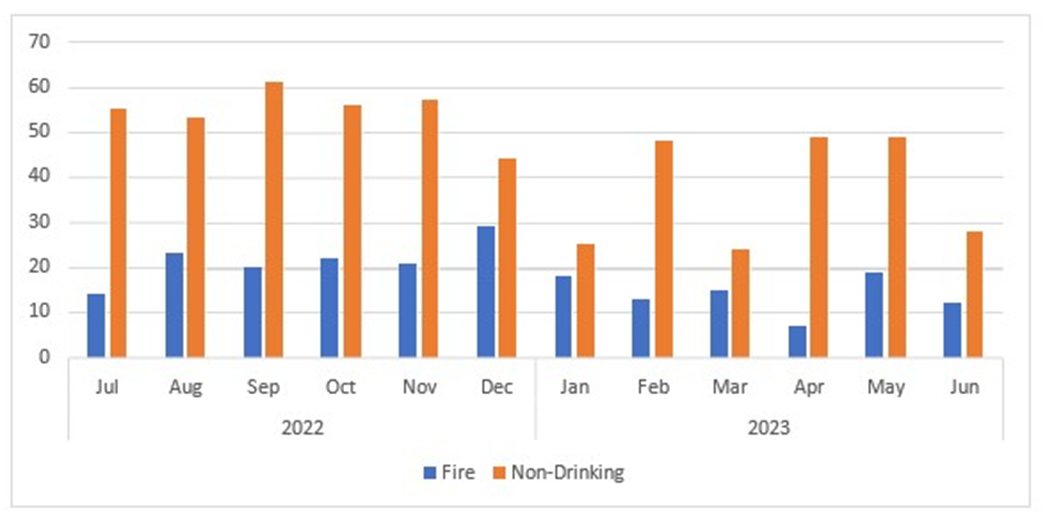
Figure A1 W 4: Fire service and non-drinking water audits for 2022-2023
11.4. Cross-connection Control and Backflow Prevention
The Technical Regulator audits on-site plumbing water service installations to ensure the safety of the drinking water network and to prevent cross-connections and backflow events. Testable Backflow prevention devices (where required) are connected to residential, commercial, and industrial sites to prevent contaminants entering a properties water service and the entity drinking water infrastructure.
Interactive Water Features (IWF) continue to be a popular installation in children’s play areas. The Office of the Technical Regulator has consulted with SA Health and produced an Industry Advisory Notice to assist in providing advice on the design of the plumbing and equipment installations associated with the interactive water features.
The OTR is working with SA Water to audit a range of metered water services identified on high-risk sites, the audits are to ensure the properties containment backflow prevention devices are compliant.
The Technical Regulator also continues to monitor backflow prevention devices installed in on-site plumbing systems. Property owners are obligated under section 69 of the Water Industry Act 2012 (the Act) to maintain equipment on the customer’s side of the connection point.
11.5. Industry Information and Training
The Technical Regulator works towards supporting the plumbing industry by providing important updates on regulatory matters which include amendments to the National Construction Code Volume 3 (Plumbing Code of Australia) and the AS/NZS 3500 Plumbing and drainage series. The OTR also advises industry on procedural and administrative matters, which ensures that industry has a full understanding of its responsibilities under the Act when designing and installing plumbing and drainage systems.
Seminars and information sessions are conducted both in person and by webinar. The Technical Regulator is chair of the Water Industry Technical Advisory Committee (WITAC) and is represented on the Plumbing Codes Committee (PCC) and the Plumbing Industry Reference Group (PIRG). Information is distributed through the publication of advisory notes, articles for the OTR’s Regulation Round Up newsletter and articles prepared for the Master Plumbers Association magazine. The OTR regularly hosts seminars and information sessions which are an effective tool for engaging the plumbing industry by providing valuable feedback when raising and clarifying concerns with regulatory and technical matters.
The Office of the Technical Regulator, in conjunction with the Master Plumbers Association of SA Inc, conducted plumbing industry Roadshows in Port Lincoln, Clare, Port Pirie, Port Augusta, Bamera, Tonsley, Ceduna, Wallaroo, Victor Harbor, Murray Bridge and Modbury during 2022-2023.
Information sessions were also conducted with TAFE and Peer plumbing students on Fire Hydrant Service, Non-Drinking Water and Backflow
Prevention installations. The OTR continues to provide advice to local council environmental health officers via local government association webinars and face-to- face meetings at local councils.
Fortnightly inspections and information sessions are also conducted with students at TAFE SA. This includes mock inspections of plumbing installations and liaising with TAFE lecturers with standards updates.
The Office of the Technical Regulator also conducted plumbing presentations at several plumbing firms during 2022-2023. Plumbing firms can invite the Technical Regulator to discuss changes to the Plumbing Code and AS/NZS 3500 plumbing and drainage standard series.
This year, the general theme of the roadshows revolved around providing updates on the revision of the AS/NZS 3500:2021 Plumbing and drainage standard series, the Plumbing Code of Australia 2022, and Watermark Certification for plumbing products. The roadshows also refreshed plumbers and stakeholders’ knowledge on compliance issues that plumbing inspectors see in the field.
Specific topics covered this year included:
- PCA Ratification.
- Installation of TMV’s and licensing requirements.
- Vacuum Drainage.
- Heated Water installations.
- Flood Hazard Mapping Plan SA.

Figure A1 W 5: 2023 Roadshow Seminar Topic
11.6. Property Interest Reporting and Data Management
11.6.1. Property Interest Reports
Property Interest Report responses are initiated when a vendor (such as a conveyancer or property owner) submits a Form 1 Vendors Statement through the Land Titles Office. If the OTR has a registered interest in the property listed on the Form 1 Vendors Statement, the OTR will respond with details of the interest. The OTR holds an interest in properties that have been identified to have non-compliant plumbing work or backflow prevention device maintenance requirements. This process is usually initiated when a property is being prepared for sale or transfer.
The Technical Regulator processed a total of 1,267 Property Interest Reporting (PIR) requests in 2022-2023 (refer Figure A1 W6 provides the monthly breakdown of PIR requests for 2022-2023).
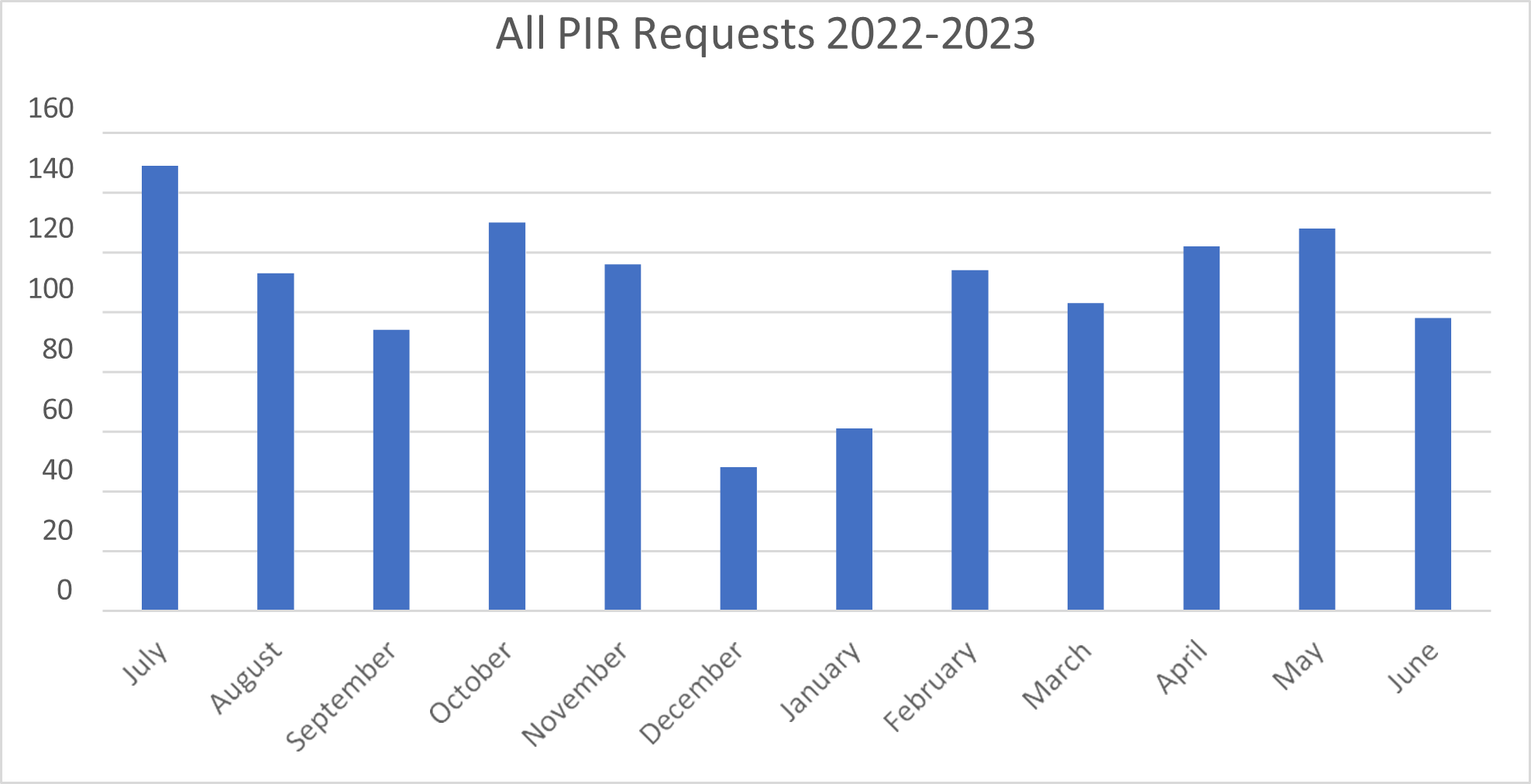
Figure A1 W 6: PIR monthly statistics for 2022-2023
11.6.2. Data Management
We are continuing to improve the procedures that are in place to prevent the receipt of unnecessary PIR requests. We refine these practices by completing regular cleansing of the database and interests held. This has kept the number of requests received at a manageable level.
The data cleansing measures we have put in place over the previous years has helped to ensure appropriate response wait times even during periods of peak demand. Response from stakeholders regarding these changes has continued to be positive and appreciated.
Section A12: Plumbing Products
12.1. Plumbing Products certified under the WaterMark Certification Scheme
The National Construction Code Volume Three – The Plumbing Code of Australia (PCA) sets out the performance requirements and deemed-to-satisfy-solutions for the design and construction of plumbing and drainage systems. The PCA also sets out the requirements for plumbing products used in the construction of a plumbing and drainage installation. Plumbing products are certified and authorised through the application of the WaterMark Certification Scheme.
The Australian Building Codes Board (ABCB) manages the WaterMark Certification Scheme (the Scheme), with the Plumbing Code Committee (which includes State and Territory government and industry representatives) helping in the administration of this Scheme. It is important to note that not all plumbing and drainage products require WaterMark certification and authorisation. All products proposed to be used in plumbing and drainage installations require a risk assessment to be undertaken, with products that have been identified through the risk assessment process as requiring WaterMark Certification listed in the Schedule of Products (WMSP).
Products that are low risk and not required to be WaterMarked are listed on the Schedule of Excluded Products (WMEP).
The Scheme’s objective is to deliver plumbing and drainage products that are safe and fit for their intended use in and around buildings in an environment that is increasingly challenged by reduced resources for enforcement, increased product non-conformity and an ever-expanding global market. The Office of the Technical Regulator represents South Australia on plumbing product certification matters.
The ABCB, in conjunction with WaterMark, has implemented lead free products which will be introduced in 2026. This work has been done with other state and territory regulators that sit on the plumbing codes committee.
South Australia as a member of the Plumbing Code Committee assists the ABCB in the development and revision of WaterMark technical specifications and Standards for the plumbing products. The OTR also ensures that WaterMark certified plumbing products installed in South Australia are meeting the requirements of the WaterMark scheme.
Section A13: Regulatory Coordination
13.1. Regulatory Reform - Plumbing Code and Technical Standards
13.1.1. Revision of the Plumbing Code of Australia
The Australian Building Codes Board (ABCB) has two primary technical advisory committees, the Building Codes Committee (BCC) and the Plumbing Code Committee (PCC). These Committees provide advice to the Board to deliver its work program by providing a national forum for regulatory authorities and industry to consider technical matters relevant to building and plumbing regulation reform.
The Office of the Technical Regulator represents South Australia on the PCC. Examples of recent and current work projects undertaken by the PCC include:
- Review of the 2022 National Construction Code.
- Undertaking research and development projects to provide valuable information and input into the development of the Plumbing Code of Australia (PCA). Recent research projects have included Sanitary plumbing and drainage pipe sizing and a project to verify hazard ratings for cross-connection control devices.
13.1.2. Plumbing and Drainage Standards projects
Standards Australia is a standards organisation recognised through a Memorandum of Understanding with the Australian Government as the peak non-government standards development body in Australia.
The Office of the Technical Regulator represents South Australia on several working sub-committees that review the AS/NZS 3500 Plumbing and Drainage standard series. The Office of the Technical Regulator participates on these sub- committees though our involvement with the Australian Building Codes Board who act as a conduit between state plumbing regulators and the WS14 (plumbing standards) committee.
Some of the recent plumbing and drainage projects the Office of the Technical Regulator has been involved with include:
- Sanitary drainage pipe sizing.
- Backflow requirements for Atmospheric Vacuum Breakers.
- Rainwater installation requirements.
We are also directly involved with AS2845 series which is the standard for backflow devices both design and testing. The WS23 committee is currently in the process of reviewing AS2845.1 Mechanical Backflow prevention devices materials, design, and performance requirements.
13.1.1. Dual Reticulation Infrastructure Standard
The Technical Regulator has published the Standard for Dual Reticulation Infrastructure (266.6 KB PDF). It prescribes the minimum requirements and responsibilities of all parties involved in dual reticulation infrastructure to ensure the safety and reliability of the water services provided to South Australian consumers.
The Standard has been published after extensive consultation with stakeholders from the South Australian water industry.
The intent is not for legacy assets to be updated, but that going forward, the design, installation and construction of dual reticulation infrastructure including — up to the point of connection to a property — will be in accordance with the Standard.
This Standard is in addition to requirements set out in the Water Services Association of Australia (WSAA) codes.
13.1.4. Infrastructure Standard
The Technical Regulator has published an Infrastructure Standard which adopts the Water Services Association of Australia (WSAA) codes as the principle minimum Standard for water and sewerage infrastructure.
The intent is not for legacy assets to be updated, but that going forward, WSAA codes, supplementary notices and supporting documents which are equivalent to or exceed WSAA requirements shall be used for any design, installation, inspection, alteration, repair, maintenance, removal, disconnection or decommissioning of water and sewerage infrastructure.
The WSAA codes complement standards, codes and guidelines in current legislation – a copy is available for viewing at the Office of the Technical Regulator.
By recognising the WSAA codes as the Infrastructure Standard, the Office of the Technical Regulator recognized that the WSAA codes have gone through a peer-review process and are widely accepted for the requirements of water and sewerage infrastructure.
If utilities produce supplementary notices and supporting documents which are equivalent to or exceed WSAA requirements, then these will be recognized as suitable as part of this standard.
13.2. Water Industry Technical Advisory Committee (WITAC)
For the period from 1 July 2022 and 30 June 2023, two technical advisory meetings were held on 19 July 2022 and 7 December 2022. Topics covered at the meetings included:
- Update on water and sewerage infrastructure.
- Water and sewerage infrastructure audit feedback.
- National Performance Report indicator review update and trials.
- Updates to the water and sewerage infrastructure Annual Internal Audit Checklist.
- Introduction of Brown Card training for South Australia.
- Plumbing roadshows and industry communication.
- Plumbing regulation report.
- Plumbing Code of Australia projects.
- Standards Australia projects.
- Continuous professional development.
- Plumbing National Standard/specification reviews.
- Certificates of Compliance Scheme.
Volume IV – Key Performance Indicators
Table K 1: ElectraNet Key Performance Indicators
| Performance Indicator | Performance Measured | Definition of Indicator | 2019-20 | 2020-21 | 2021-22 | 2022-23 |
|---|---|---|---|---|---|---|
| Substation Routine Task Rate | Volume of planned substation maintenance | Number of Substation Routine Tasks completed | 5,910 | 5,668 | 6,396 | 6,544 |
| Line Routine Task Rate | Planned line maintenance during the period | Number of Line Routine Tasks completed during the reporting period | 1,790 | 1,889 | 839 | 2,701 |
| Substation Corrective Task Rate | Unplanned Substation maintenance during the period | Number of Substation Corrective Tasks completed during the reporting period | 7,768 | 6,079 | 6,528 | 5,482 |
| Line Corrective Task Rate | Unplanned Line maintenance during the period | Number of Line Corrective Tasks completed during the reporting period | 7,791 | 8,609 | 6,120 | 7,488 |
| Vegetation Infringements | Vegetation maintenance | Number of reported vegetation infringements unresolved within 7 days during the fire season | 0 | 0 | 0 | 0 |
| Fire Starts | Line maintenance | Number of fire starts caused by ElectraNet transmissio n assets. | 0 | 3 | 2 | 0 |
Major Plant Failure Events | Events reported under 73(3)(a) of the Electricity (General) Regulations 2012 | Number of failures of major plant requiring replacement (eg. HV transformers, circuit breakers, disconnectors, instrument transformers | 0 | 5 | 7 | 10 |
| Electric Shock Reports | Safety | Number of shock reports | 1 | 0 | 0 | 0 |
| Switching Incident Rate | Switching safety | Number of switching incidents per number of switching plans issued | 0.08% | 0.40% | 0.37% | 0.54% |
| Lost Time Injuries | Safety | Number of injuries resulting in more than one day lost | 0 | 0 | 0 | 0 |
| Lost Time Injury Frequency Rate | Safety | Number of injuries resulting in more than one day lost per million hours worked | 0 | 0 | 0 | 0 |
| Medical Treatment Injuries | Safety | Number of medical treatment injuries | 0 | 0 | 0 | 0 |
| Medical Treatment Injury Frequency Rate | Safety | Number of medical treatment injuries per million hours worked | 0 | 0 | 0 | 0 |
| Contractor Safety Incidents involving Injury | ElectraNet’s contractor safety | Number of reported construction and maintenance contractor safety incidents involving injury | 7 (2 LTI & 5 MTI) | 8 (0 LTI & 8 MTI) | 7 (0 LTI & 7 MTI) | 10 (1 LTI & 9 MTI) |
| Emergency Management Plan Exercises | ElectraNet’s emergency response preparedness | Number of completed Emergency Management Plan exercises | 7 | 5 | 4 | 2 |
Table K 2: SA Power Networks Key Performance Indicators
| Safety Management Indicators | 2019-20 | 2020-21 | 2021-22 | 2022-23 |
|---|---|---|---|---|
| Annual cumulative numbers of lost time accidents involving SA Power Networks personnel (including contractors) | 8 Lost Time | 15 Lost Time | 4 Lost Time | 8 Lost Time |
| Annual cumulative numbers of near misses involving SA Power Networks personnel (including contractors) | 964 Near Miss | 1,186 Near Miss | 1,012 Near Miss | 926 Near Miss |
| Hazard logs greater than 30 days old | 5 | 67 | 46 | 43 |
| Number of in progress hazard logs | 15 | 100 | 221 | 94 |
| Actual workplace inspections carried out per annual inspections planned1 | 2,604/2,179 | N/A2 | 4,938/5,827 | 5,012/5,368 |
| Number of shock reports per 1,000 km of mains | 8.5 | 7.7 | 8.3 | 7.6 |
| Number of damage claims per 1,000 km of mains | 2.0 | 2.4 | 1.5 | 1.6 |
| Number of fire starts per 1,000 km of mains | 0.7 | 0.6 | 0.4 | 0.6 |
| Number of switching incidents | 27 | 24 | 22 | 13 |
| Number of completed emergency plan exercises | 6 | 5 | 4 | 4 |
Technical Management Indicators | ||||
| Percentage of meters within tolerance (per planned sample) | 96.68% | 88.30% | 90.5% | 94.3 |
General Information | ||||
| Number of requests for underground locations provided per year | 118,638 | 113,485 | 118,461 | 127,794 |
| Number of revenue metering investigations carried out per year | 1,276 | 1,451 | 1,359 | 1,188 |
| Audited compliance against internal vegetation clearance procedures and agreements | Completed by GHD and OTR in November 2019 | Completed by GHD in November 2020 | Completed by GHD in November 2021 | Completed by GHD in November 2022 |
Note 1: Estimate only by SA Power Networks.
Note 2: Access Permits are issued for all Requests for Network Access (RNA) & for ad-hoc requests to cut trees by SA Power Networks engaged tree cutters or to dig near SA Power Networks’ cables.
Table K 3: APA Group’s Key Performance Indicators
Key Performance Indicators (KPIs) for the distribution networks, as supplied by Australian Gas Networks (AGN), owner of the gas distribution networks in South Australia, and the APA Group, operator of these networks, are as follows:
KPI Section | Aspects measured |
|---|---|
| 1. Safety | Network and public safety |
| 2.Measurement | Accuracy and reliability of gas metering and measurement of gas heating value |
| 3. Quality | Natural gas quality |
| 4. Reliability | Reliability of gas supply and equipment |
| 5. Connections | Safety and soundness of customer connections to the pipeline network |
| Key Performance Indicator | 2020- 2021 | 2021- 2022 | 2022- 2023 |
|---|---|---|---|
| 1. Safety | |||
| 1.1. The maintenance of continuous, reliable gas supply | |||
| Number of complaints of poor supply pressure | 4 | 11 | 2 |
| Number of gas outages (>5 consumers affected) | 20 | 12 | 23 |
| 1.2. Instances of third-party damage | |||
| Number of damages to the mains and services, caused by third parties | 460 | 475 | 434 |
| Number of DBYD locations provided to third parties | 88,785 | 94,602 | 99,902 |
| 1.3. Dealing with potential accidents or unsafe situations | |||
| Emergency plan exercises | 3 | 2 | 2 |
| Number of evacuations directly attributed to a gas leak from mains or inlet services | 1 | 1 | 0 |
| Number of instances where a gas leak from a network enters a building | 6 | 6 | 4 |
| Number of fires or explosions caused by a gas leak from a network | 1 | 0 | 0 |
| 2. Measurement | |||
| 2.1. Extent to which meters are being changed over (Gas Measurement Management Plan) | |||
| Number of Meters changed: Domestic | 17,184 | 17,627 | 15,200 |
| Number of Meters changed: Industrial/commercial | 533 | 646 | 556 |
| Number of overdue meters with: 10 years’ life | 299 | 405 | 433 |
| Number of overdue meters with: 15 years’ life | 165 | 117 | 122 |
| 3. Gas Quality | |||
| 3.1. The quantity of gas entering the Distribution System | |||
| Total gas entering the Distribution System (including farm taps) (TJ) | 31,396 | 31,432 | 30,437 |
| 3.2. The maintenance of continuous, reliable gas supply | |||
| Number of poor combustion/poor pressure incidents reported | 4 | 11 | 2 |
| Number of excursions exceeding one-fifth of the Lower Explosive Limit (LEL) | 6 | 9 | 2 |
| Number of excursions below 7 mg/m3 total odorant | 20 | 23 | 22 |
| Total number of excursions from the gas quality requirements, as specified in AS 4564 | 0 | 0 | 0 |
| 4. Reliability | |||
| 4.1. Description and specification of Distribution System and its components | |||
| Length of distribution system (km) | 8,498 | 8,529 | 8,621 |
| 4.2. Mains replacement program2 | |||
| Total Length of mains replaced (km) | 203.8 | 152.9 | 178.41 |
| 4.3. Total amount of UAFG lost from the Distribution System as a result of leakage or an activity referred to in Section 82(1) of the Gas Act 1997 | |||
| Total UAFG (TJ) (Based on AEMO data as at 30 June of each year) | 437 | 392 | 312 |
| 4.4. The extent to which the public are reporting gas leaks – mains and inlets services | |||
| Number of public reports of leaks (mains and services, excluding third party damages) | 1,304 | 1,545 | 1,149 |
| Percentage of publicly reported gas leaks where gas leak was found | 85% | 80% | 86% |
| Number of leaks detected by Leakage Surveys (per km of surveyed mains) | 0.15 | 0.15 | 0.10 |
| 4.5. Extent of Training | |||
| Percentage of refresher training compliance to scheduled volumes | 87% | 92% | 92.6% |
| 5. Connections | |||
| 5.1. Extent of access to system as required by return | |||
| Number of consumer connections (at 30 June each year) | 466,438 | 471,662 | 476,905 |
| Number of new connections completed | 8,005 | 7,433 | 7,371 |
Appendix 2: OTR Background
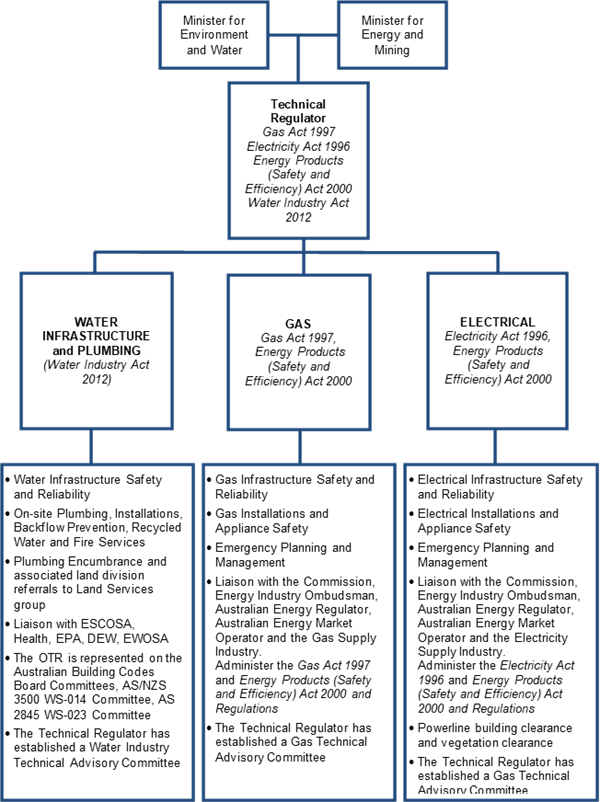
Appendix 3: Electronic Certificates of Compliance Form
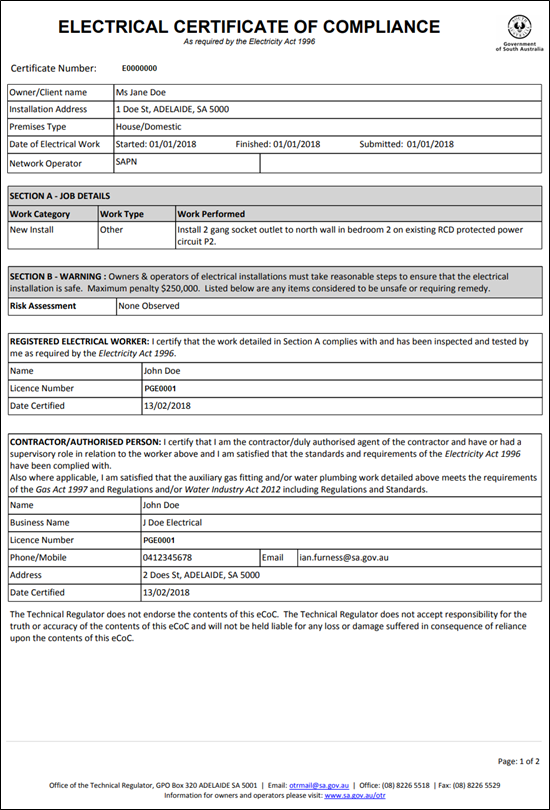
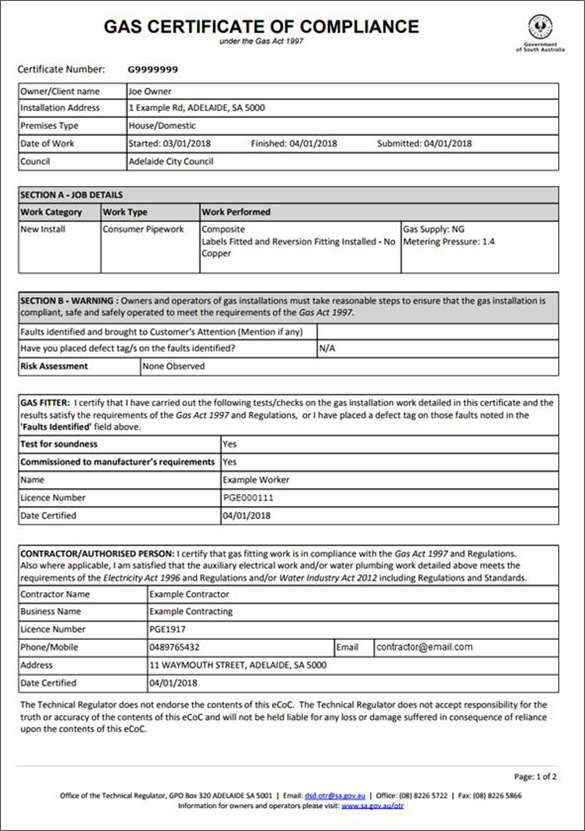
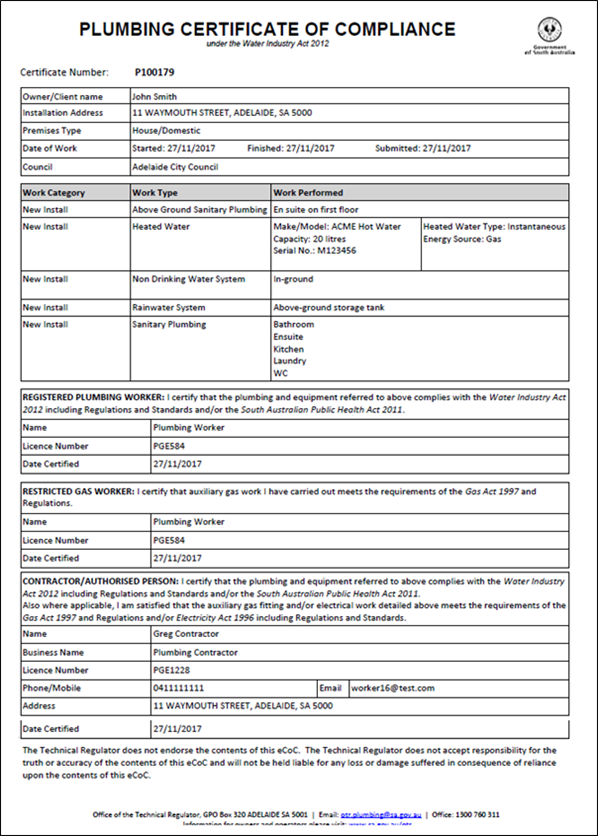
Appendix 4: Electrical Products
A4.1. Proclaimed Electrical Products
There are over 604 classes of products proclaimed under the Energy Products (Safety and Efficiency) Act 2000 for safety purposes. Proclaimed products are also known as Level 3 electrical equipment, and the full list of current regulated Level 3 products can be found on EESS.
Appendix 5: Electrical definitions, formulas and units
A5.1. Definitions
| Availability | Percentage of time over a year when generating plant was available (after megawatt losses due to outages are taken into account); based on megawatt hours. |
| Cogeneration | Production of useful heat and electricity from the same quantity of fuel. |
| Distribution Licence | An industry code administered by ESCOSA (adherence to the Code is a condition of a distribution licence). |
| Meshed | Part of a ring main where failure at one point can be isolated and supply system back-fed from elsewhere in the system as opposed to a radial system, which has only one point of supply. |
| Network Outage Time | A measurement of the time that the network cannot supply energy |
| Reliability | Indication of capability of electricity supply system to meet demand; measured by the number of hours when plant was out of service. |
| SAIDI | The total of the duration of each customer interruption (in minutes) divided by the total number of customers averaged over the year. |
| SAIFI | The total number of customer interruptions divided by the average total number of customers over the year. |
| Generation | Production of electricity in power stations, solar arrays and wind farms. |
| Transmission | Transport of electricity to the distribution network by high voltage transmission lines. |
| Distribution | Delivery of electricity to consumers through the lower voltage network. |
| Reliability of supply | Ability to maintain sufficient generation or flow of electricity to meet the demand of end users. |
| Security of supply | Ability to provide responses to the failure of plant and equipment so as to continue the supply of electricity. |
| Transmission | Circuit availability, measured by the hours all circuits are available expressed as a percentage of the total possible hours they could be available. |
| Distribution reliability | Total duration of customer supply interruptions (minutes off supply) per customer per annum, averaged over the year Measured by the System Average Interruption Duration Index (SAIDI). |
A5.2. Performance Indicator Definitions
| Planned outages | Planned outages generally involve overhaul work, either on a unit or components, planned well in advance, usually by more than a year. |
| Maintenance outages | Maintenance outages require the removal of a unit or component from service for work which can be deferred beyond the next weekend but must be carried out before the next planned outage. |
| Forced outages | Forced outages involve the removal of a unit or component from service for work that cannot be deferred beyond the next weekend. The term “equivalent” refers to the conversion of partial outages to equivalent full outages. |
| Starting reliability | Starting reliability is the percentage of time the plant actually starts when called upon. |
A5.3. Performance Indicator Formulae
Planned Outage Factor
MWh out of service due to planned outage x 100%
______________________________________________________
Installed plant capacity (𝑀𝑊) × 8760 ℎ𝑜𝑢𝑟𝑠
Maintenance Outage Factor
MWh out of service due to maintenance outages x 100%
____________________________________________________________
Installed plant capacity (𝑀𝑊) × 8760 ℎ𝑜𝑢𝑟𝑠
Equivalent Forced Outage Factor
MWh out of service due to forced outage x 100%
____________________________________________________
Installed plant capacity (𝑀𝑊) × 8760 ℎ𝑜𝑢𝑟𝑠
Equivalent Availability Factor
(Installed plant capacity (MW) x 8,760 – MWh losses due to outages) x 100%
___________________________________________________________________________________
Installed plant capacity (𝑀𝑊) × 8760 ℎ𝑜𝑢𝑟𝑠
Medical Injury Frequency Rate
Number of occurrences in the period
_____________________________________________________________ × 1,000,000
Numbers of hours worked in the period
A5.4. Units
| J | Joule – unit of energy |
| W | Watt (1W = 1 joule/second) – unit of power |
| Wh | Watt-hour (1Wh = 3,600J) – unit of electrical energy |
| V | Volt – unit of voltage |
| VAR | Volt Amp Reactive – unit of reactive power |
A5.5 Prefixes
| m(milli) | 10-3 |
| k(kilo) | 103 (thousand) |
| M(mega) | 106 (million) |
| G(giga) | 109 (billion) |
| T(tera) | 1012 (trillion) |
Appendix 6: Plumbing Standard

Appendix 7: Scheme for Plumbing Certificates of Compliance
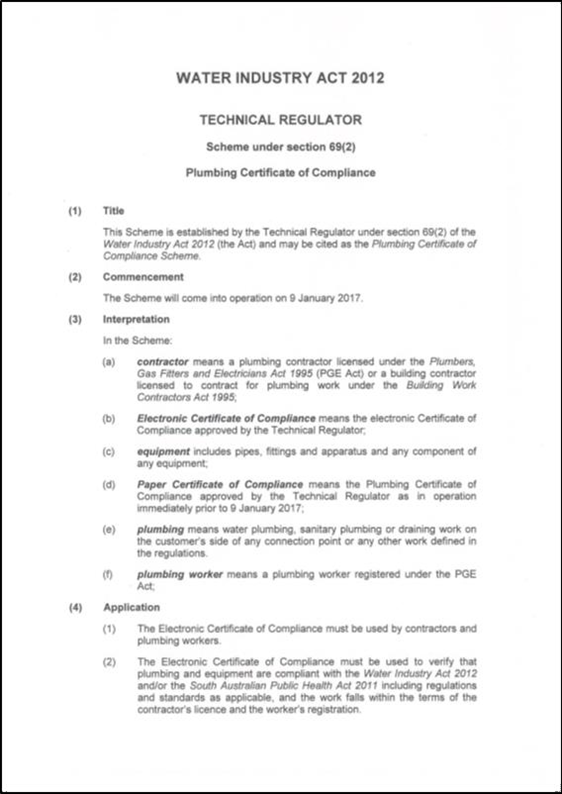
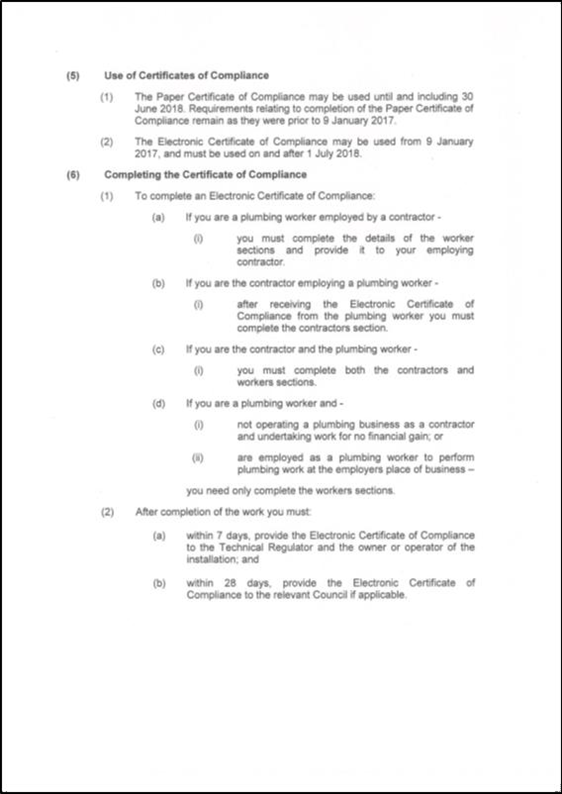
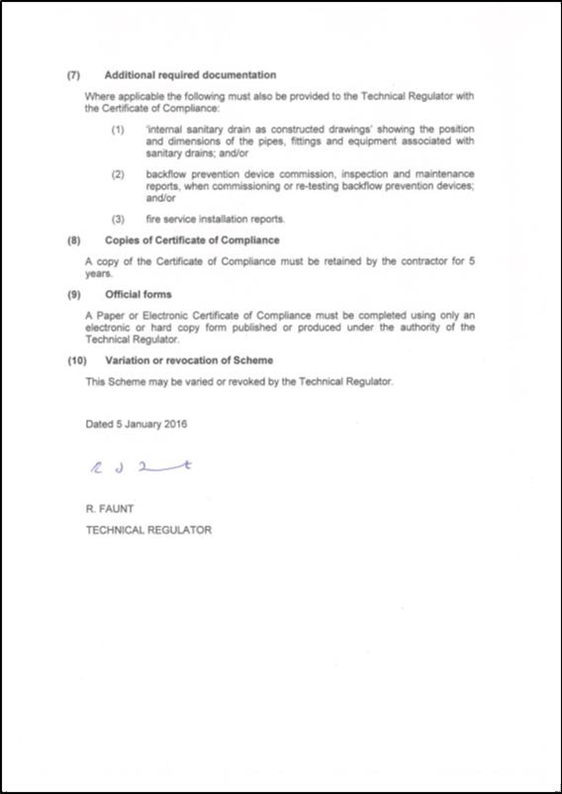
Appendix 8: Example of internal Drain as Constructed Drawing
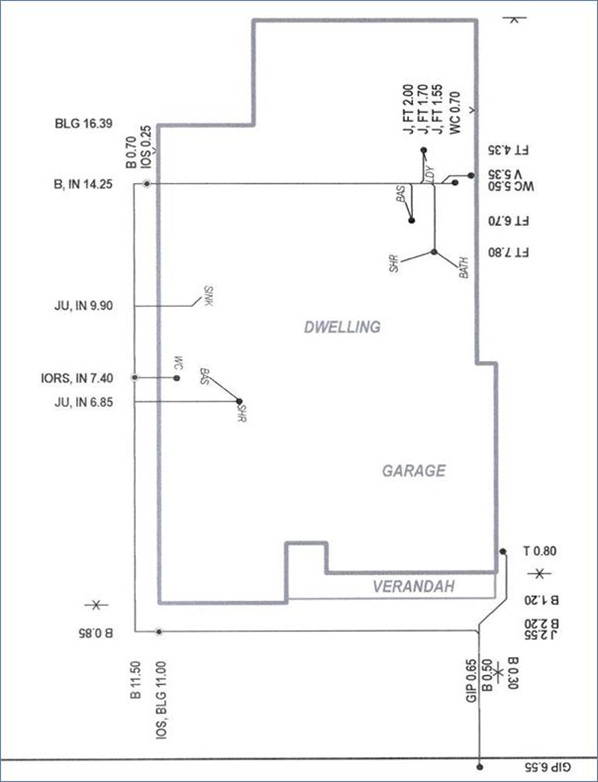
Appendix 9: Plumbing Code within the regulatory framework
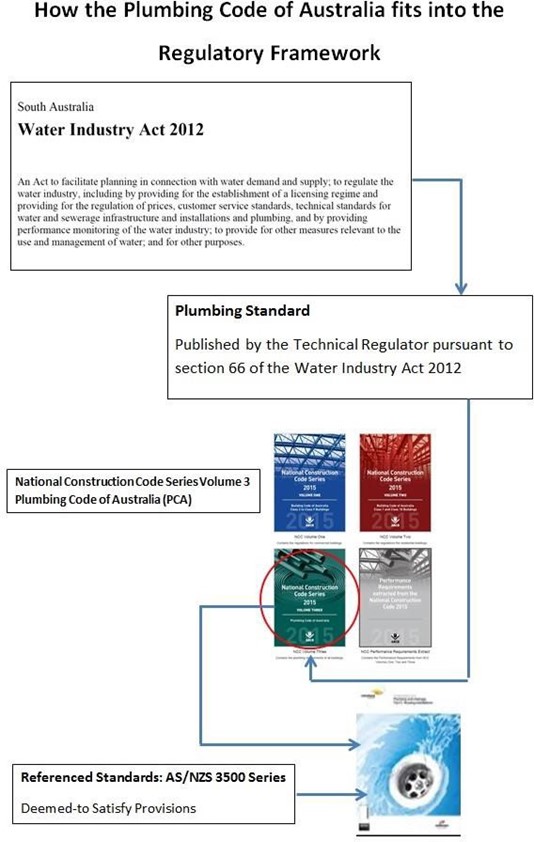
Appendix 10: Water Industry Entities and licences
| Licensee | Licence category | Drinking water | Non-drinking water | Sewerage |
|---|---|---|---|---|
| Adelaide Hills Berry Farms Pty Ltd | Minor | No | Yes | No |
| Adelaide Hills Council | Intermediate | No | No | Yes |
| Adelaide Plains Council | Minor | No | No | Yes |
| Alano Utilities Pty Ltd | Intermediate | No | No | Yes |
| Alexandrina Council | Intermediate | No | Yes | Yes |
| Berri Barmera Council | Intermediate | No | Yes | Yes |
| BHP Billiton Olympic Dam Corporation Pty Ltd | Minor | Yes | No | No |
| City of Onkaparinga - sewerage | Intermediate | No | No | Yes |
| City of Onkaparinga - water | Minor | No | Yes | No |
| City of Port Adelaide Enfield | Minor | No | Yes | Yes |
| City of Port Lincoln | Minor | No | Yes | No |
| City of Salisbury | Intermediate | No | Yes | No |
| City of Tea Tree Gully | Minor | No | Yes | No |
| City of Playford | Minor | No | Yes | No |
| Clare & Gilbert Valleys Council | Intermediate | No | Yes | Yes |
| Coorong District Council | Intermediate | No | Yes | Yes |
| Copper Coast Council | Intermediate | No | No | Yes |
| CPE Tonsley Pty Ltd | Intermediate | No | Yes | No |
| District Council of Barunga West | Intermediate | No | No | Yes |
| District Council of Ceduna | Intermediate | Yes | Yes | Yes |
| District Council of Cleve - Arno Bay | Minor | No | No | Yes |
| District Council of Cleve - Cleve | Minor | No | No | Yes |
| District Council of Coober Pedy | Intermediate | Yes | Yes | Yes |
| District Council of Elliston | Minor | Yes | Yes | Yes |
| District Council of Franklin Harbour | Intermediate | Yes | No | Yes |
| District Council of Grant | Intermediate | No | No | Yes |
| District Council of Karoonda East Murray | Minor | No | No | Yes |
| District Council of Kimba | Minor | No | Yes | Yes |
| District Council of Lower Eyre Peninsula | Intermediate | No | No | Yes |
| District Council of Mount Barker | Intermediate | No | Yes | Yes |
| District Council of Mount Remarkable | Intermediate | Yes | No | Yes |
| District Council of Orroroo Carrieton | Minor | No | Yes | Yes |
| District Council of Peterborough | Intermediate | No | No | Yes |
| District Council of Robe | Intermediate | No | No | Yes |
| District Council of Streaky Bay | Intermediate | No | No | Yes |
| District Council of Tumby Bay | Intermediate | No | Yes | Yes |
| District Council of Loxton Waikerie | Intermediate | No | No | Yes |
| ERA Water | Minor | No | Yes | No |
| F.B. Pipeline Pty Ltd | Minor | Yes | No | No |
| Fairmont Utilities Pty Ltd | Intermediate | Yes | Yes | Yes |
| Flinders Ranges Council - Hawker | Minor | No | No | Yes |
| Flinders Ranges Council - Quorn | Minor | No | No | Yes |
| Kangaroo Island Council | Intermediate | No | No | Yes |
| Kingston District Council | Intermediate | No | No | Yes |
| Light Regional Council | Intermediate | No | Yes | Yes |
| Lightsview Re-Water Supply Co Pty Ltd | Intermediate | No | Yes | No |
| Michell Infrastructure Pty Ltd | Minor | No | Yes | No |
| Mid Murray Council | Intermediate | No | Yes | Yes |
| Monarto Water Network Ltd | Minor | No | Yes | No |
| Municipal Council of Roxby Downs | Intermediate | Yes | No | Yes |
| Naracoorte Lucindale Council | Minor | No | No | Yes |
| Northern Areas Council | Intermediate | No | Yes | Yes |
| NWIC Pty Ltd | Intermediate | No | Yes | No |
| Port Augusta City Council | Intermediate | No | Yes | Yes |
| Port Pirie Regional Council | Intermediate | No | No | Yes |
| Regional Council of Goyder – Burra | Minor | No | No | Yes |
| Regional Council of Goyder – Eudunda | Minor | No | No | Yes |
| Renmark Paringa Council | Intermediate | No | No | Yes |
| Robusto Investments Pty Ltd | Minor | Yes | No | No |
| Rural City of Murray Bridge | Minor | Yes | Yes | Yes |
| South Australian Water Corporation (SA Water) | Major | Yes | Yes | Yes |
| Southern Mallee District Council | Intermediate | No | Yes | Yes |
| Tatiara District Council | Intermediate | No | Yes | Yes |
| The Barossa Council | Intermediate | No | Yes | Yes |
| The City of Charles Sturt | Intermediate | No | Yes | No |
| The Corporation of the City of Marion | Minor | No | Yes | No |
| The Corporation of the City of Whyalla | Minor | Yes | Yes | No |
| Wakefield Regional Council | Intermediate | No | No | Yes |
| Wattle Range Council | Intermediate | No | No | Yes |
| Wudinna District Council | Minor | No | Yes | Yes |
| Yorke Peninsula Council | Intermediate | Yes | No | Yes |
Appendix 11: Glossary and Abbreviations
| ABCB | Australian Building Codes Board |
| AC | Alternating Current |
| ACCC | Australian Competition and Consumer Commission |
| AEMO | Australian Energy Market Operator |
| AER | Australian Energy Regulator |
| AGA | Australian Gas Association – this is a gas appliance certification body (CAB) proclaimed by the Governor |
| AGN | Australian Gas Networks Limited (formerly known as Envestra Limited) – the entity holding a gas distribution licence in South Australia |
| AHSCA | Association of Hydraulic Services Consultants Australia (South Australia) |
| AMP | Asset Management Plan |
| APA Group | Australian Pipeline Group and other associated entities |
| AS | Australian Standard |
| AS/NZS | Australian or Joint Australian/New Zealand Standards |
| AWA | Australian Water Association |
| BBQ | Barbecue |
| BCA | Building Code of Australia |
| BCC | Building Codes Committee |
| BOM | Bureau of Meteorology |
| CAB | Conformity Assessment Body |
| CBD | Central Business District |
| CBS | Consumer Business Services – The licensing authority in SA |
| CCASA | Caravan and Camping Association of South Australia |
| CFS | Country Fire Service |
| CI | Cast Iron |
| CO | Carbon Monoxide |
| CoC | Certificate of Compliance |
| CWMS | Community Wastewater Management Scheme |
| DC | |
| Deemed-to- Satisfy provisions | The Deemed-to-Satisfy provisions are an optional means of achieving compliance with the mandatory Performance Requirements |
| DBYD | ‘Dial Before You Dig’ – This telephone (1100) and internet service provides location information on infrastructure, such as gas pipelines, to protect these assets during excavation work |
| DHW | Department for Health and Wellbeing |
| DIT | Department for Infrastructure and Transport |
| eCoC | Electronic Certificate of Compliance |
| ElectraNet | Short form of ElectraNet SA, the trading name of ElectraNet Pty Limited |
| EMPIA | Electronic Management of Plumbing Inspections and Audits |
| EPA | Environment Protection Authority |
| Equipment | Includes – (a) Pipes, fittings and apparatus; and (b) Any component of any equipment |
| ERAC | Electrical Regulatory Authorities Council |
| ESISC | Energy Supply Industry Safety Committee |
| ESCOSA | Essential Services Commission of South Australia |
| ETSA | Short form of Electricity Trust of South Australia Utilities (Now known as SA Power Networks) |
| EWOSA | Energy and Water Ombudsman South Australia |
| FIA | Fire Industry Association |
| Global Mark | A gas appliance certification body (CAB) proclaimed by the Governor |
| GMMP | Gas Measurement Management Plan |
| GTRC | Gas Technical Regulators Committee |
| HDPE | High Density Polyethylene |
| HIA | Housing Industry Association |
| IAPMO | International Association of Plumbing and Mechanical Officers – a gas appliance certification body (CAB) proclaimed by the Governor |
| IEEE | The Institute of Electrical and Electronics Engineers |
| IGA | Inter Government Agreement |
| Incident | Described in the Gas Regulations 2012 as an ‘accident’; an event causing death, injury or property damage; a gas related incident is when natural gas or LPG or their products of combustion is (or is suspected of being) directly involved |
| In-house | Testing performed by the operator, using their own facilities, such as meter testing performed at the laboratory of the APA Group depot |
| In-testing | Removal of a meter from service and test in a laboratory; if the meter is found to be satisfactory, it can be made available for re-use (if not, it will be repaired or scrapped) |
| kPa | Kilo Pascal (1,000 Pascals) – unit of pressure |
| KPI | Key Performance Indicator |
| LED | Light Emitting Diode |
| LGA | Local Government Association |
| LMP | Leakage Management Plan |
| LNG | Liquefied Natural Gas |
| LPG | Liquefied Petroleum Gas |
| LSG | Land Services Group |
| LV | Low voltage (less than 1,000 volts; nominally 400/230 volts) |
| MAP | Moomba-Adelaide Pipeline – Gas pipeline that supplies natural gas to Adelaide from the Moomba processing plant |
| MBA | Master Builders Association |
| MED | Major Event Day |
| MEPS | Minimum Energy Performance Standards |
| MFS | Metropolitan Fire Service |
| ML | Mega Litre |
| MPA | Master Plumbers Association |
| MRA | Mutual Recognition Agreement or Act allowing legal recognition in one jurisdiction of product approval or testing procedures in another jurisdiction |
| NATA | National Association of Testing Authorities |
| NCC | National Construction Code |
| NEM | National Electricity Market |
| NERL | National Energy Retail Law |
| NGERAC | National Gas Emergency Response Advisory Committee |
| OTR | Office of the Technical Regulator |
| PCA | Plumbing Code of Australia |
| PCA pipeline | Port Campbell to Adelaide Pipeline |
| PCC | Plumbing Code Committee |
| PIR | Property interest reports |
| Plumbing |
a. Water plumbing work, sanitary plumbing work or draining work on the Customer’s side of any connection point. b. Any other work brought within the ambit of this definition by the regulations; |
| POL connection | ‘POL’ is a type of valve for LPG cylinders and the most common type in Australia. The ‘POL’ is an acronym for the company that first produced the valves, Prest-O-Lite. |
| PTAC | Plumbing Technical Advisory Committee |
| QSN link | Queensland, South Australia and New South Wales link – pipeline from South West Queensland to the Moomba gas plant in SA |
| RCM | Regulatory Compliance Mark |
| RDNS | Royal District Nursing Society |
| Regulation Roundup | Bi-annual newsletter of the Technical Regulator to the gas, electrical and plumbing industry |
| RIS | Regulatory Impact Statement |
| Roadshow | Technical presentation by the Technical Regulator to gas fitters, provided free of charge annually in Adelaide city and regional centres |
| RVMAA | Recreational Vehicle Manufacturers Association Australia |
| SA | South Australia |
| SA Water | South Australian Water Corporation |
| SafeWork SA | Government department that administers the Dangerous Substances Act |
| SAIDI | System Average Interruption Duration Index |
| SAIG | Standards Australia International Global – This is, among other things, a gas appliance certification body (CAB) proclaimed by the Governor |
| SAILIS | South Australian Integrated Land Information System |
| SAP | Safety Awareness Plan |
| SAPN | SA Power Networks – operator of the electricity distribution network in South Australia |
| SAPOL | South Australian Police |
| SCADA | Supervisory Control and Data Acquisition |
| SEAGas | South East Australia Gas Pipeline – Gas pipeline that supplies natural gas from Victoria to Adelaide |
| SEPS | South East Pipeline System: a lateral gas pipeline off the SEA Gas pipeline that supplies natural gas to the Mt Gambier region |
| SRMTMP | Safety, Reliability, Maintenance and Technical Management Plan |
| Standards | Standards are either Australian or joint Australian and New Zealand Standards, as issued by Standards Australia (or previously published by Australia Gas Association). |
| STEDS | Septic Tank Effluent Disposal Scheme |
| STTM | Short Term Trading Market |
| SWE | Significant Weather Event |
| SWER | Single Wire Earth Return (19kV rural distribution feeder) |
| SWQ | South West Queensland |
| TAC | Technical Advisory Committee |
| TAFE | Training and Further Education |
| TGC | Tamar Gas Certification |
| the Commission | Essential Services Commission of South Australia |
| TJ | Terajoule (one million megajoules) – unit of energy |
| TOR | Terms of Reference |
| Type A | Mass produced, gas appliances, primarily domestic appliances, which are pre-certified by testing prior to sale and installation |
| Type B | Gas appliances, primarily industrial appliances, which must be certified on site to AS 3814 |
| UAFG | Unaccounted for gas – difference between the quantity of natural gas measured into the network and the quantity measured out at consumers’ meters; the difference may be due to leaking gas, differences in meter reading times, meter inaccuracy, gas theft, line pack differences and gas lost during commissioning of pipelines |
| UPS | Unprotected Steel Pipe |
| USAIDI | Unplanned System Average Interruption Duration Index |
| WITAC | Water Industry Technical Advisory Committee |
| WSAA | Water Services Association of Australia |


